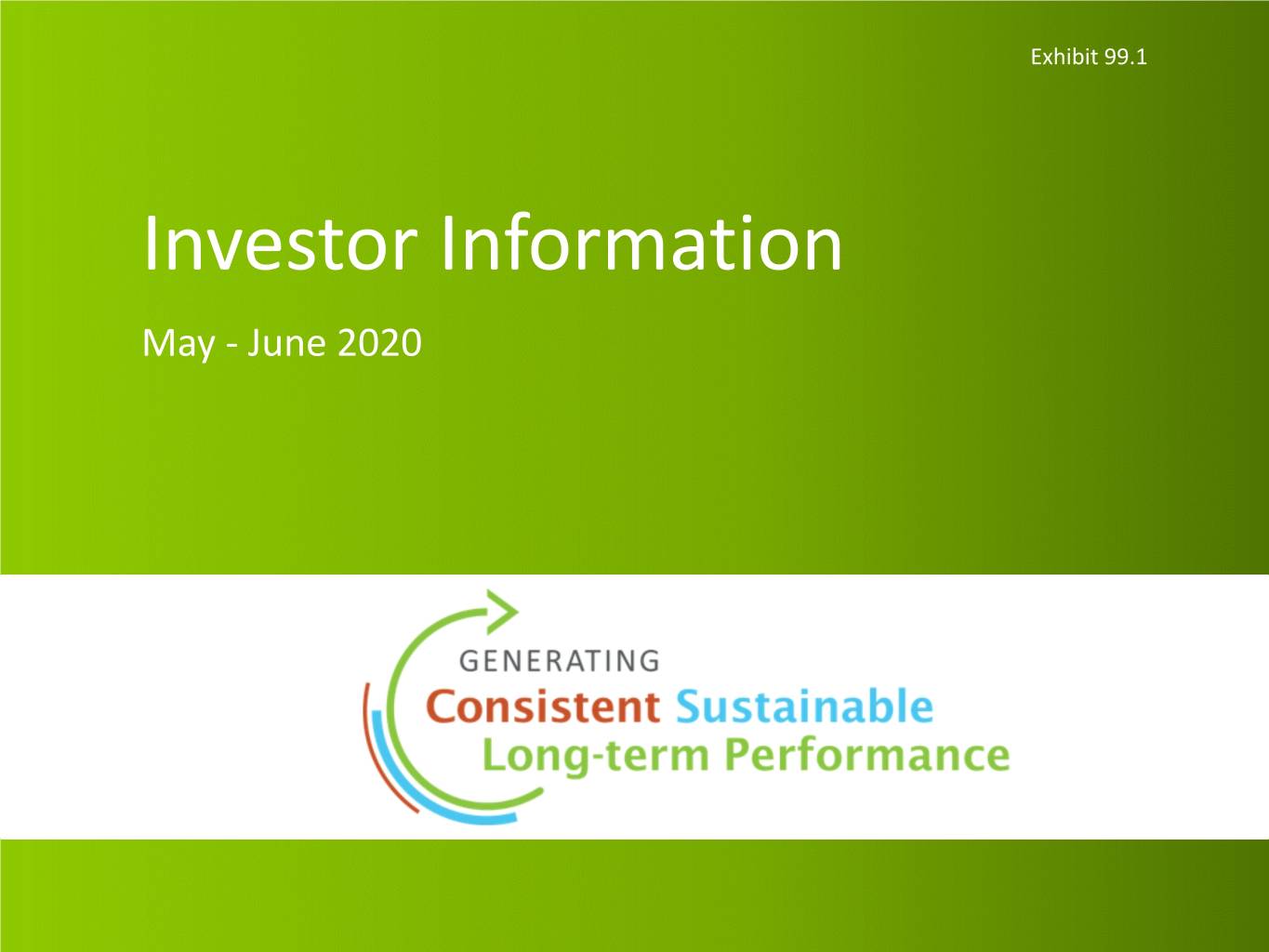
Exhibit 99.1 Investor Information May - June 2020
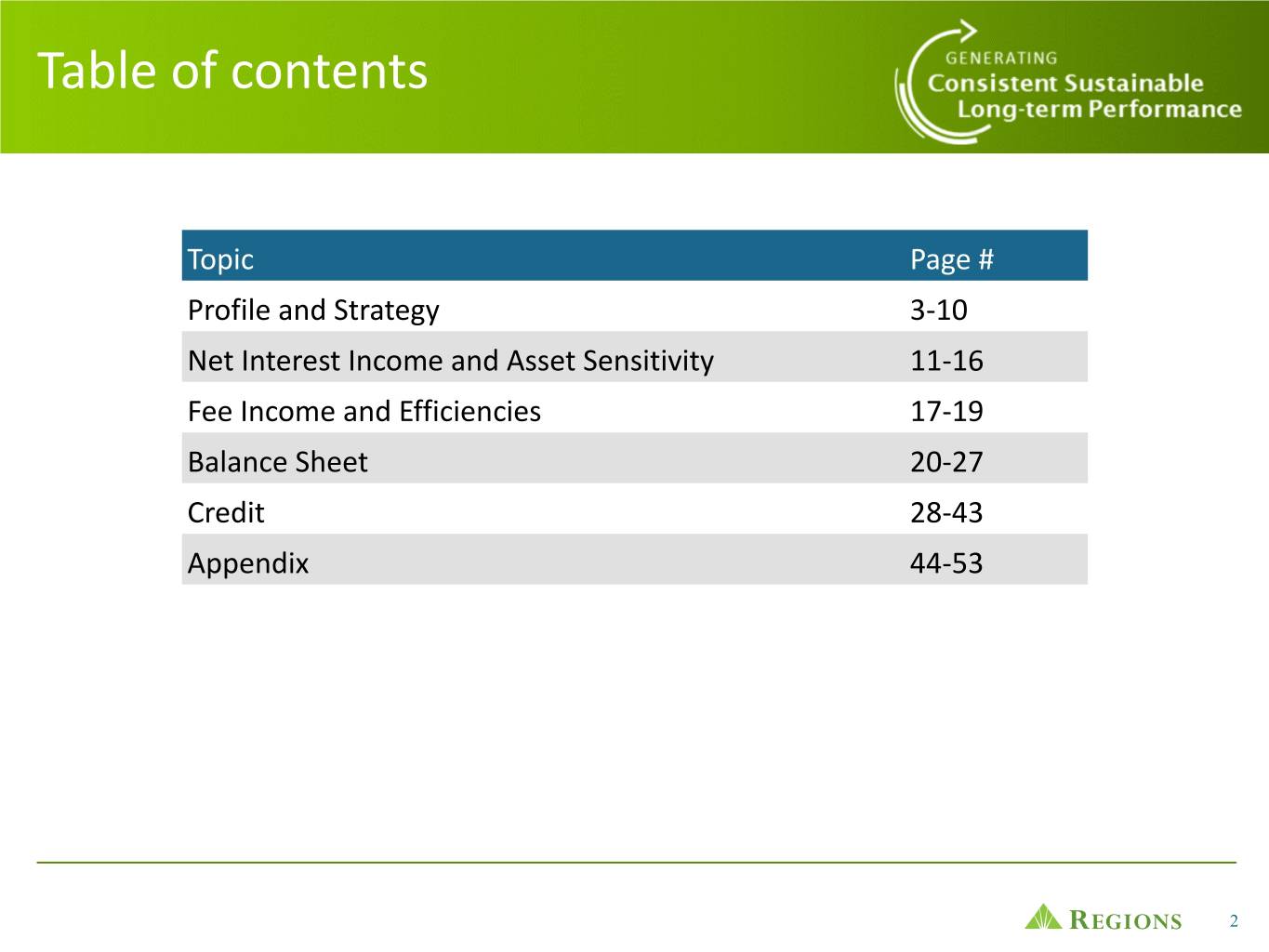
Table of contents Topic Page # Profile and Strategy 3-10 Net Interest Income and Asset Sensitivity 11-16 Fee Income and Efficiencies 17-19 Balance Sheet 20-27 Credit 28-43 Appendix 44-53 2
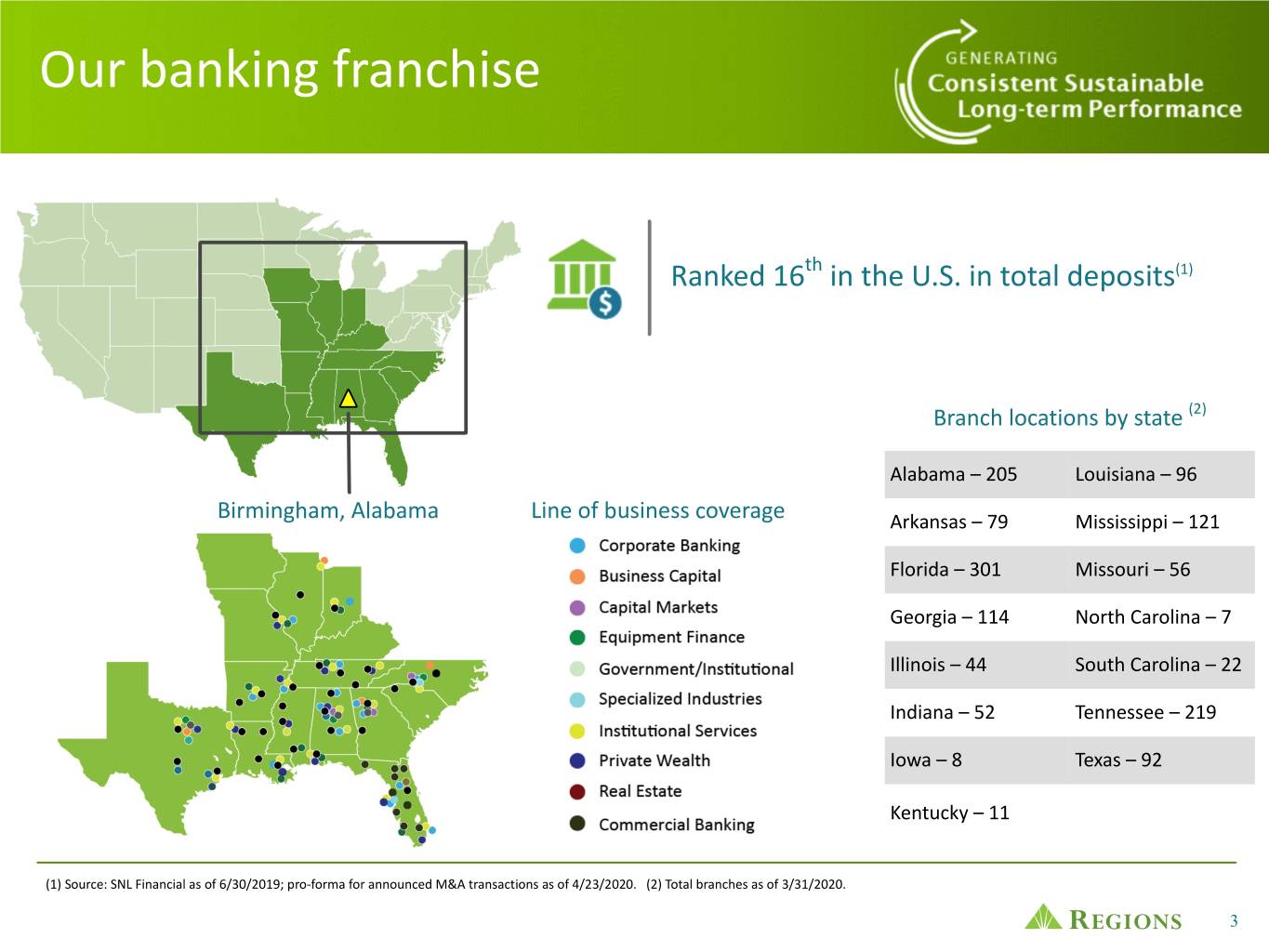
Our banking franchise Ranked 16th in the U.S. in total deposits(1) Branch locations by state (2) Alabama – 205 Louisiana – 96 Birmingham, Alabama Line of business coverage Arkansas – 79 Mississippi – 121 Florida – 301 Missouri – 56 Georgia – 114 North Carolina – 7 Illinois – 44 South Carolina – 22 Indiana – 52 Tennessee – 219 Iowa – 8 Texas – 92 Kentucky – 11 (1) Source: SNL Financial as of 6/30/2019; pro-forma for announced M&A transactions as of 4/23/2020. (2) Total branches as of 3/31/2020. 3
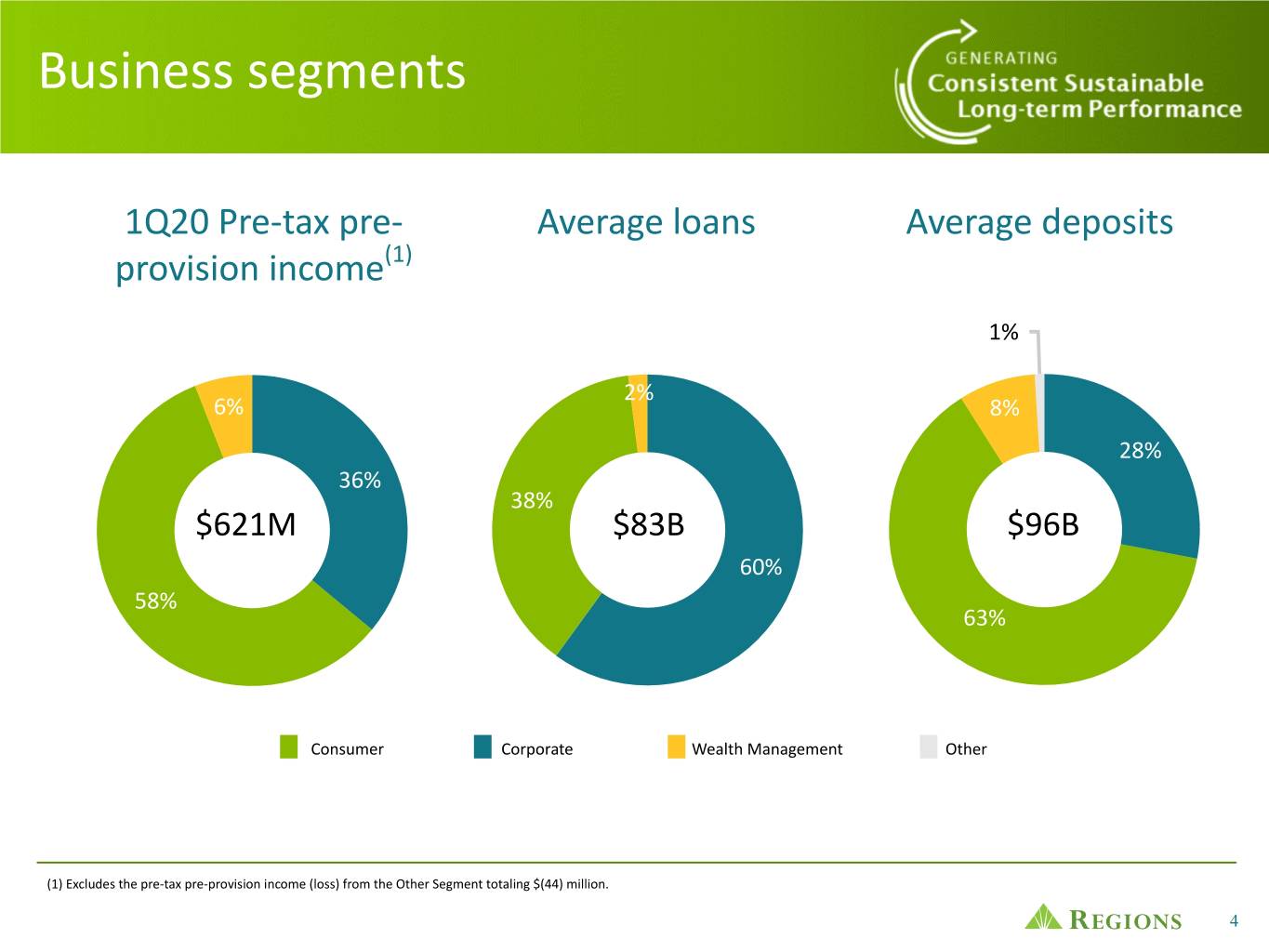
Business segments 1Q20 Pre-tax pre- Average loans Average deposits provision income(1) 1% 2% 6% 8% 28% 36% 38% $621M $83B $96B 60% 58% 63% Consumer Corporate Wealth Management Other (1) Excludes the pre-tax pre-provision income (loss) from the Other Segment totaling $(44) million. 4
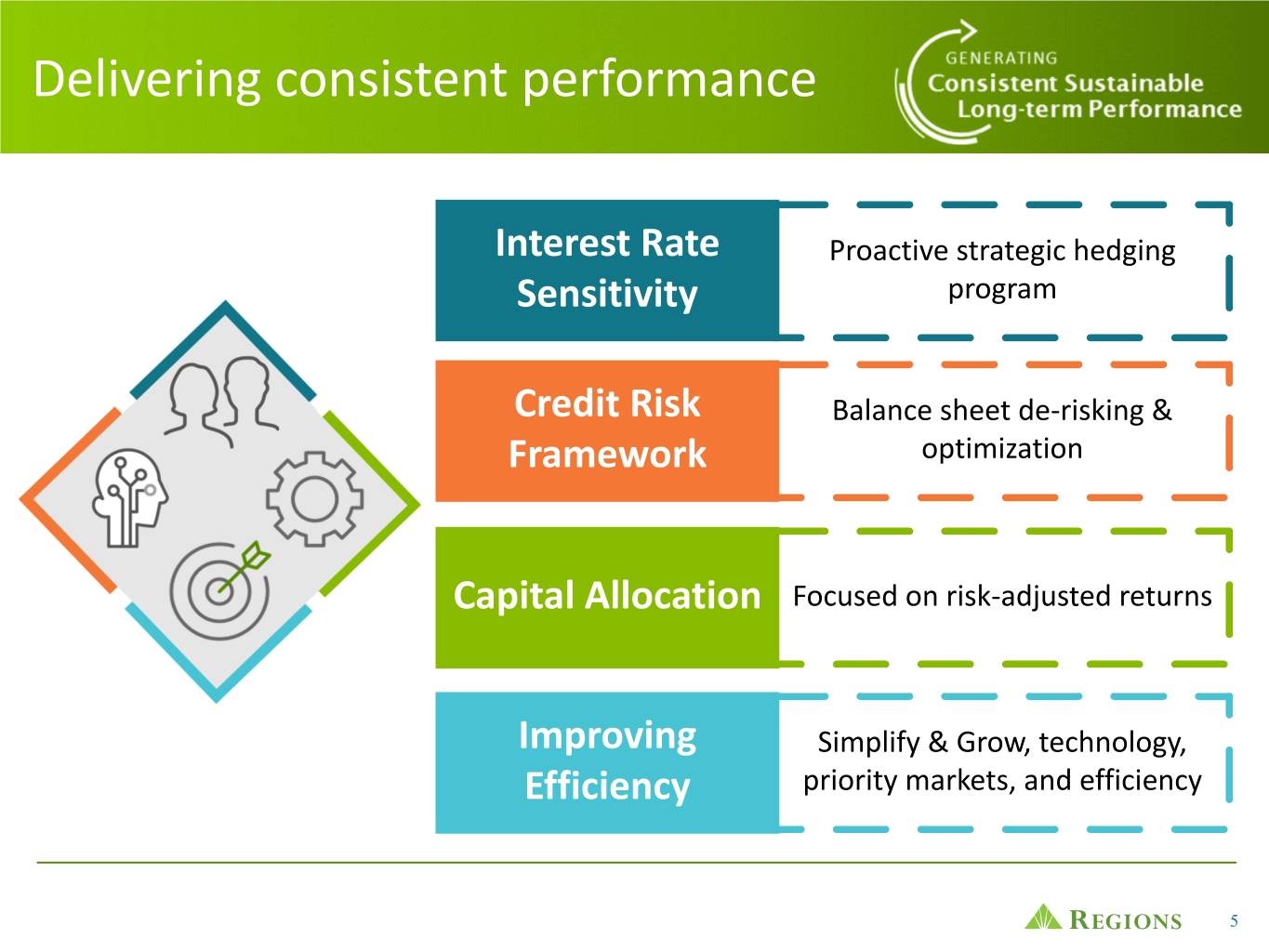
Delivering consistent performance Interest Rate Proactive strategic hedging Sensitivity program Credit Risk Balance sheet de-risking & Framework optimization Capital Allocation Focused on risk-adjusted returns Improving Simplify & Grow, technology, Efficiency priority markets, and efficiency 5
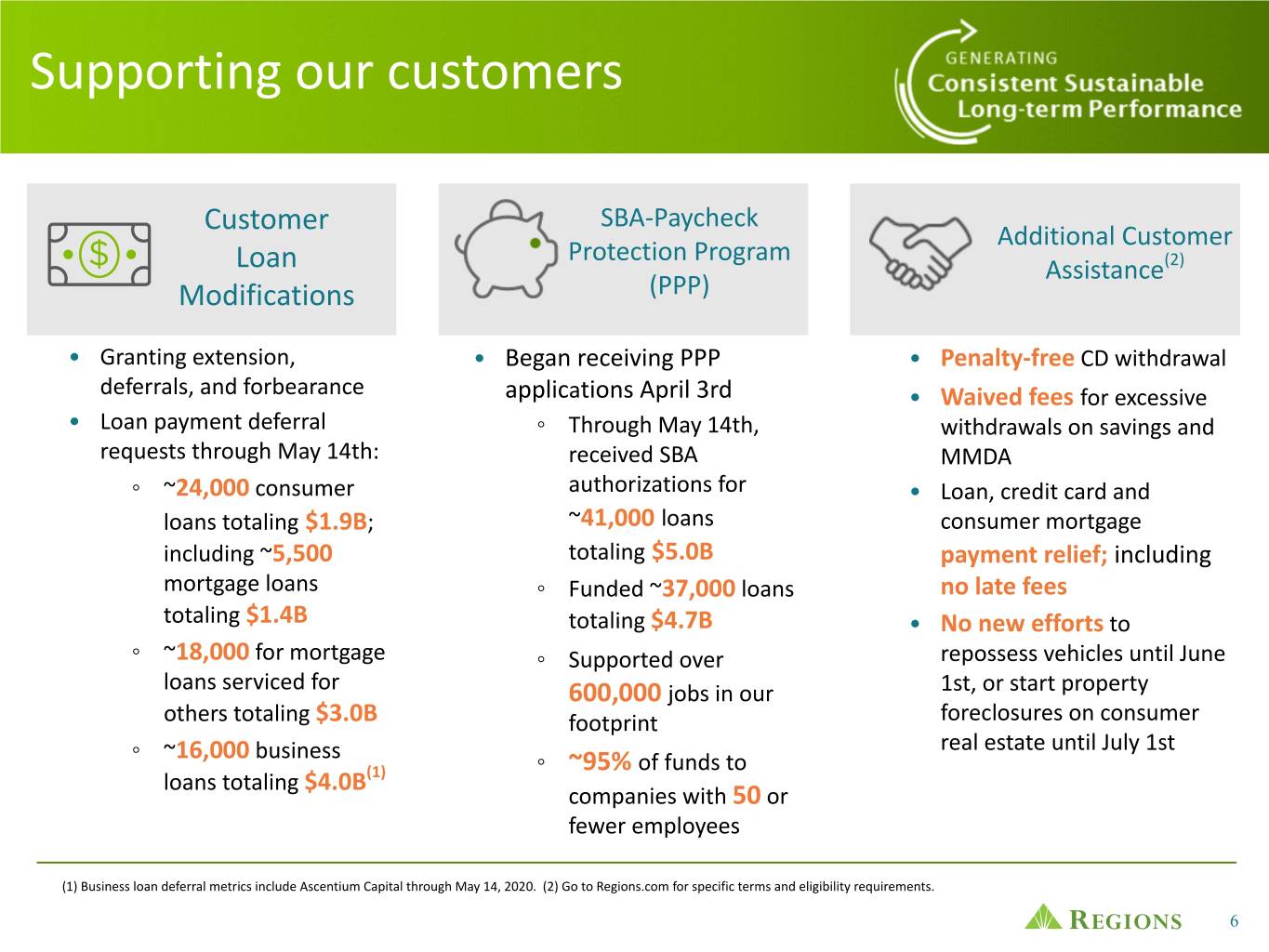
Supporting our customers Customer SBA-Paycheck Additional Customer Protection Program Loan Assistance(2) Modifications (PPP) • Granting extension, • Began receiving PPP • Penalty-free CD withdrawal deferrals, and forbearance applications April 3rd • Waived fees for excessive • Loan payment deferral ◦ Through May 14th, withdrawals on savings and requests through May 14th: received SBA MMDA ◦ ~24,000 consumer authorizations for • Loan, credit card and loans totaling $1.9B; ~41,000 loans consumer mortgage including ~5,500 totaling $5.0B payment relief; including mortgage loans ◦ Funded ~37,000 loans no late fees totaling $1.4B totaling $4.7B • No new efforts to ◦ ~18,000 for mortgage ◦ Supported over repossess vehicles until June loans serviced for 600,000 jobs in our 1st, or start property others totaling $3.0B footprint foreclosures on consumer ◦ real estate until July 1st ~16,000 business ◦ ~95% of funds to loans totaling $4.0B(1) companies with 50 or fewer employees (1) Business loan deferral metrics include Ascentium Capital through May 14, 2020. (2) Go to Regions.com for specific terms and eligibility requirements. 6
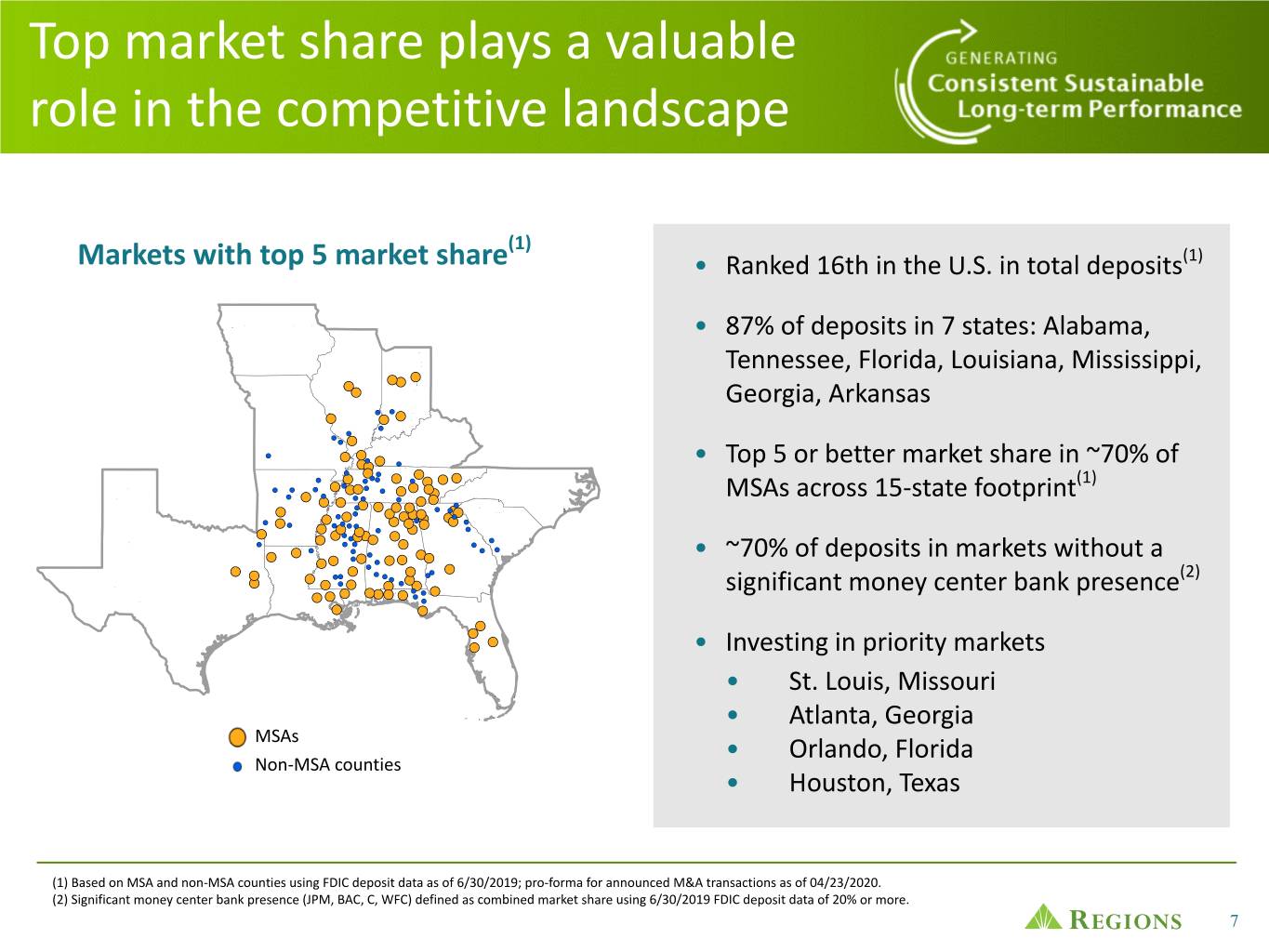
Top market share plays a valuable role in the competitive landscape (1) Markets with top 5 market share • Ranked 16th in the U.S. in total deposits(1) • 87% of deposits in 7 states: Alabama, Tennessee, Florida, Louisiana, Mississippi, Georgia, Arkansas • Top 5 or better market share in ~70% of MSAs across 15-state footprint(1) • ~70% of deposits in markets without a significant money center bank presence(2) • Investing in priority markets • St. Louis, Missouri • Atlanta, Georgia MSAs • Orlando, Florida Non-MSA counties • Houston, Texas (1) Based on MSA and non-MSA counties using FDIC deposit data as of 6/30/2019; pro-forma for announced M&A transactions as of 04/23/2020. (2) Significant money center bank presence (JPM, BAC, C, WFC) defined as combined market share using 6/30/2019 FDIC deposit data of 20% or more. 7
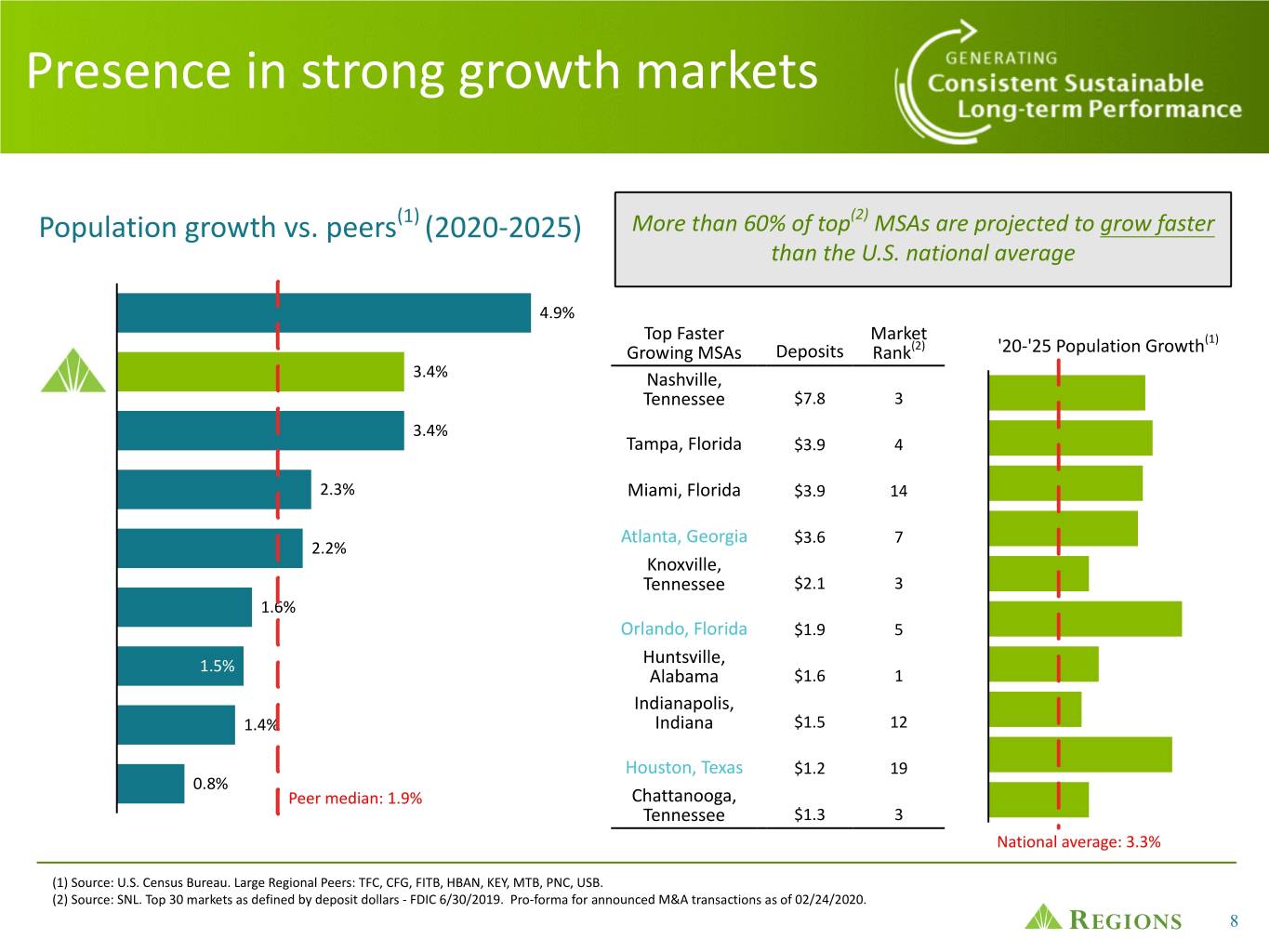
Presence in strong growth markets Population growth vs. peers(1) (2020-2025) More than 60% of top(2) MSAs are projected to grow faster than the U.S. national average Peer #1 4.9% Top Faster Market (1) Growing MSAs Deposits Rank(2) '20-'25 Population Growth RF 3.4% Nashville, Tennessee $7.8 3 Peer #2 3.4% Tampa, Florida $3.9 4 Peer #3 2.3% Miami, Florida $3.9 14 Atlanta, Georgia $3.6 7 Peer #4 2.2% Knoxville, Tennessee $2.1 3 Peer #5 1.6% Orlando, Florida $1.9 5 Peer #6 1.5% Huntsville, Alabama $1.6 1 Indianapolis, Peer #7 1.4% Indiana $1.5 12 Houston, Texas $1.2 19 Peer #8 0.8% Peer median: 1.9% Chattanooga, Tennessee $1.3 3 National average: 3.3% (1) Source: U.S. Census Bureau. Large Regional Peers: TFC, CFG, FITB, HBAN, KEY, MTB, PNC, USB. (2) Source: SNL. Top 30 markets as defined by deposit dollars - FDIC 6/30/2019. Pro-forma for announced M&A transactions as of 02/24/2020. 8
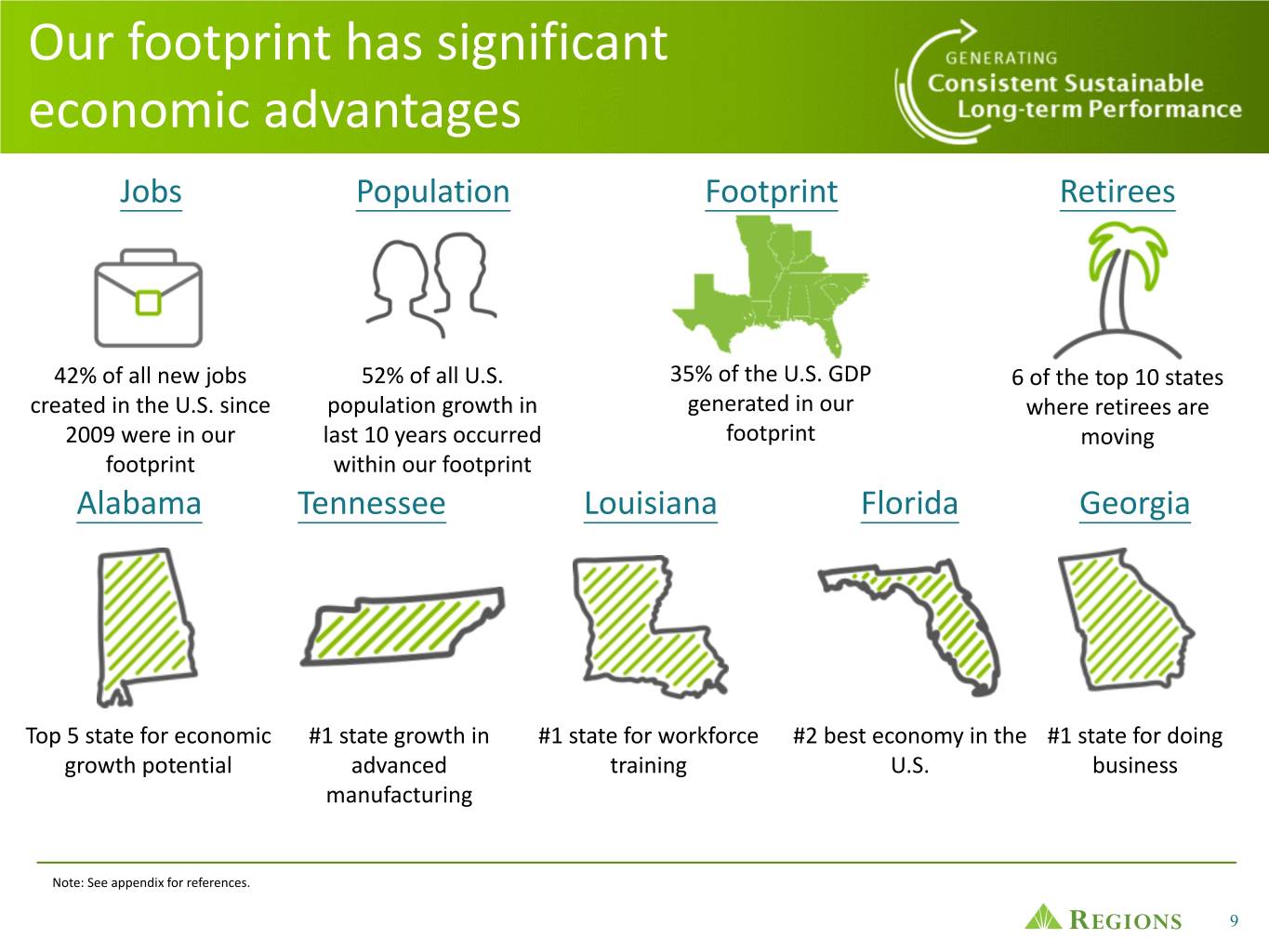
Our footprint has significant economic advantages Jobs Population Footprint Retirees 42% of all new jobs 52% of all U.S. 35% of the U.S. GDP 6 of the top 10 states created in the U.S. since population growth in generated in our where retirees are 2009 were in our last 10 years occurred footprint moving footprint within our footprint Alabama Tennessee Louisiana Florida Georgia Top 5 state for economic #1 state growth in #1 state for workforce #2 best economy in the #1 state for doing growth potential advanced training U.S. business manufacturing Note: See appendix for references. 9
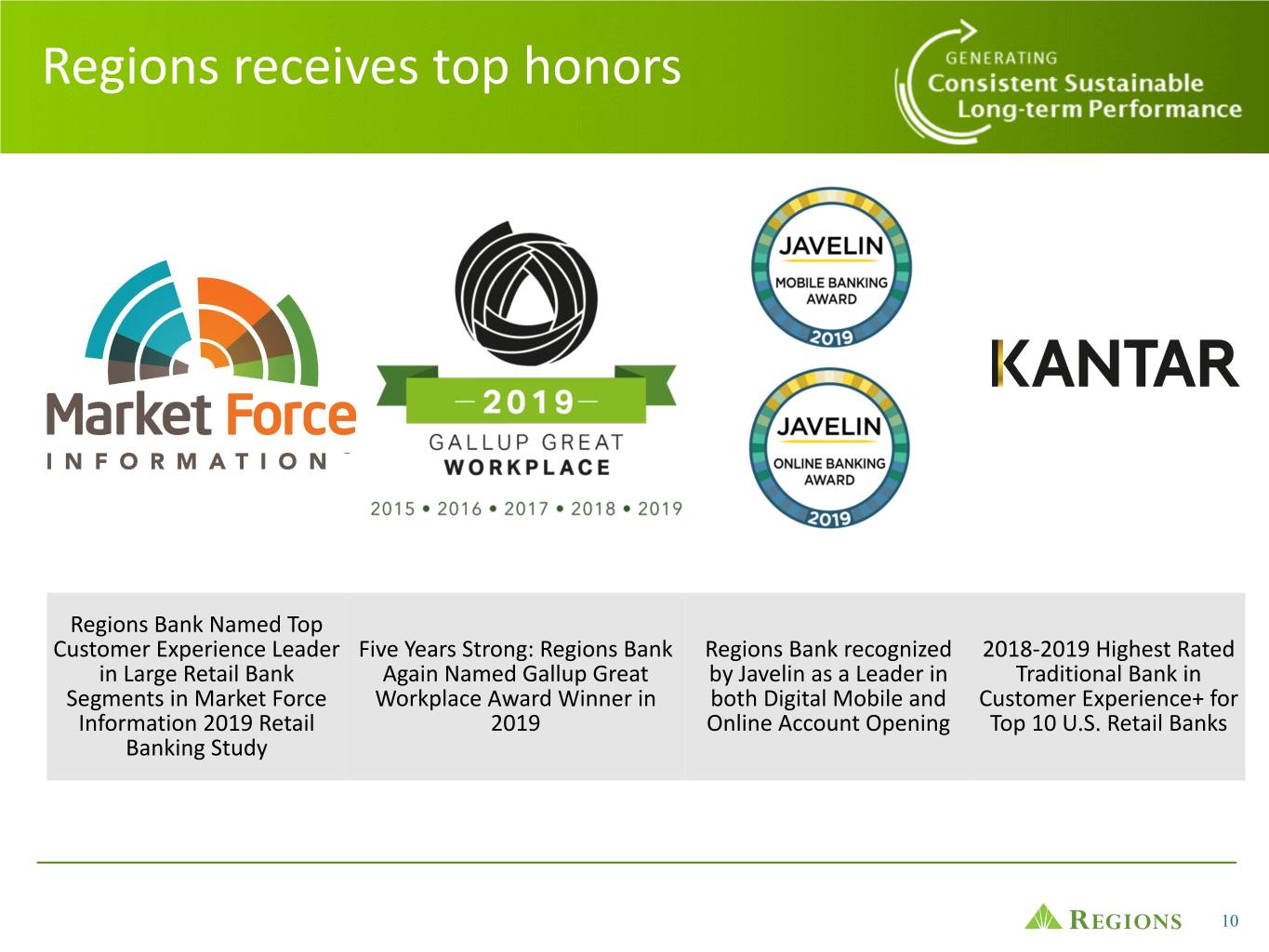
Regions receives top honors Regions Bank Named Top Customer Experience Leader Five Years Strong: Regions Bank Regions Bank recognized 2018-2019 Highest Rated in Large Retail Bank Again Named Gallup Great by Javelin as a Leader in Traditional Bank in Segments in Market Force Workplace Award Winner in both Digital Mobile and Customer Experience+ for Information 2019 Retail 2019 Online Account Opening Top 10 U.S. Retail Banks Banking Study 10

Focused on earnings stability through the cycle NII(1) and NIM NIM Performance vs Peers ($ in millions) 3.6 3.49% 3.52% 3.45% $961 3.5 3.44% $931 $940 3.37% 3.39% 3.36% 3.39% 3.4 3.32% 3.3 3.35% 3.26% 3.51% 3.34% 3.44% 3.2 3.16% 3.27% 3.29% 3.16% 3.39% 3.22% 3.1 3.14% 3.04% 3.10% 3.0 RF Peer Median (Reported)(3) Peer Median (Core)(3) 2.9 6 7 7 7 7 8 8 8 8 9 9 9 9 0 1Q19 4Q19 1Q20 1 1 1 1 1 1 1 1 1 1 1 1 1 2 4 1 2 3 4 1 2 3 4 1 2 3 4 1 NII(1) NIM Q Q Q Q Q Q Q Q Q Q Q Q Q Q • Net interest income and net interest margin protected in • Assuming rate environment persists(4), expect 2Q20 NII 0% short-term rate environment by: growth of +3.5% to +4.5% and NIM decline of between -20 ◦ $22.75B loan hedging program – $1.9B unrealized to -25 basis points vs. 1Q20 (including PPP) pre-tax gain(2) as of May 11th ◦ Near-term NIM pressure due primarily to excess ◦ Deposit pricing advantage – cumulative falling rate balance sheet liquidity in the form of cash and beta 25-30% elevated low spread loans (commercial line draws and PPP) • Residual exposure to long-term rates: ◦ Ascentium expected to add 8-10bps NIM ◦ ~$13.5B annual fixed rate loan/securities production ◦ Paycheck Protection Program (PPP) modestly dilutive ◦ Premium amortization – book premium reduced to NIM in 2Q, as deferred fees not expected to have ~32% since 2016 a significant impact until 2H20 (1) Net interest income on a fully taxable equivalent basis. (2) Hedges remain active; gain held in OCI, to be amortized into NII over the remaining life of hedges ~5 years. (3) Source: SEC reporting; peers include BBT, CFG, CMA, FHN, FITB, HBAN, HWC, KEY, MTB, PNC, SNV, STI, USB, ZION, TFC. Peer median (core) utilizes self-reported core margins for peers with purchase accounting adjustments (TFC, FITB, FHN, HBAN, KEY, SNV). (4) Assumes Fed Funds Target remains 0-0.25%, LIBOR reverts to normal 11 relationship with Fed Funds, and 10 year U.S. Treasury yield is range-bound between 0.50% - 0.90%.
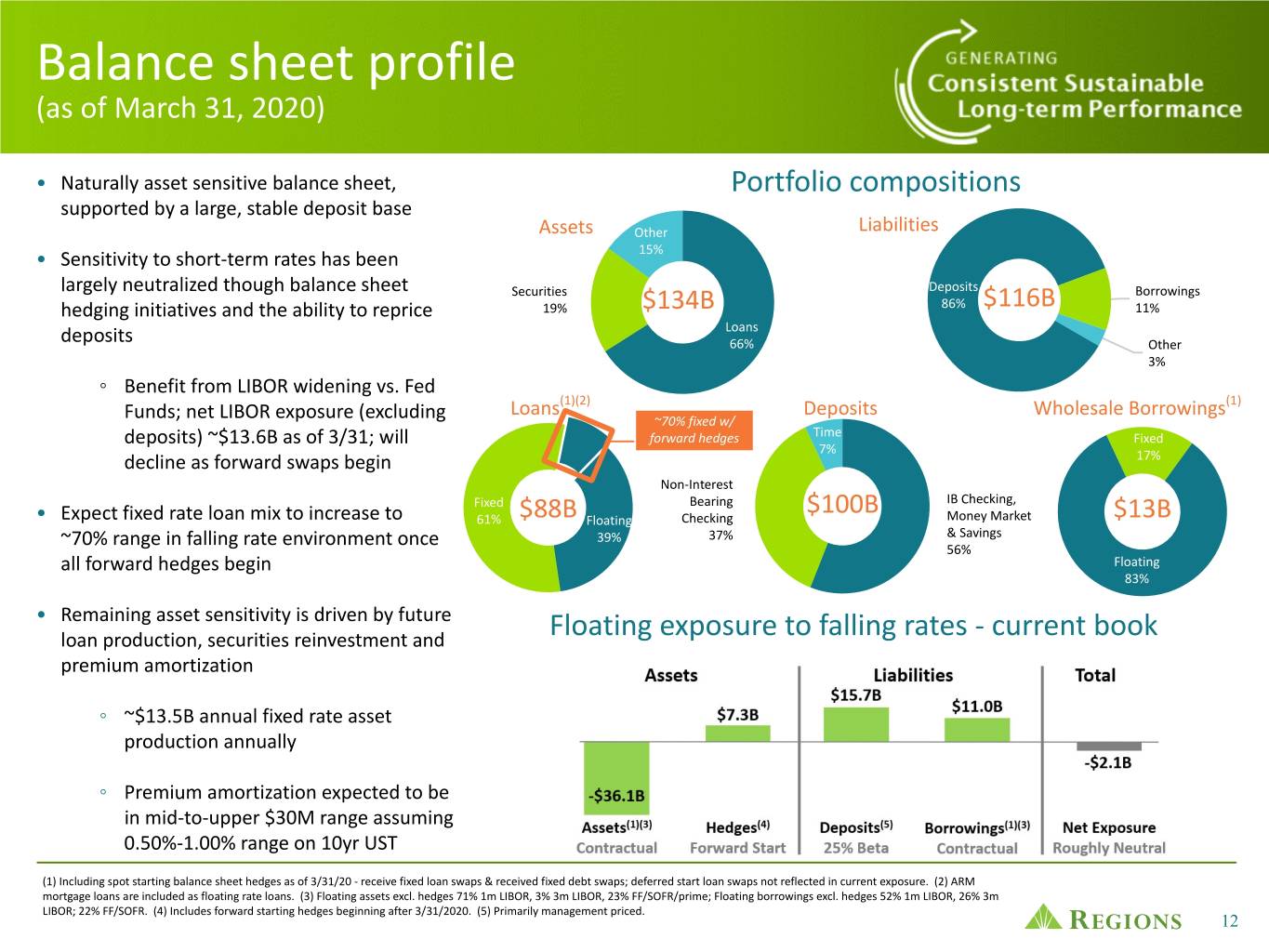
Balance sheet profile (as of March 31, 2020) • Naturally asset sensitive balance sheet, Portfolio compositions supported by a large, stable deposit base Assets Other Liabilities • Sensitivity to short-term rates has been 15% largely neutralized though balance sheet Securities Deposits Borrowings hedging initiatives and the ability to reprice 19% $134B 86% $116B 11% Loans deposits 66% Other 3% ◦ Benefit from LIBOR widening vs. Fed Loans(1)(2) Deposits Wholesale Borrowings(1) Funds; net LIBOR exposure (excluding ~70% fixed w/ deposits) ~$13.6B as of 3/31; will forward hedges Time Fixed 7% decline as forward swaps begin 17% Non-Interest Fixed Bearing $100B IB Checking, • Expect fixed rate loan mix to increase to 61% $88B Floating Checking Money Market $13B ~70% range in falling rate environment once 39% 37% & Savings 56% all forward hedges begin Floating 83% • Remaining asset sensitivity is driven by future loan production, securities reinvestment and Floating exposure to falling rates - current book premium amortization ◦ ~$13.5B annual fixed rate asset production annually ◦ Premium amortization expected to be in mid-to-upper $30M range assuming 0.50%-1.00% range on 10yr UST (1) Including spot starting balance sheet hedges as of 3/31/20 - receive fixed loan swaps & received fixed debt swaps; deferred start loan swaps not reflected in current exposure. (2) ARM mortgage loans are included as floating rate loans. (3) Floating assets excl. hedges 71% 1m LIBOR, 3% 3m LIBOR, 23% FF/SOFR/prime; Floating borrowings excl. hedges 52% 1m LIBOR, 26% 3m LIBOR; 22% FF/SOFR. (4) Includes forward starting hedges beginning after 3/31/2020. (5) Primarily management priced. 12
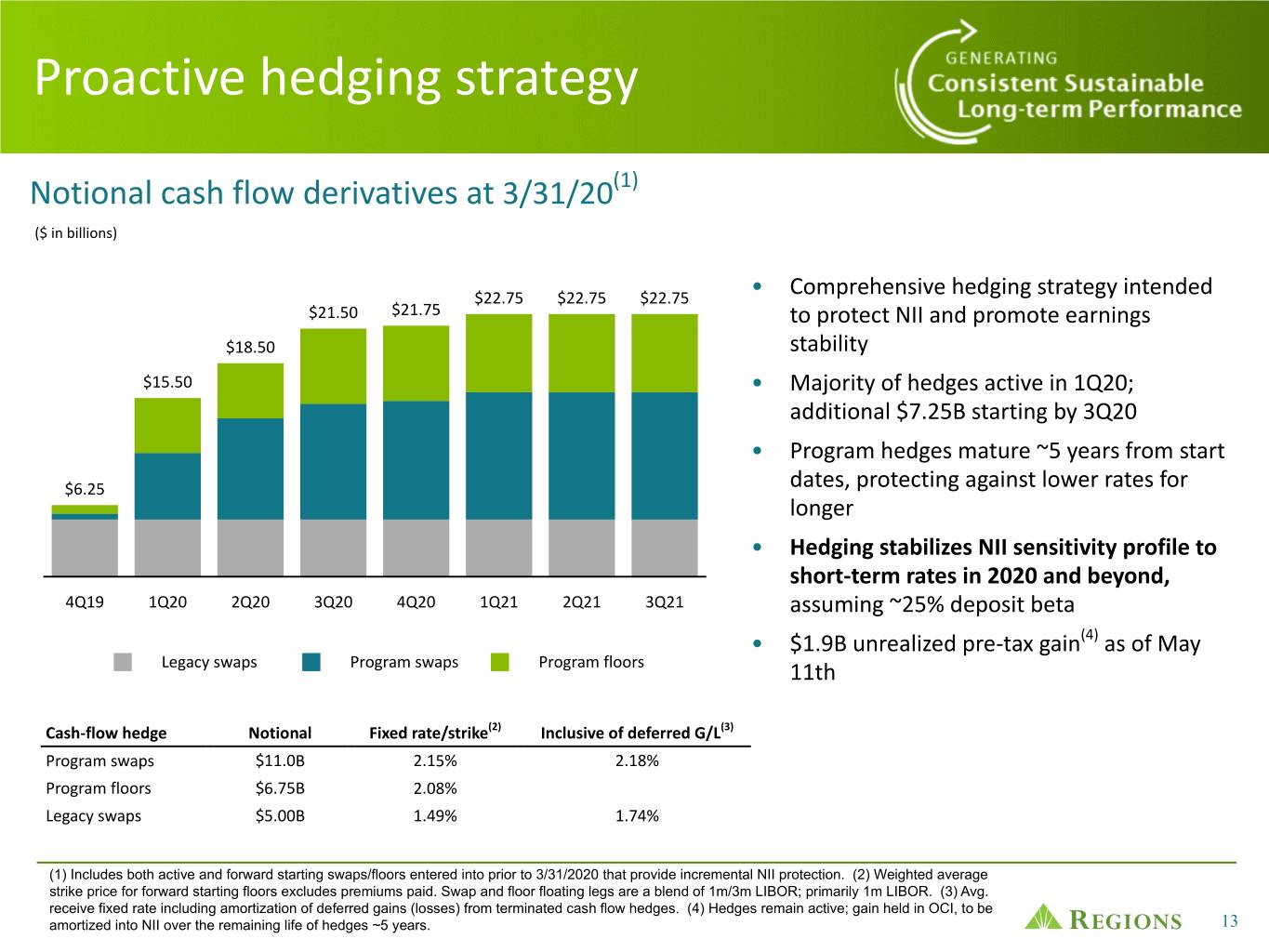
Proactive hedging strategy Notional cash flow derivatives at 3/31/20(1) ($ in billions) $22.75 $22.75 $22.75 • Comprehensive hedging strategy intended $21.50 $21.75 to protect NII and promote earnings $18.50 stability $15.50 • Majority of hedges active in 1Q20; additional $7.25B starting by 3Q20 • Program hedges mature ~5 years from start $6.25 dates, protecting against lower rates for longer • Hedging stabilizes NII sensitivity profile to short-term rates in 2020 and beyond, 4Q19 1Q20 2Q20 3Q20 4Q20 1Q21 2Q21 3Q21 assuming ~25% deposit beta • $1.9B unrealized pre-tax gain(4) as of May Legacy swaps Program swaps Program floors 11th Cash-flow hedge Notional Fixed rate/strike(2) Inclusive of deferred G/L(3) Program swaps $11.0B 2.15% 2.18% Program floors $6.75B 2.08% Legacy swaps $5.00B 1.49% 1.74% (1) Includes both active and forward starting swaps/floors entered into prior to 3/31/2020 that provide incremental NII protection. (2) Weighted average strike price for forward starting floors excludes premiums paid. Swap and floor floating legs are a blend of 1m/3m LIBOR; primarily 1m LIBOR. (3) Avg. receive fixed rate including amortization of deferred gains (losses) from terminated cash flow hedges. (4) Hedges remain active; gain held in OCI, to be amortized into NII over the remaining life of hedges ~5 years. 13

Significant down-side market rate protection Securities and hedges(1) as % of earning assets(2) Change in AOCI / earning assets 1Q20 vs 1Q19(2) 50% 200 40% 150 30% Peer Median 27% 20% 100 Peer Median 64bps 10% basis points 50 0% F 1 2 4 7 8 3 6 9 5 0 2 1 0 F 1 2 3 4 5 6 7 8 9 -10% 0 1 2 R 1 1 1 r r r r r r r r r R 1 1 1 r r r r r r r r r e e e e e e e e e r r r e e e e e e e e e r r r e e e e e e e e e e e e e e e e e e e e e e e e P P P P P P P P P e e e P P P P P P P P P e e e P P P P P P Securities Cash Flow Hedges Change in Hedge AOCI / Earning Assets Change in Securities AOCI / Earning Assets • Regions' fixed rate asset protection among the Normalized(3) NII change: 1Q20 vs 2Q19(2) highest in the peer group 5% 0% • Regions has longer duration hedging, evidenced by a larger increase in market value for 1Q20 YoY; -5% protects if rates stay lower for longer -10% -15% • In the falling rate cycle to date, Regions' NII has been F 6 9 4 8 1 7 2 3 5 -20% 1 0 2 R 1 1 1 r r r r r r r r r e e e e e e e e e more stable than peers, normalizing for asset growth r r r e e e e e e e e e e e e P P P P P P P P P e e e P P P (1) Forward hedges excluded for particular banks where forward starting hedges replace current notional and are not additive to protection amount. (2) Uses EOP 1Q20 data latest available when published; Source: SNL Financial, SEC Reporting; Peers include CFG, CMA, FHN, FITB, HBAN, HWC, KEY, MTB, PNC, SNV, USB, ZION; TFC excluded given M&A noise. (3) Change in NII normalized for earning asset growth; earning asset growth backed out at 2.25% 14 spread for all peers.
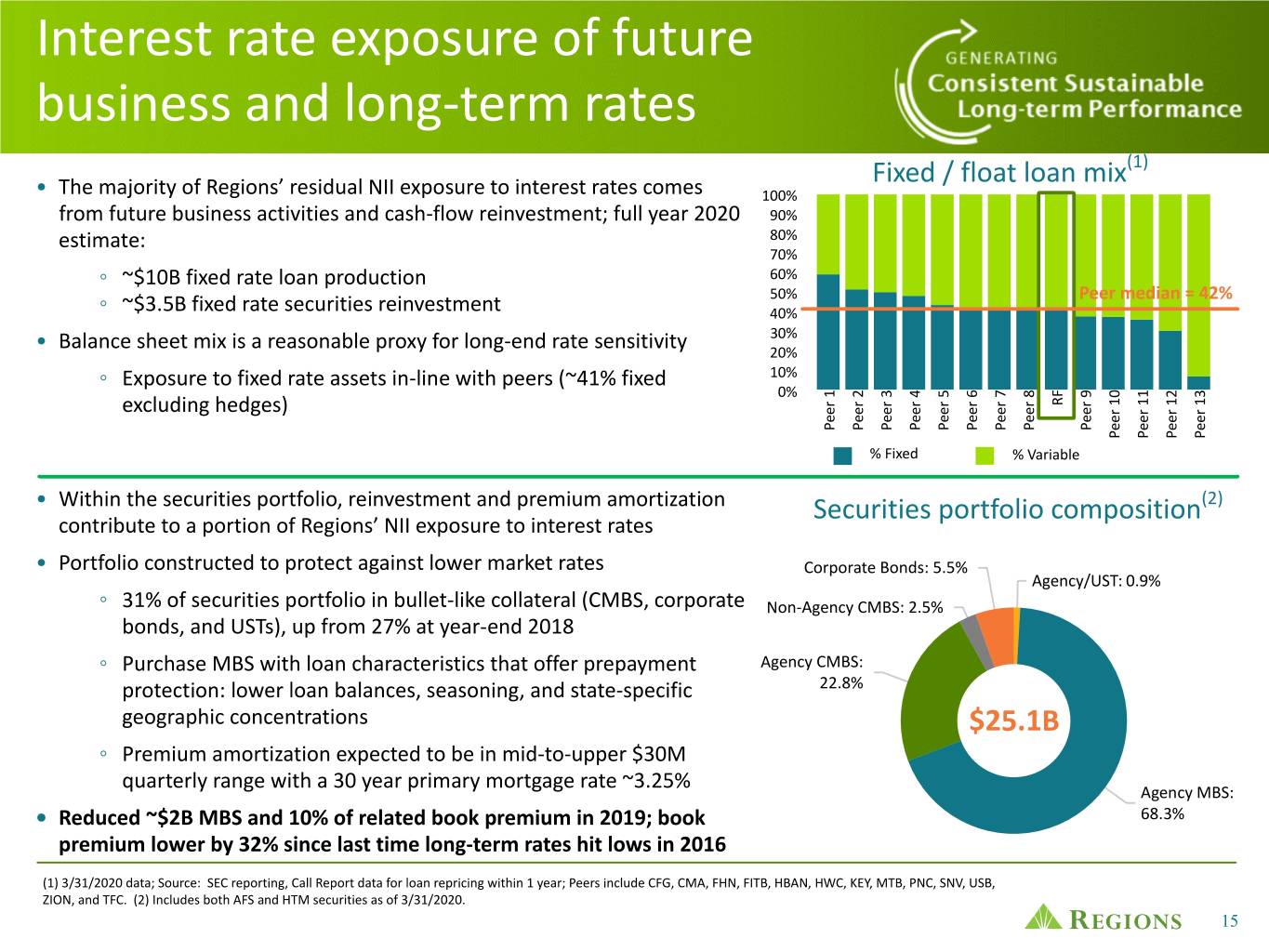
Interest rate exposure of future business and long-term rates Fixed / float loan mix(1) • The majority of Regions’ residual NII exposure to interest rates comes 100% from future business activities and cash-flow reinvestment; full year 2020 90% estimate: 80% 70% ◦ ~$10B fixed rate loan production 60% 50% Peer median = 42% ◦ ~$3.5B fixed rate securities reinvestment 40% 30% • Balance sheet mix is a reasonable proxy for long-end rate sensitivity 20% ◦ Exposure to fixed rate assets in-line with peers (~41% fixed 10% F 0 1 2 3 0% 1 2 3 4 5 6 7 8 9 R 1 1 1 1 r r r r r r r r r e e e e e e e e e excluding hedges) r r r r e e e e e e e e e e e e e P P P P P P P P P e e e e P P P P % Fixed % Variable • Within the securities portfolio, reinvestment and premium amortization Securities portfolio composition(2) contribute to a portion of Regions’ NII exposure to interest rates • Portfolio constructed to protect against lower market rates Corporate Bonds: 5.5% Agency/UST: 0.9% ◦ 31% of securities portfolio in bullet-like collateral (CMBS, corporate Non-Agency CMBS: 2.5% bonds, and USTs), up from 27% at year-end 2018 ◦ Purchase MBS with loan characteristics that offer prepayment Agency CMBS: protection: lower loan balances, seasoning, and state-specific 22.8% geographic concentrations $25.1B ◦ Premium amortization expected to be in mid-to-upper $30M quarterly range with a 30 year primary mortgage rate ~3.25% Agency MBS: • Reduced ~$2B MBS and 10% of related book premium in 2019; book 68.3% premium lower by 32% since last time long-term rates hit lows in 2016 (1) 3/31/2020 data; Source: SEC reporting, Call Report data for loan repricing within 1 year; Peers include CFG, CMA, FHN, FITB, HBAN, HWC, KEY, MTB, PNC, SNV, USB, ZION, and TFC. (2) Includes both AFS and HTM securities as of 3/31/2020. 15

Deposit advantage Expected to continue (1) Deposit costs Deposit costs RF 35bps Peer 1 36bps Peer 2 40bps 0.53% Peer 3 43bps 0.49% Peer 4 51bps 0.46% Peer 5 51bps 0.41% Peer 6 52bps 0.35% Peer 7 53bps Peer 8 58bps Peer 9 61bps 0.17% Peer 10 65bps Peer 11 66bps Peer 12 72bps 1Q19 2Q19 3Q19 4Q19 1Q20 April '20 Peer 13 89bps Deposit characteristics provide a funding advantage.... • Retail deposits represent ~70% of total deposits • Regions’ deposit costs are the lowest in the peer group • Highest proportion of stable retail deposits of peers that disclose LCR characteristics ◦ Total deposits: 35bps vs 53bps peer median • Favorable mix of low cost products – 36% avg. non-interest ◦ Interest-bearing: 55bps vs 73bps peer median bearing vs 26% peer median ◦ Falling rate beta: 25%, similar pace to peers • Over 60% of consumer deposits are held by customers who have banked at Regions for over 10 years • Expect falling rate beta to be similar to what was • Over 90% of consumer checking households include a high experienced under rising rates quality primary checking account(2) • Deposit yields expect to revert to near-historical • Focused on acquiring more granular operating accounts; minimums in coming quarters over 90% of consumer deposits are insured by the FDIC (1) 1Q20 data; Source: SNL Financial; Peers include CFG, CMA, FHN, FITB, HBAN, HWC, KEY, MTB, PNC, SNV, USB, ZION, TFC. (2) High quality and primary account estimates are based on multiple individual account behaviors and activities (e.g., balances and transaction levels). 16
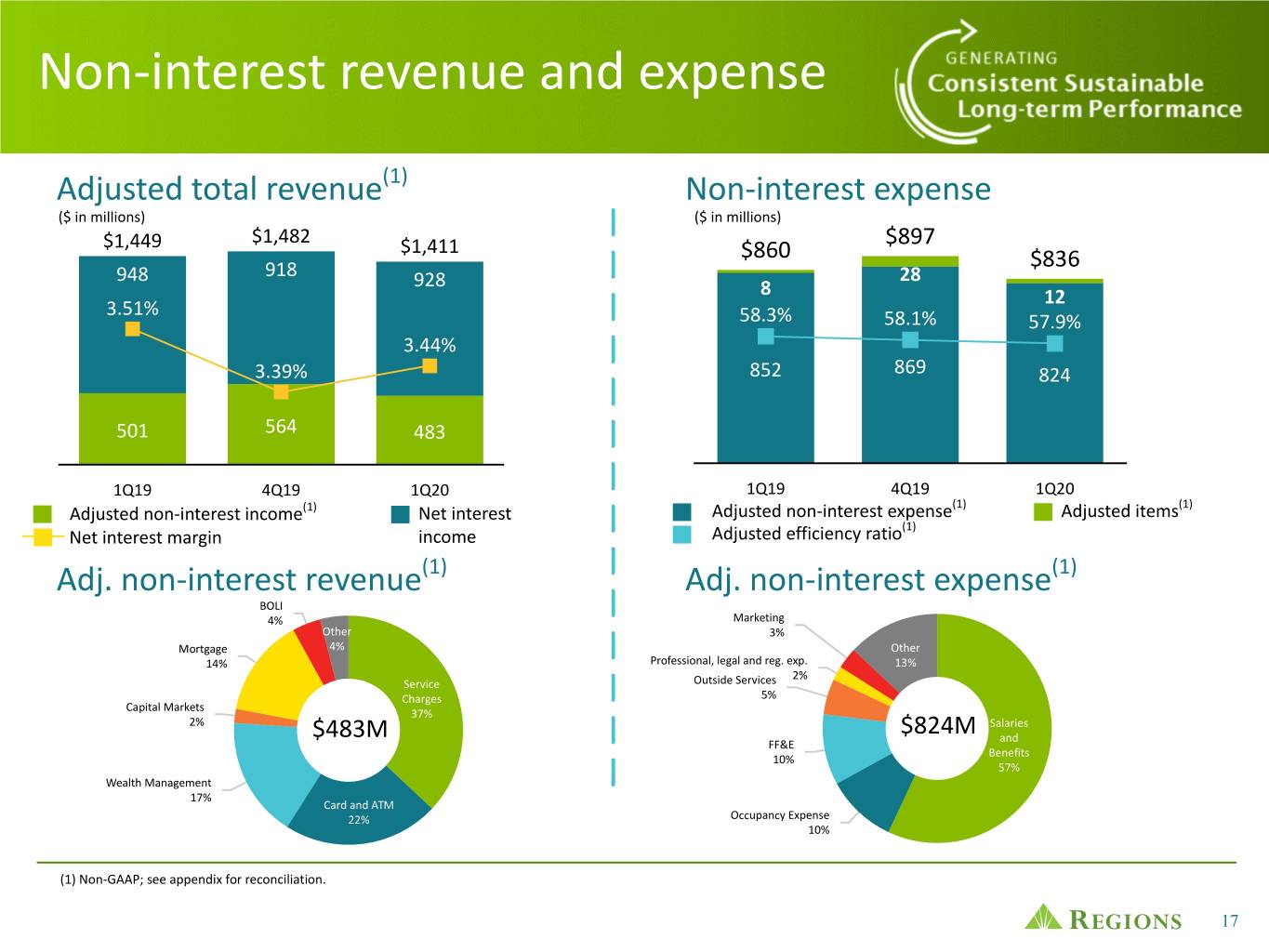
Non-interest revenue and expense Adjusted total revenue(1) Non-interest expense ($ in millions) ($ in millions) $1,449 $1,482 $1,411 $897 $860 $836 948 918 928 28 8 12 3.51% 58.3% 58.1% 57.9% 3.44% 3.39% 852 869 824 501 564 483 1Q19 4Q19 1Q20 1Q19 4Q19 1Q20 (1) (1) Adjusted non-interest income(1) Net interest Adjusted non-interest expense Adjusted items (1) Net interest margin income Adjusted efficiency ratio Adj. non-interest revenue(1) Adj. non-interest expense(1) BOLI 4% Marketing Other 3% Mortgage 4% Other 14% Professional, legal and reg. exp. 13% 2% Service Outside Services Charges 5% Capital Markets 37% 2% Salaries $483M $824M and FF&E Benefits 10% 57% Wealth Management 17% Card and ATM 22% Occupancy Expense 10% (1) Non-GAAP; see appendix for reconciliation. 17

Diversified non-interest revenue (1) Consumer 1Q20 fee revenue by segment • Consumer fee income categories are an important component of ($ in millions) fee revenue and are expected to contribute to overall growth • Service charges and card and ATM fees were negatively impacted by COVID-19 shelter-in-place orders; if spend and transaction volumes experienced the last week of March continue, expect combined revenues will be down $20-$25M/month from pre- Corporate March levels $104 Wealth • Acquired Highland Associates in 2019; leading institutional investments firm to NFP healthcare entities and mission-based Wealth organizations $87 Consumer $315 • Fees remained stable QoQ despite client asset values beginning to come under pressure; as asset prices reduce, expect pressure on segment revenues Corporate • Record customer derivatives income was offset by elevated CVA adjustments in 1Q; all other categories decreased reflecting impacts of COVID-19 on economic activity • Treasury management was also down in 1Q reflecting impacts of COVID-19 on economic activity; business card revenues decreased consistent with lower business travel (1) Excludes Other Segment fee revenue of $(21) million in 1Q20. 18

Continuous improvement initiatives delivering solid results Simplify & Grow initiative tracker Simplify & Grow expense initiatives (% represents $ of savings) Initiatives Total Initiatives to be number of All others complete completed initiatives Top 6-10 to Revenue 6 21 27 be completed 3% Organizational efficiency, 7% effectiveness & simplification 16 9 25 Third-party spend reductions 10 11 21 Total initiatives 32 41 73 50% Already completed Top 5 to be 40% • Regions' continuous improvement strategic initiative completed is focused on making banking easier, driving revenue growth, and improving efficiency and effectiveness • 32 of 73 planned Simplify & Grow initiatives have been completed through 3/31/2020 • 63% of the total planned initiatives are expense related • 26 of the 32 completed initiatives targeted expenses, reiterating Regions' commitment to focus on what we can control Note: data through 1Q20. 19
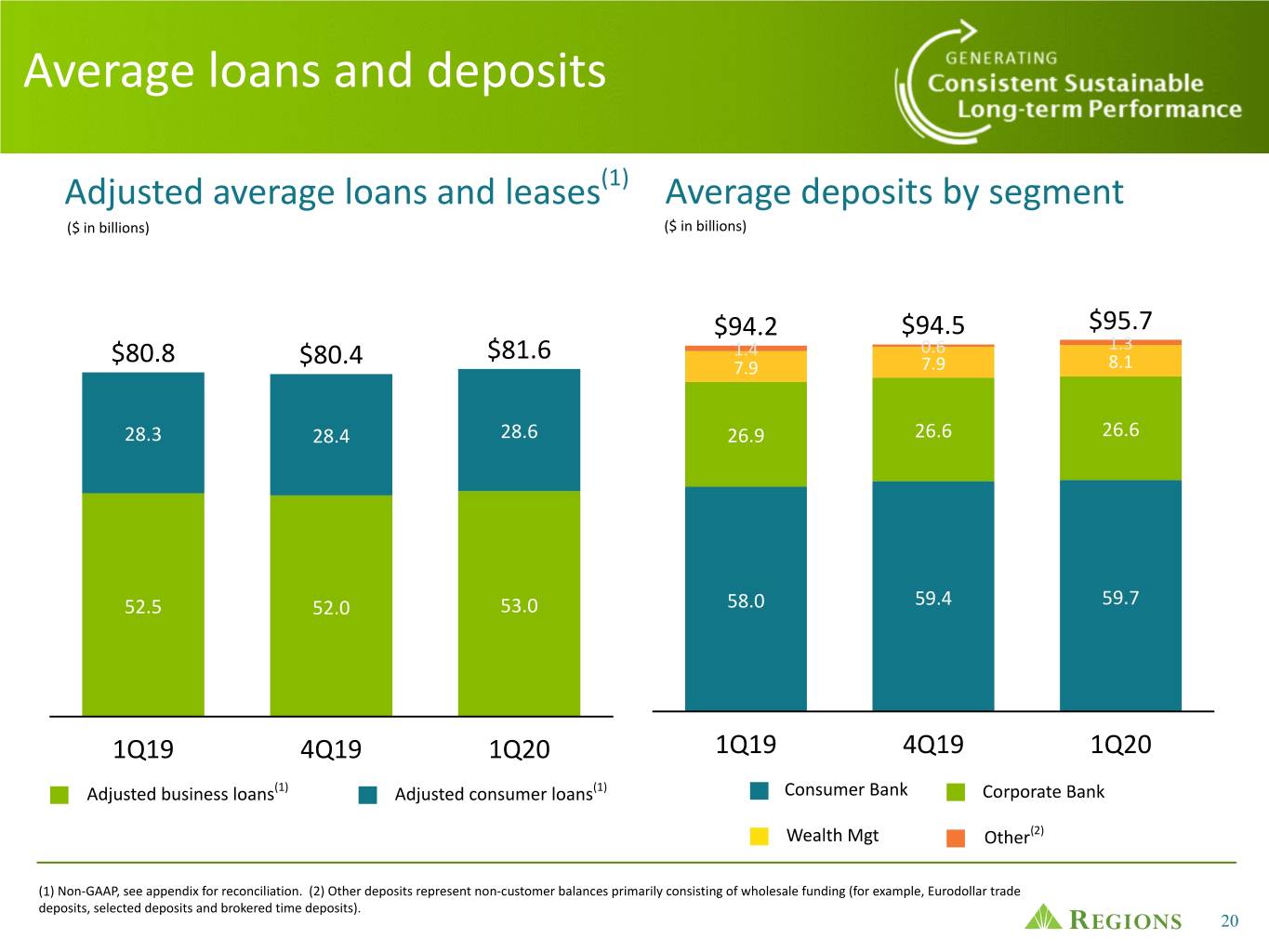
Average loans and deposits Adjusted average loans and leases(1) Average deposits by segment ($ in billions) ($ in billions) $94.2 $94.5 $95.7 $80.8 $81.6 1.4 0.6 1.3 $80.4 7.9 7.9 8.1 28.3 28.4 28.6 26.9 26.6 26.6 52.5 52.0 53.0 58.0 59.4 59.7 1Q19 4Q19 1Q20 1Q19 4Q19 1Q20 Adjusted business loans(1) Adjusted consumer loans(1) Consumer Bank Corporate Bank Wealth Mgt Other(2) (1) Non-GAAP, see appendix for reconciliation. (2) Other deposits represent non-customer balances primarily consisting of wholesale funding (for example, Eurodollar trade deposits, selected deposits and brokered time deposits). 20
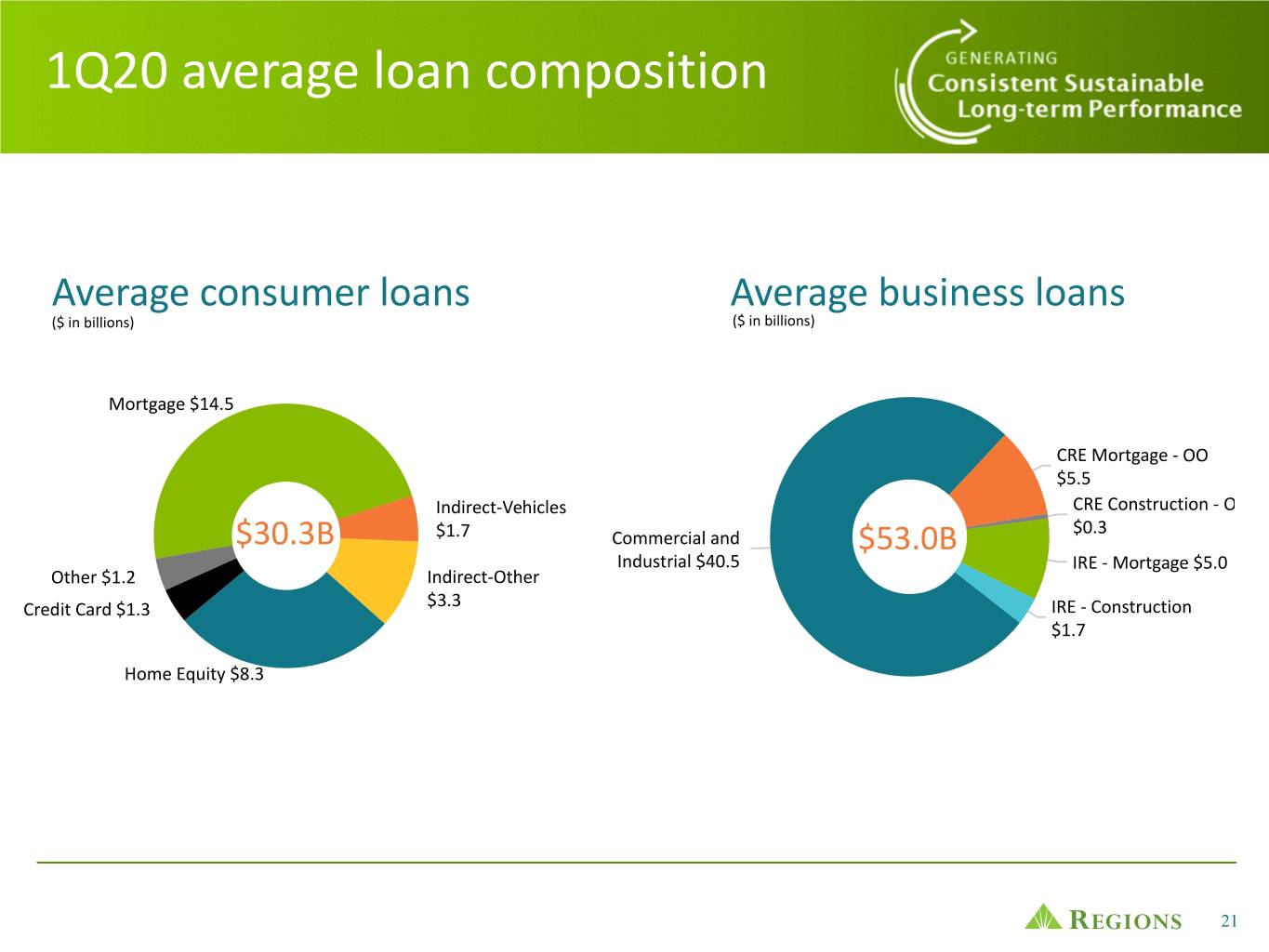
1Q20 average loan composition Average consumer loans Average business loans ($ in billions) ($ in billions) Mortgage $14.5 CRE Mortgage - OO $5.5 Indirect-Vehicles CRE Construction - OO $0.3 $30.3B $1.7 Commercial and $53.0B Industrial $40.5 IRE - Mortgage $5.0 Other $1.2 Indirect-Other Credit Card $1.3 $3.3 IRE - Construction $1.7 Home Equity $8.3 21
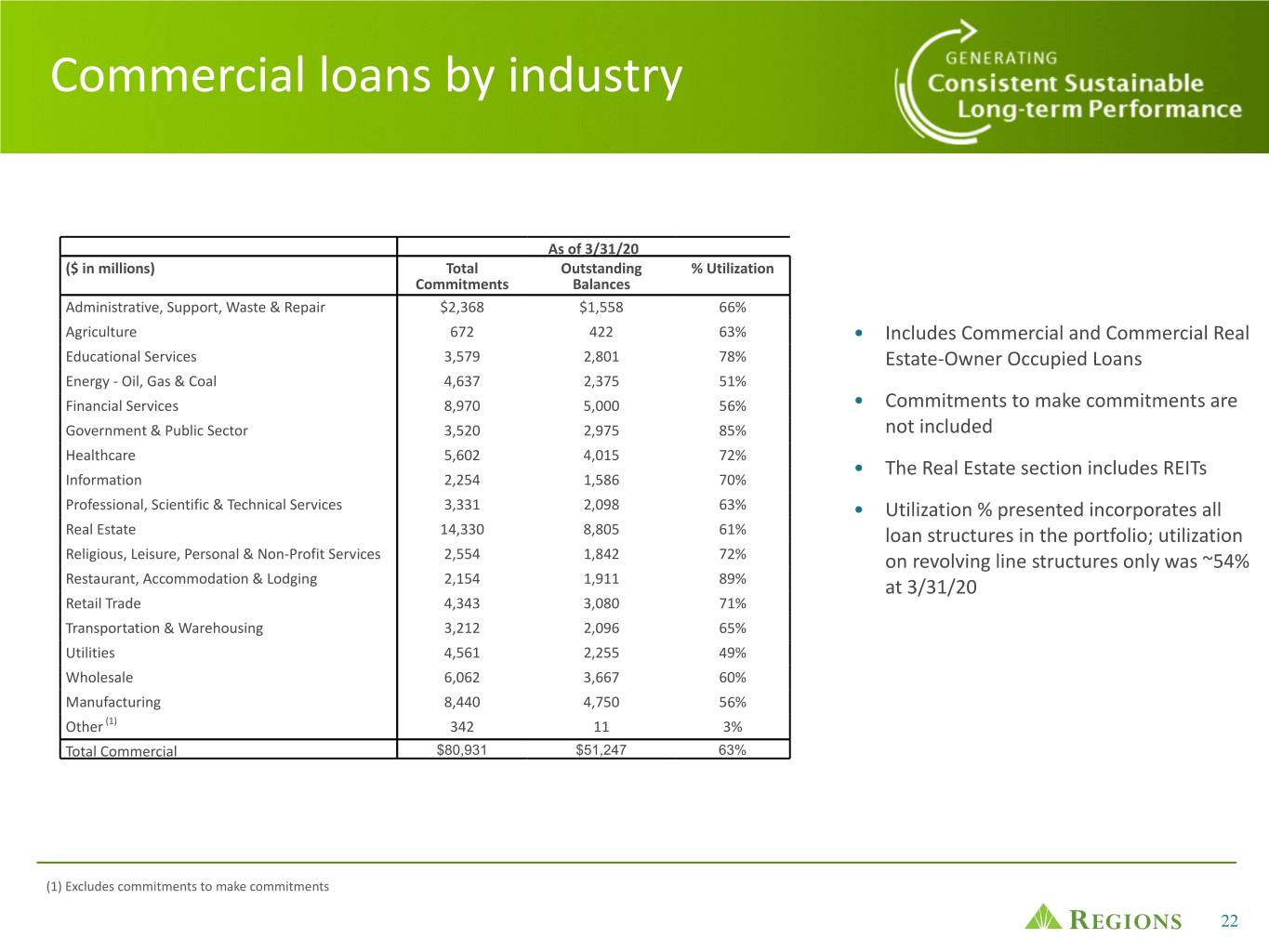
Commercial loans by industry As of 3/31/20 ($ in millions) Total Outstanding % Utilization Commitments Balances Administrative, Support, Waste & Repair $2,368 $1,558 66% Agriculture 672 422 63% • Includes Commercial and Commercial Real Educational Services 533,579 2,801 78% Estate-Owner Occupied Loans Energy - Oil, Gas & Coal 4,637 2,375 51% Financial Services 8,970 5,000 56% • Commitments to make commitments are Government & Public Sector 3,520 2,975 85% not included Healthcare 5,602 4,015 72% • The Real Estate section includes REITs Information 2,254 1,586 70% Professional, Scientific & Technical Services 3,331 2,098 63% • Utilization % presented incorporates all Real Estate 14,330 8,805 61% loan structures in the portfolio; utilization Religious, Leisure, Personal & Non-Profit Services 2,554 1,842 72% on revolving line structures only was ~54% Restaurant, Accommodation & Lodging 2,154 1,911 89% at 3/31/20 Retail Trade 4,343 3,080 71% Transportation & Warehousing 3,212 2,096 65% Utilities 4,561 2,255 49% Wholesale 6,062 3,667 60% Manufacturing 8,440 4,750 56% Other (1) 342 11 3% Total Commercial $80,931 $51,247 63% (1) Excludes commitments to make commitments 22
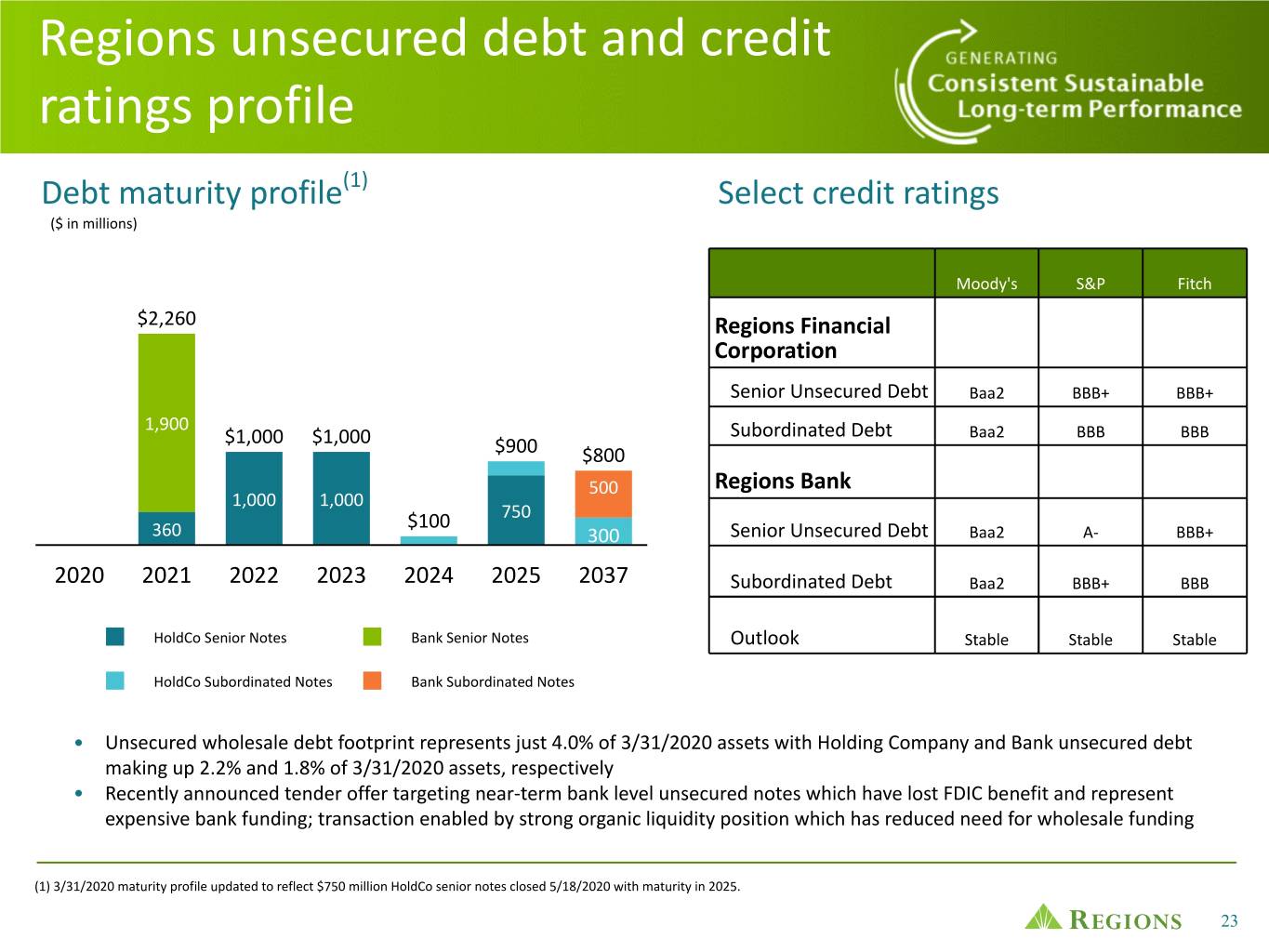
Regions unsecured debt and credit ratings profile Debt maturity profile(1) Select credit ratings ($ in millions) Moody's S&P Fitch $2,260 Regions Financial Corporation Senior Unsecured Debt Baa2 BBB+ BBB+ 1,900 $1,000 $1,000 Subordinated Debt Baa2 BBB BBB $900 $800 500 Regions Bank 1,000 1,000 $100 750 360 300 Senior Unsecured Debt Baa2 A- BBB+ 2020 2021 2022 2023 2024 2025 2037 Subordinated Debt Baa2 BBB+ BBB HoldCo Senior Notes Bank Senior Notes Outlook Stable Stable Stable HoldCo Subordinated Notes Bank Subordinated Notes • Unsecured wholesale debt footprint represents just 4.0% of 3/31/2020 assets with Holding Company and Bank unsecured debt making up 2.2% and 1.8% of 3/31/2020 assets, respectively • Recently announced tender offer targeting near-term bank level unsecured notes which have lost FDIC benefit and represent expensive bank funding; transaction enabled by strong organic liquidity position which has reduced need for wholesale funding (1) 3/31/2020 maturity profile updated to reflect $750 million HoldCo senior notes closed 5/18/2020 with maturity in 2025. 23
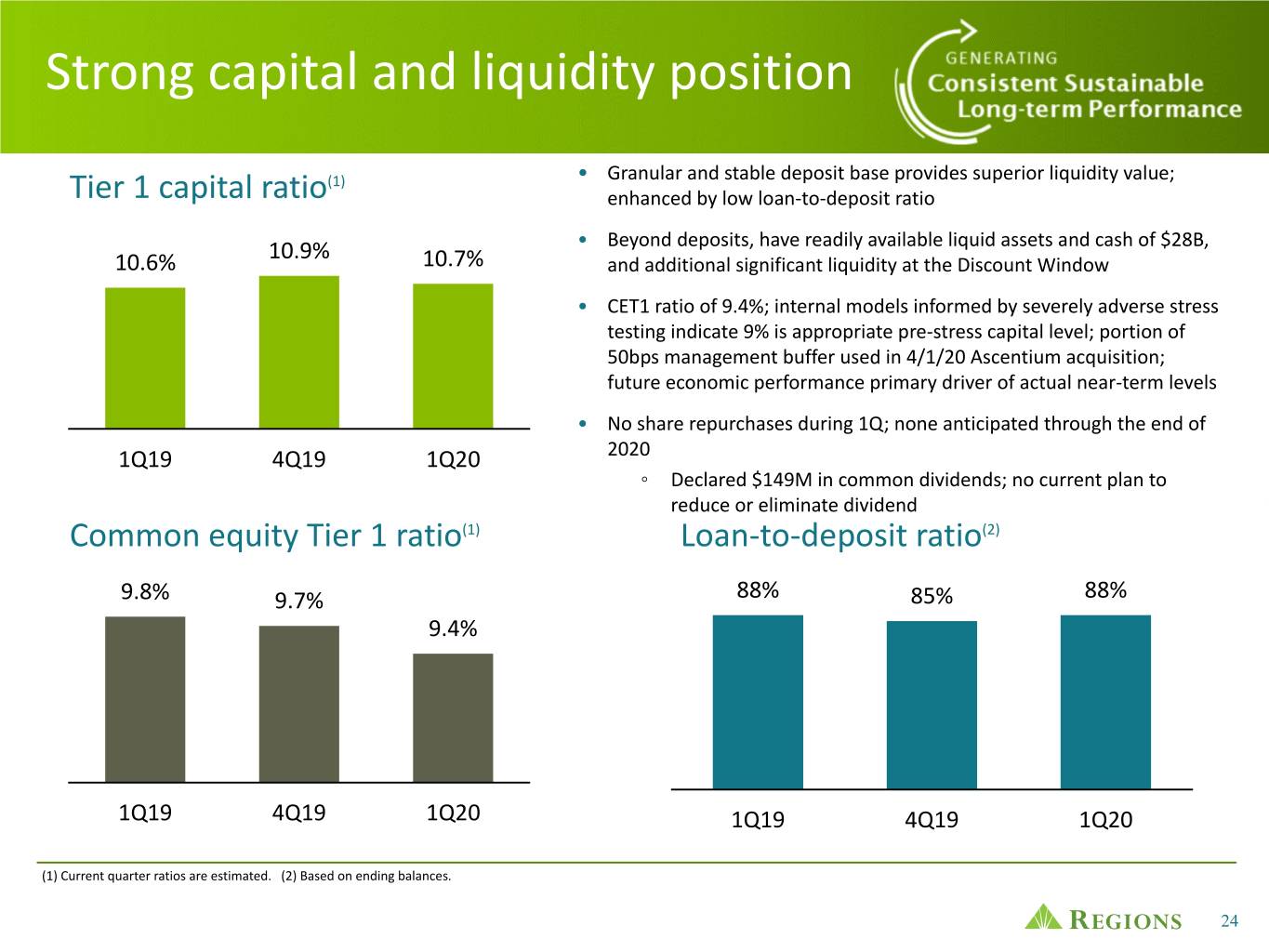
Strong capital and liquidity position (1) • Granular and stable deposit base provides superior liquidity value; Tier 1 capital ratio enhanced by low loan-to-deposit ratio 10.9% • Beyond deposits, have readily available liquid assets and cash of $28B, 10.6% 10.7% and additional significant liquidity at the Discount Window • CET1 ratio of 9.4%; internal models informed by severely adverse stress testing indicate 9% is appropriate pre-stress capital level; portion of 50bps management buffer used in 4/1/20 Ascentium acquisition; future economic performance primary driver of actual near-term levels • No share repurchases during 1Q; none anticipated through the end of 1Q19 4Q19 1Q20 2020 ◦ Declared $149M in common dividends; no current plan to reduce or eliminate dividend Common equity Tier 1 ratio(1) Loan-to-deposit ratio(2) 9.8% 9.7% 88% 85% 88% 9.4% 1Q19 4Q19 1Q20 1Q19 4Q19 1Q20 (1) Current quarter ratios are estimated. (2) Based on ending balances. 24
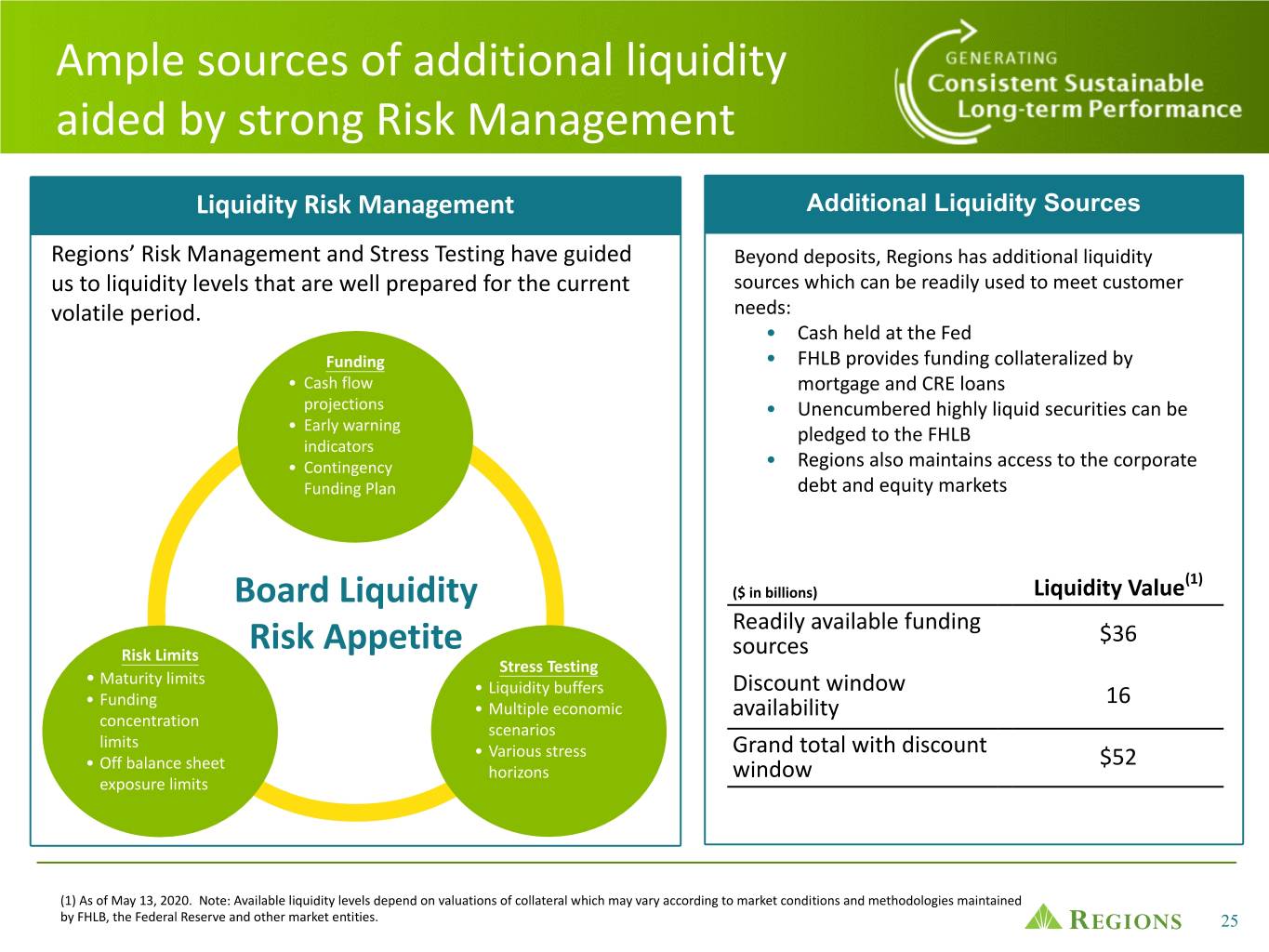
Ample sources of additional liquidity aided by strong Risk Management Liquidity Risk Management Additional Liquidity Sources Regions’ Risk Management and Stress Testing have guided Beyond deposits, Regions has additional liquidity us to liquidity levels that are well prepared for the current sources which can be readily used to meet customer volatile period. needs: • Cash held at the Fed Funding • FHLB provides funding collateralized by • Cash flow mortgage and CRE loans projections • Unencumbered highly liquid securities can be • Early warning pledged to the FHLB indicators • Contingency • Regions also maintains access to the corporate Funding Plan debt and equity markets (1) Board Liquidity ($ in billions) Liquidity Value Readily available funding $36 Risk Limits Risk Appetite sources Stress Testing Maturity limits • • Liquidity buffers Discount window • Funding 16 • Multiple economic availability concentration scenarios limits • Various stress Grand total with discount • Off balance sheet $52 horizons window exposure limits (1) As of May 13, 2020. Note: Available liquidity levels depend on valuations of collateral which may vary according to market conditions and methodologies maintained by FHLB, the Federal Reserve and other market entities. 25
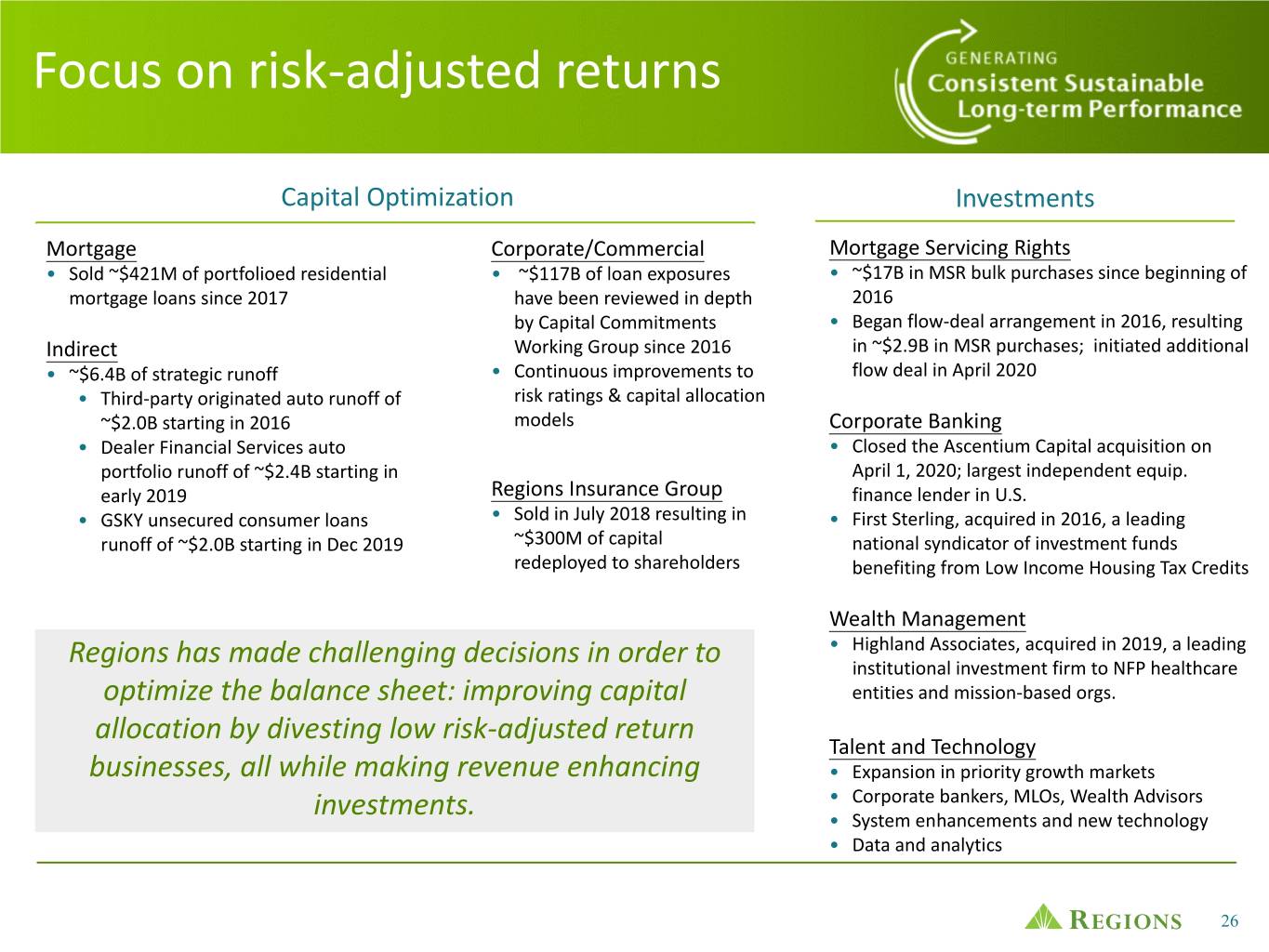
Focus on risk-adjusted returns Capital Optimization Investments Mortgage Corporate/Commercial Mortgage Servicing Rights • Sold ~$421M of portfolioed residential • ~$117B of loan exposures • ~$17B in MSR bulk purchases since beginning of mortgage loans since 2017 have been reviewed in depth 2016 by Capital Commitments • Began flow-deal arrangement in 2016, resulting Indirect Working Group since 2016 in ~$2.9B in MSR purchases; initiated additional • ~$6.4B of strategic runoff • Continuous improvements to flow deal in April 2020 • Third-party originated auto runoff of risk ratings & capital allocation ~$2.0B starting in 2016 models Corporate Banking • Dealer Financial Services auto • Closed the Ascentium Capital acquisition on portfolio runoff of ~$2.4B starting in April 1, 2020; largest independent equip. early 2019 Regions Insurance Group finance lender in U.S. • GSKY unsecured consumer loans • Sold in July 2018 resulting in • First Sterling, acquired in 2016, a leading runoff of ~$2.0B starting in Dec 2019 ~$300M of capital national syndicator of investment funds redeployed to shareholders benefiting from Low Income Housing Tax Credits Wealth Management • Highland Associates, acquired in 2019, a leading Regions has made challenging decisions in order to institutional investment firm to NFP healthcare optimize the balance sheet: improving capital entities and mission-based orgs. allocation by divesting low risk-adjusted return Talent and Technology businesses, all while making revenue enhancing • Expansion in priority growth markets • Corporate bankers, MLOs, Wealth Advisors investments. • System enhancements and new technology • Data and analytics 26
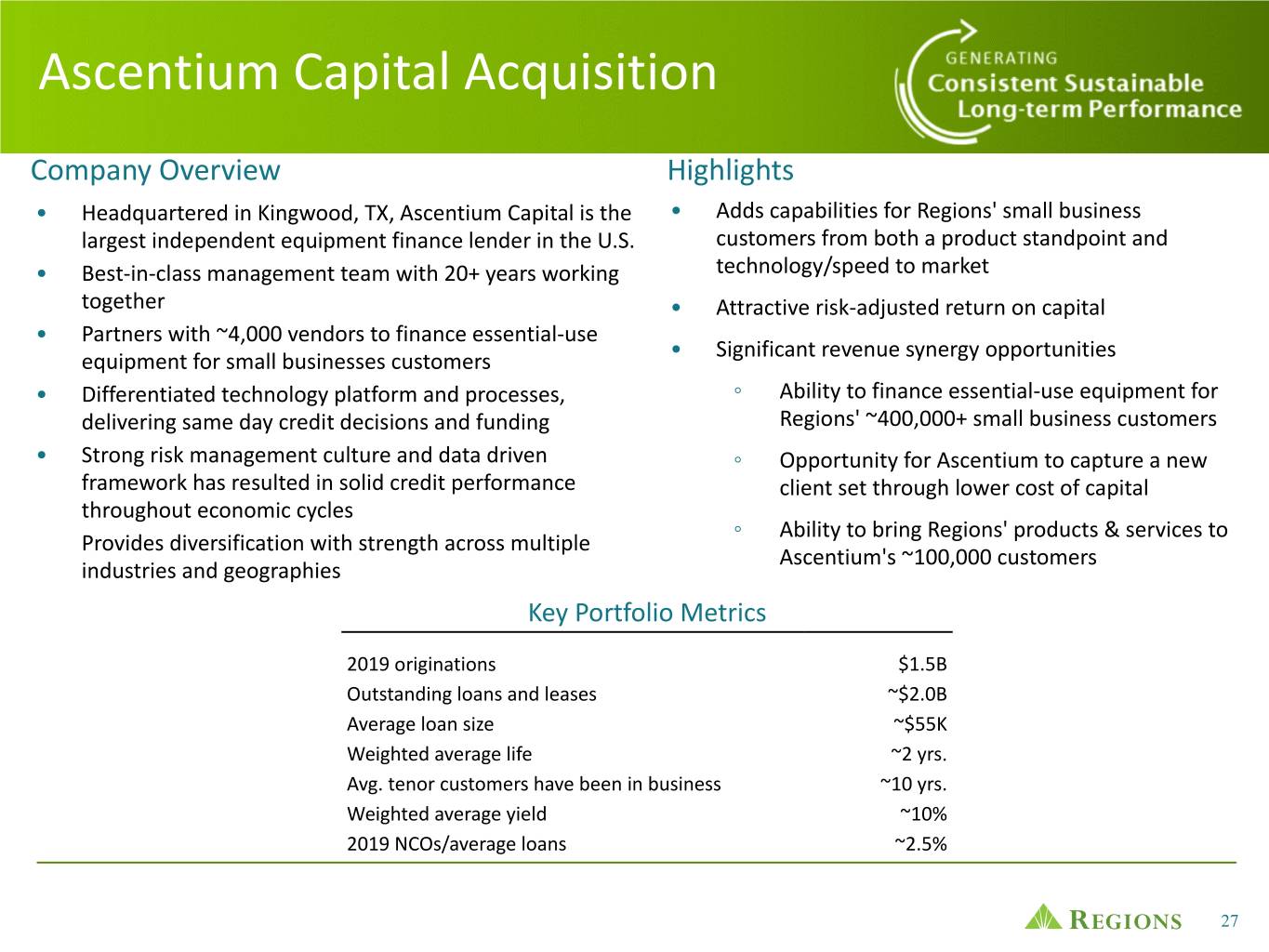
Ascentium Capital Acquisition Company Overview Highlights • Headquartered in Kingwood, TX, Ascentium Capital is the • Adds capabilities for Regions' small business largest independent equipment finance lender in the U.S. customers from both a product standpoint and • Best-in-class management team with 20+ years working technology/speed to market together • Attractive risk-adjusted return on capital • Partners with ~4,000 vendors to finance essential-use • Significant revenue synergy opportunities equipment for small businesses customers • Differentiated technology platform and processes, ◦ Ability to finance essential-use equipment for delivering same day credit decisions and funding Regions' ~400,000+ small business customers • Strong risk management culture and data driven ◦ Opportunity for Ascentium to capture a new framework has resulted in solid credit performance client set through lower cost of capital throughout economic cycles ◦ Ability to bring Regions' products & services to Provides diversification with strength across multiple Ascentium's ~100,000 customers industries and geographies Key Portfolio Metrics 2019 originations $1.5B Outstanding loans and leases ~$2.0B Average loan size ~$55K Weighted average life ~2 yrs. Avg. tenor customers have been in business ~10 yrs. Weighted average yield ~10% 2019 NCOs/average loans ~2.5% 27
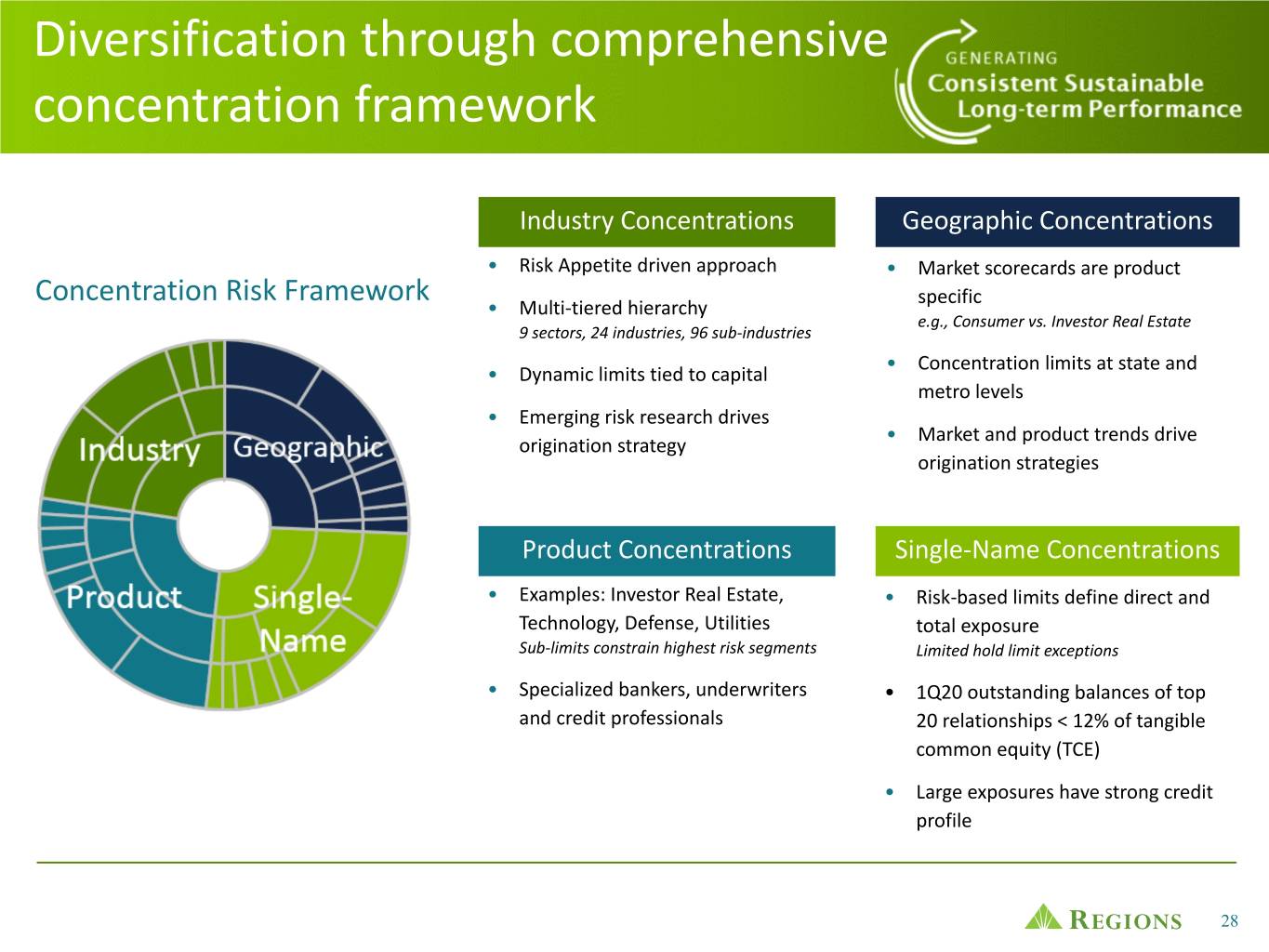
Diversification through comprehensive concentration framework Industry Concentrations Geographic Concentrations • Risk Appetite driven approach • Market scorecards are product Concentration Risk Framework specific • Multi-tiered hierarchy e.g., Consumer vs. Investor Real Estate 9 sectors, 24 industries, 96 sub-industries • Concentration limits at state and • Dynamic limits tied to capital metro levels • Emerging risk research drives • Market and product trends drive origination strategy origination strategies Product Concentrations Single-Name Concentrations • Examples: Investor Real Estate, • Risk-based limits define direct and Technology, Defense, Utilities total exposure Sub-limits constrain highest risk segments Limited hold limit exceptions • Specialized bankers, underwriters • 1Q20 outstanding balances of top and credit professionals 20 relationships < 12% of tangible common equity (TCE) • Large exposures have strong credit profile 28
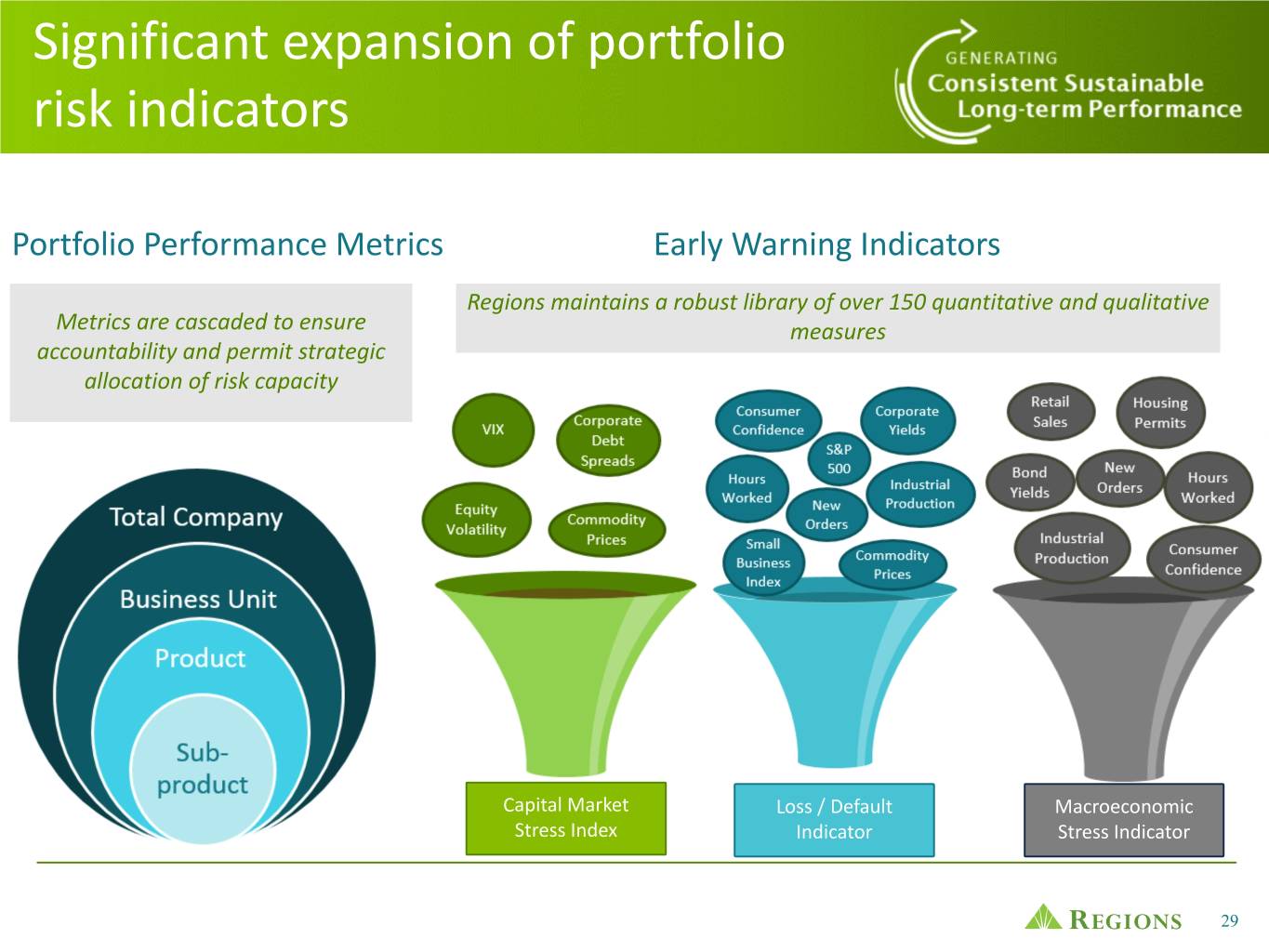
Significant expansion of portfolio risk indicators Portfolio Performance Metrics Early Warning Indicators Regions maintains a robust library of over 150 quantitative and qualitative Metrics are cascaded to ensure measures accountability and permit strategic allocation of risk capacity Capital Market Loss / Default Macroeconomic Stress Index Indicator Stress Indicator 29

CECL allowance for credit losses waterfall ($ in millions) Highlights • Day 1 adjustment due to 1/1/20 CECL adoption resulted in an allowance for credit losses (ACL) $207 $1,665 of $1.415B $36 • Q1 allowance increased $250M due primarily $501 $16 to the uncertainty associated with COVID–19, $(9) and higher specific reserves due to downgrades primarily in the Energy and Restaurant portfolios $914 • Several analyses were developed to inform our estimate including: ◦ Stressed analyses of all inputs 12/31/2019 Day 1 Lower Model Specific Economic 3/31/2020 ◦ Internal and external forecasts and Adjust- Consumer Enhance- Reserves Uncertainty specific industry shocks ment Balances ments & & Other Higher ◦ Specifically stressed GDP and Business unemployment rates Balances ◦ Potential benefits of stimulus packages • CECL process is embedded in how we manage capital 30

Asset quality Net charge-offs and ratio Criticized business loans ($ in millions) $123 ($ in millions) 63 $2,524 $96 $2,119 $2,251 $78 31 0.59% 20 0.46% 0.38% 53 58 65 60 1Q19 4Q19 1Q20 1Q19 4Q19 1Q20 Consumer net Commercial net Net charge-offs ratio • Adopted CECL 1/1/20; 1Q20 provision $373M ($123M NCOs + charge-offs charge-offs $250M reserve build) NPLs and ACL coverage ratio • Qualitative model overlay for economic uncertainty considered ($ in millions) several alternative analyses and resulted in potential increases of ~ $638 $100M to $500M as compared to the 1/1/20 allowance(1) $523 $507 261% • If current trends continue, it is likely that increases in allowance, which could be material, will be required in future periods 173% 180% • 2Q20 Ascentium purchase includes ~$2B of small business loans; will require initial CECL reserves for non-PCD loans through 1Q19 4Q19 1Q20 provision expense; will be offset by accretion of credit discount (2) NPLs - excluding LHFS ACL coverage ratio over life of purchased loan portfolio (1) For additional disclosures related to macroeconomic factors considered in the forecast see Table 7 in the 3/31/20 10-Q. (2) Finalization of purchase accounting, including defining purchase credit deteriorated (PCD) loans is still ongoing. 31
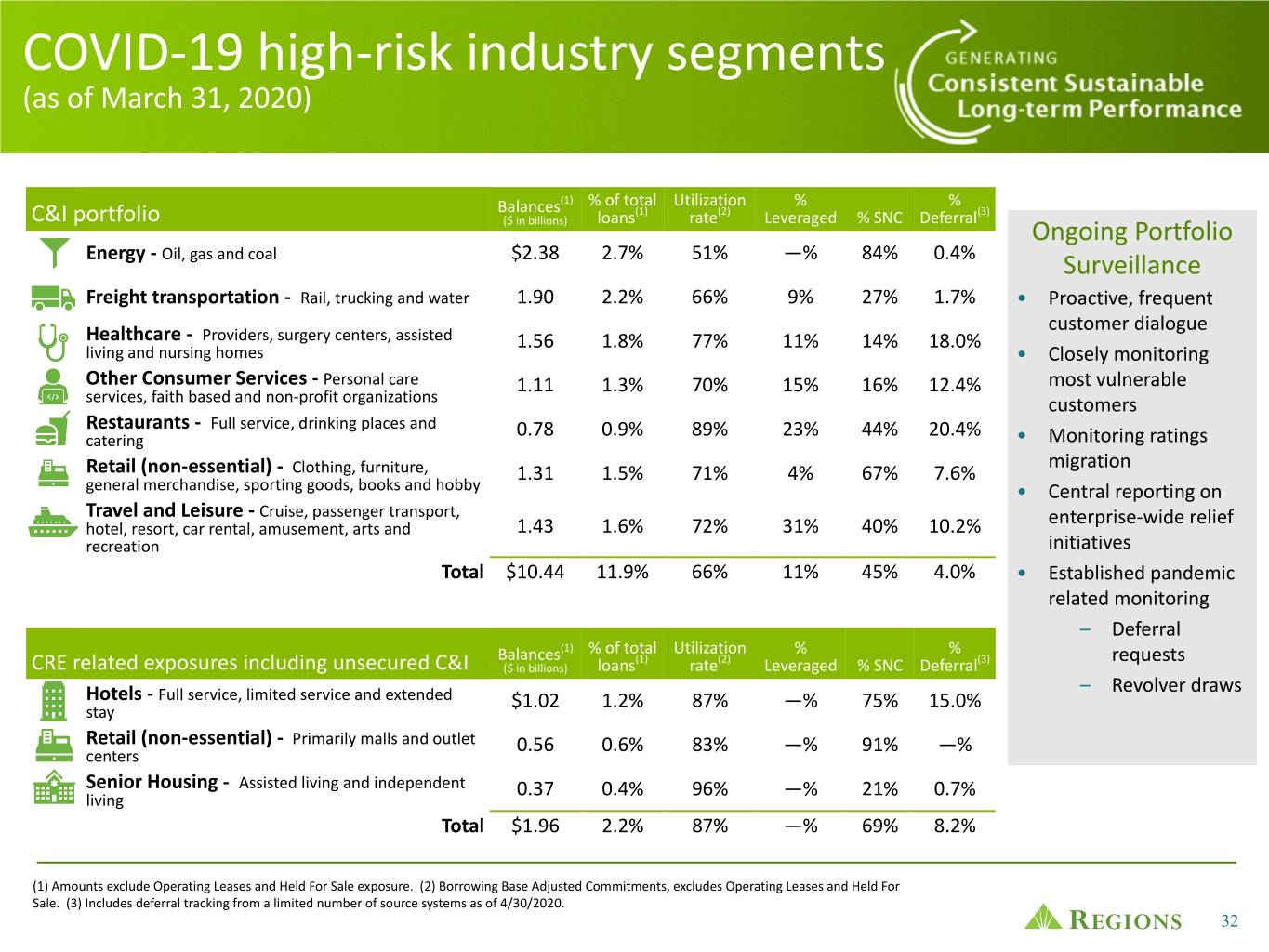
COVID-19 high-risk industry segments (as of March 31, 2020) (1) % of total Utilization % % Balances (1) (2) (3) C&I portfolio ($ in billions) loans rate Leveraged % SNC Deferral Ongoing Portfolio Energy - Oil, gas and coal $2.38 2.7% 51% —% 84% 0.4% Surveillance Freight transportation - Rail, trucking and water 1.90 2.2% 66% 9% 27% 1.7% • Proactive, frequent customer dialogue Healthcare - Providers, surgery centers, assisted 1.56 1.8% 77% 11% 14% 18.0% living and nursing homes • Closely monitoring Other Consumer Services - Personal care 1.11 1.3% 70% 15% 16% 12.4% most vulnerable services, faith based and non-profit organizations customers Restaurants - Full service, drinking places and 0.78 0.9% 89% 23% 44% 20.4% catering • Monitoring ratings migration Retail (non-essential) - Clothing, furniture, 1.31 1.5% 71% 4% 67% 7.6% general merchandise, sporting goods, books and hobby • Central reporting on Travel and Leisure - Cruise, passenger transport, enterprise-wide relief hotel, resort, car rental, amusement, arts and 1.43 1.6% 72% 31% 40% 10.2% recreation initiatives Total $10.44 11.9% 66% 11% 45% 4.0% • Established pandemic related monitoring – Deferral (1) % of total Utilization % % Balances (1) (2) (3) requests CRE related exposures including unsecured C&I ($ in billions) loans rate Leveraged % SNC Deferral – Revolver draws Hotels - Full service, limited service and extended $1.02 1.2% 87% —% 75% 15.0% stay Retail (non-essential) - Primarily malls and outlet 0.56 0.6% 83% —% 91% —% centers Senior Housing - Assisted living and independent 0.37 0.4% 96% —% 21% 0.7% living Total $1.96 2.2% 87% —% 69% 8.2% (1) Amounts exclude Operating Leases and Held For Sale exposure. (2) Borrowing Base Adjusted Commitments, excludes Operating Leases and Held For Sale. (3) Includes deferral tracking from a limited number of source systems as of 4/30/2020. 32
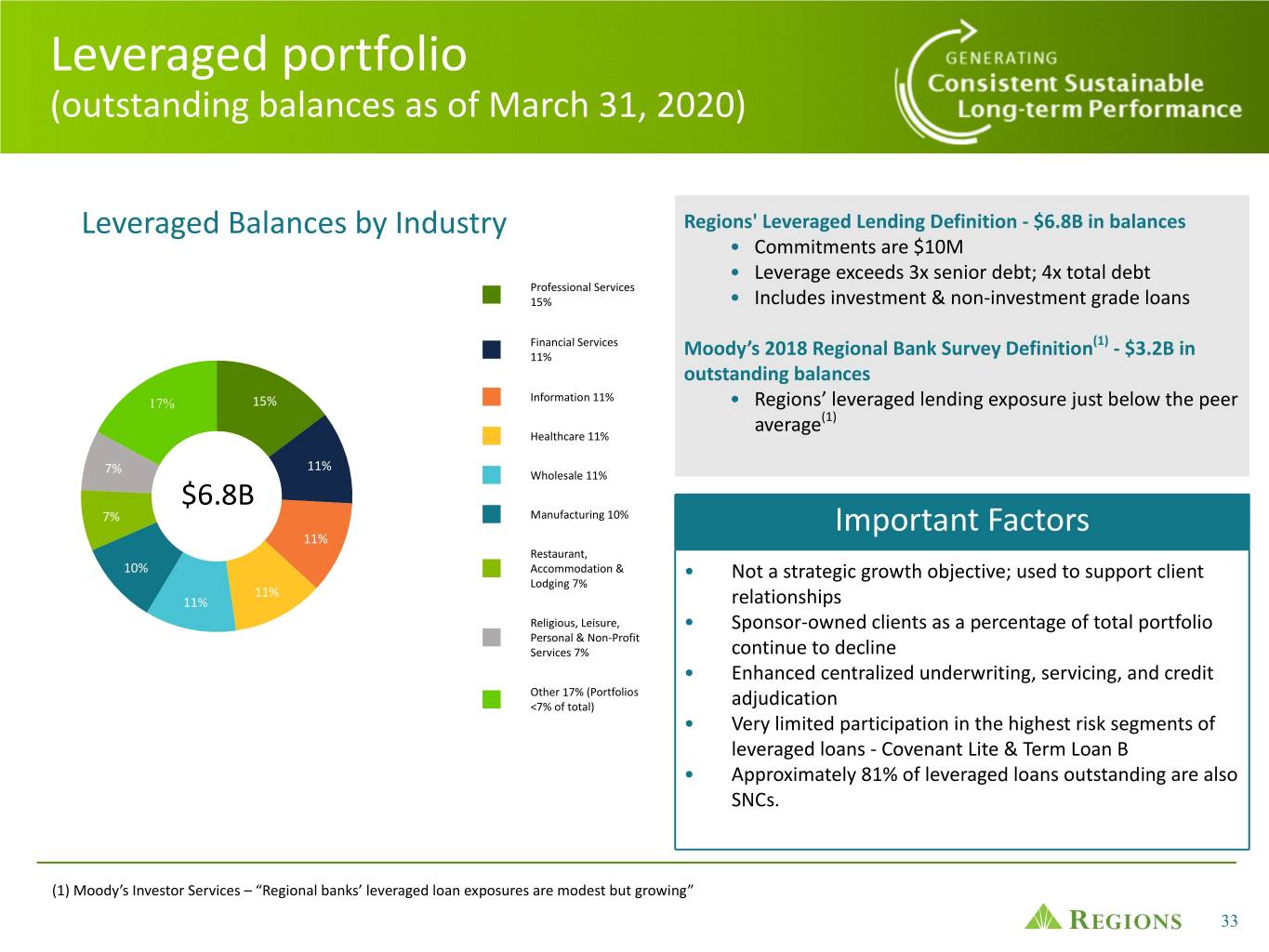
Leveraged portfolio (outstanding balances as of March 31, 2020) Leveraged Balances by Industry Regions' Leveraged Lending Definition - $6.8B in balances • Commitments are $10M • Leverage exceeds 3x senior debt; 4x total debt Professional Services 15% • Includes investment & non-investment grade loans Financial Services (1) 11% Moody’s 2018 Regional Bank Survey Definition - $3.2B in outstanding balances 17% 15% Information 11% • Regions’ leveraged lending exposure just below the peer average(1) Healthcare 11% 11% 7% Wholesale 11% $6.8B 7% Manufacturing 10% Important Factors 11% Restaurant, 10% Accommodation & • Not a strategic growth objective; used to support client Lodging 7% 11% 11% relationships Religious, Leisure, • Sponsor-owned clients as a percentage of total portfolio Personal & Non-Profit Services 7% continue to decline • Enhanced centralized underwriting, servicing, and credit Other 17% (Portfolios <7% of total) adjudication • Very limited participation in the highest risk segments of leveraged loans - Covenant Lite & Term Loan B • Approximately 81% of leveraged loans outstanding are also SNCs. (1) Moody’s Investor Services – “Regional banks’ leveraged loan exposures are modest but growing” 33
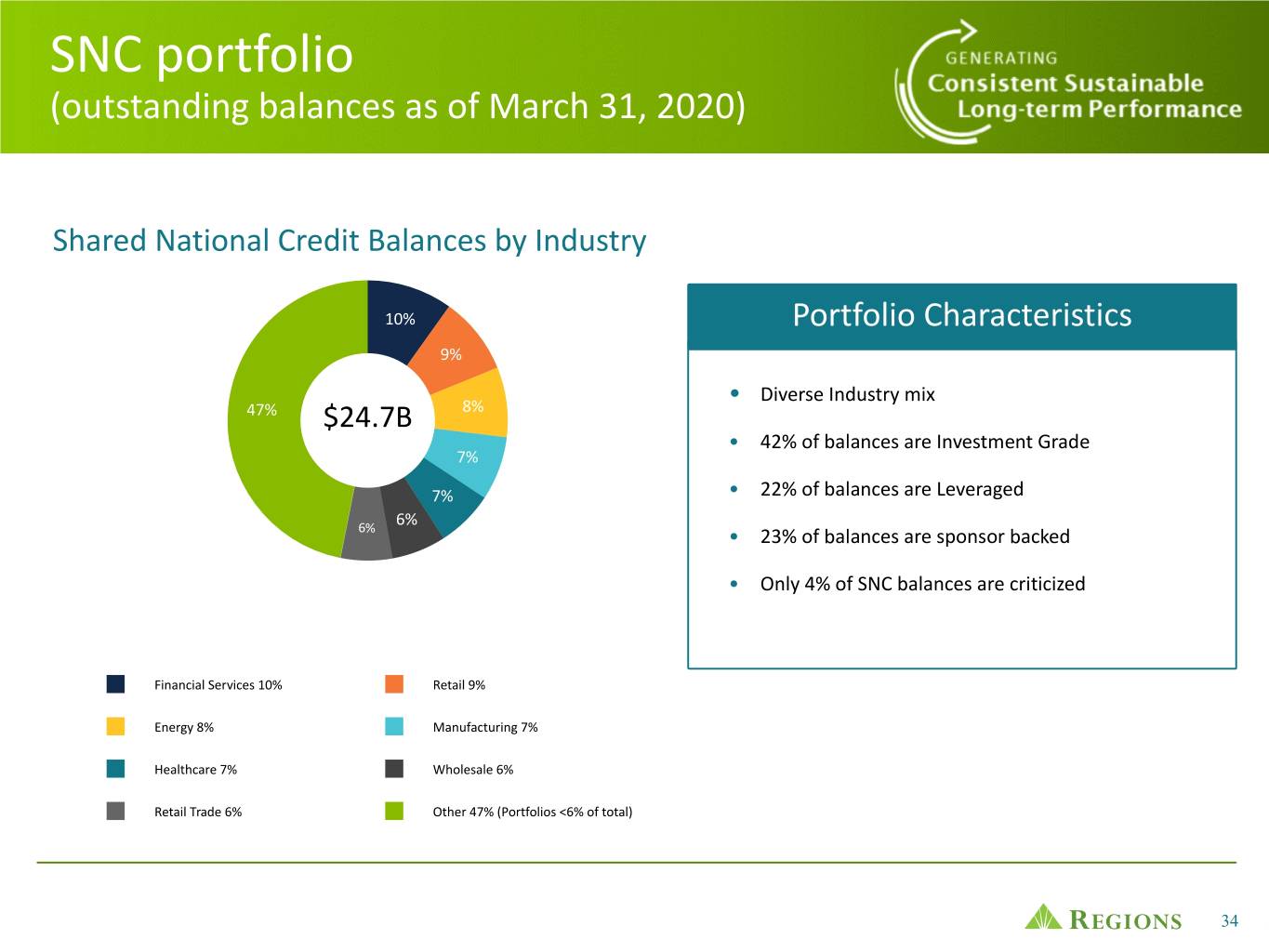
SNC portfolio (outstanding balances as of March 31, 2020) Shared National Credit Balances by Industry 10% Portfolio Characteristics 9% • Diverse Industry mix 47% $24.7B 8% • 42% of balances are Investment Grade 7% 7% • 22% of balances are Leveraged 6% 6% • 23% of balances are sponsor backed • Only 4% of SNC balances are criticized Financial Services 10% Retail 9% Energy 8% Manufacturing 7% Healthcare 7% Wholesale 6% Retail Trade 6% Other 47% (Portfolios <6% of total) 34
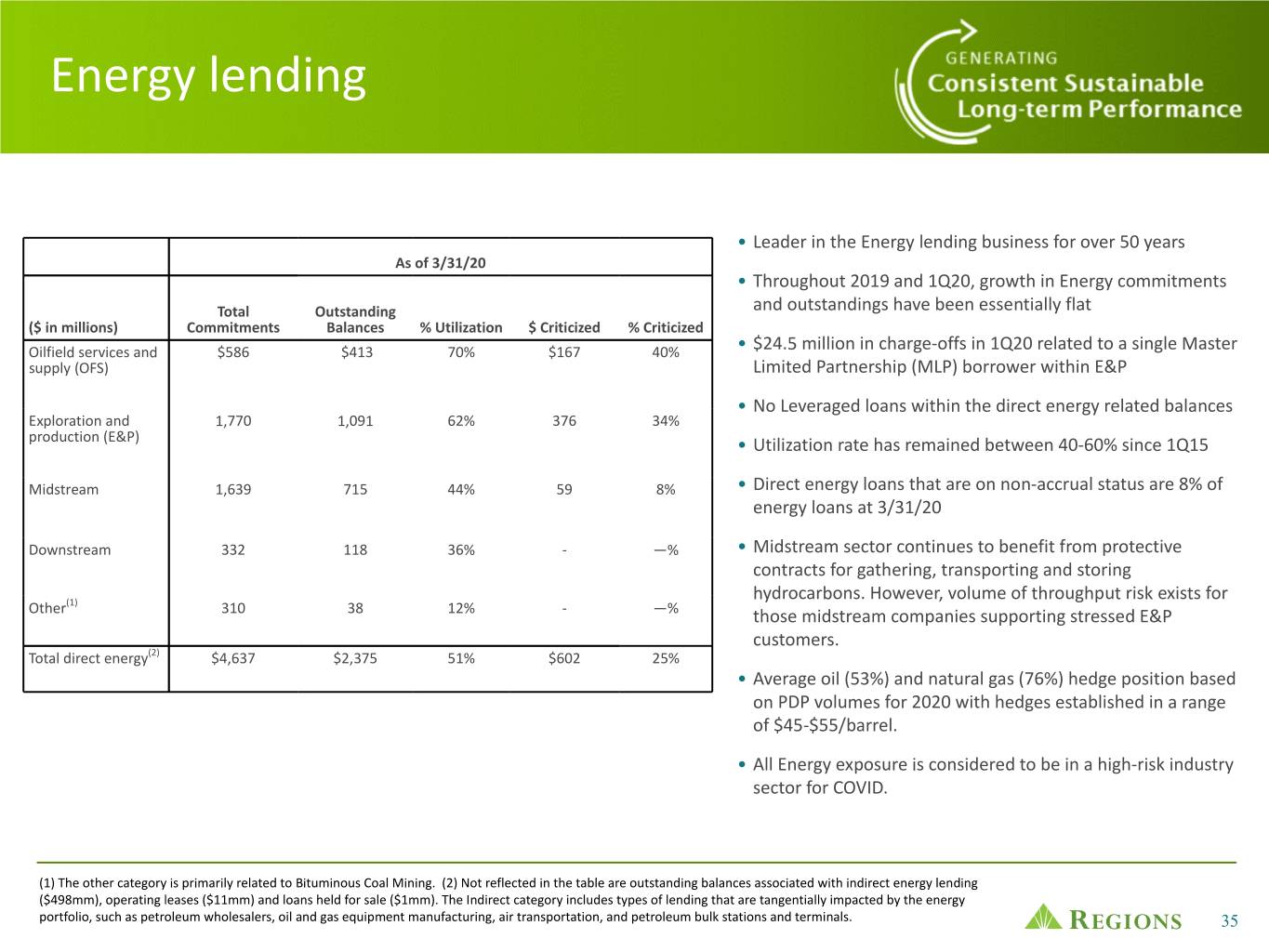
Energy lending • Leader in the Energy lending business for over 50 years As of 3/31/20 • Throughout 2019 and 1Q20, growth in Energy commitments Total Outstanding and outstandings have been essentially flat ($ in millions) Commitments Balances % Utilization $ Criticized % Criticized Oilfield services and $586 $413 70% $167 40% • $24.5 million in charge-offs in 1Q20 related to a single Master supply (OFS) 53 Limited Partnership (MLP) borrower within E&P • No Leveraged loans within the direct energy related balances Exploration and 1,770 1,091 62% 376 34% production (E&P) • Utilization rate has remained between 40-60% since 1Q15 Midstream 1,639 715 44% 59 8% • Direct energy loans that are on non-accrual status are 8% of energy loans at 3/31/20 Downstream 332 118 36% - —% • Midstream sector continues to benefit from protective contracts for gathering, transporting and storing (1) hydrocarbons. However, volume of throughput risk exists for Other 310 38 12% - —% those midstream companies supporting stressed E&P customers. Total direct energy(2) $4,637 $2,375 51% $602 25% • Average oil (53%) and natural gas (76%) hedge position based on PDP volumes for 2020 with hedges established in a range of $45-$55/barrel. • All Energy exposure is considered to be in a high-risk industry sector for COVID. (1) The other category is primarily related to Bituminous Coal Mining. (2) Not reflected in the table are outstanding balances associated with indirect energy lending ($498mm), operating leases ($11mm) and loans held for sale ($1mm). The Indirect category includes types of lending that are tangentially impacted by the energy portfolio, such as petroleum wholesalers, oil and gas equipment manufacturing, air transportation, and petroleum bulk stations and terminals. 35
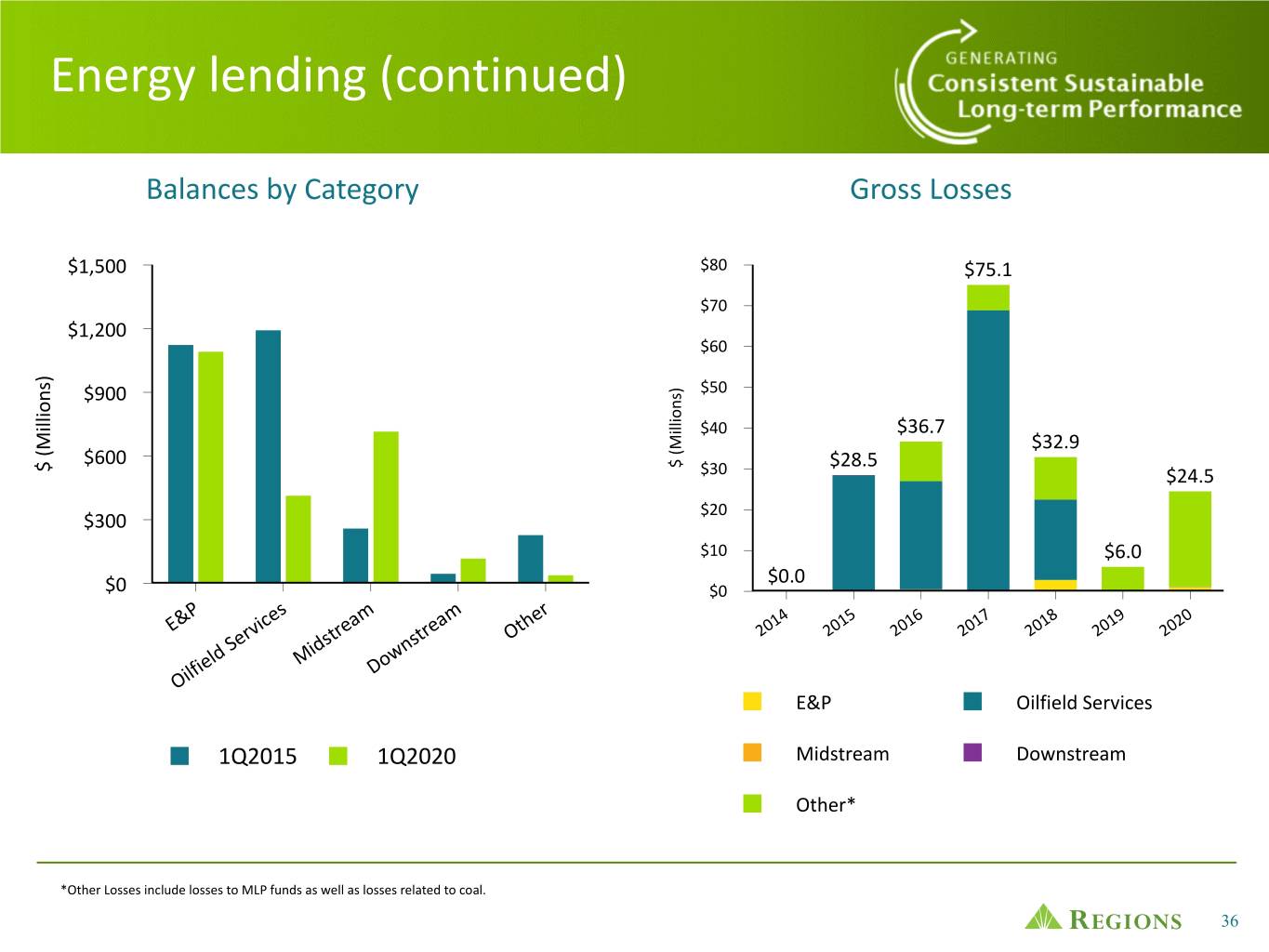
Energy lending (continued) Balances by Category Gross Losses $1,500 $80 $75.1 $70 $1,200 $60 53 ) s ) $50 s n $900 n o i o l i l l l i i $40 $36.7 M M $32.9 ( ( $600 $ $28.5 $ $30 $24.5 $20 $300 $10 $6.0 $0.0 $0 $0 P es m m er 4 5 6 7 8 9 0 E& ic a a th 01 01 01 01 01 01 02 rv tre tre O 2 2 2 2 2 2 2 Se s s d id wn el M o lfi D Oi E&P Oilfield Services 1Q2015 1Q2020 Midstream Downstream Other* *Other Losses include losses to MLP funds as well as losses related to coal. 36
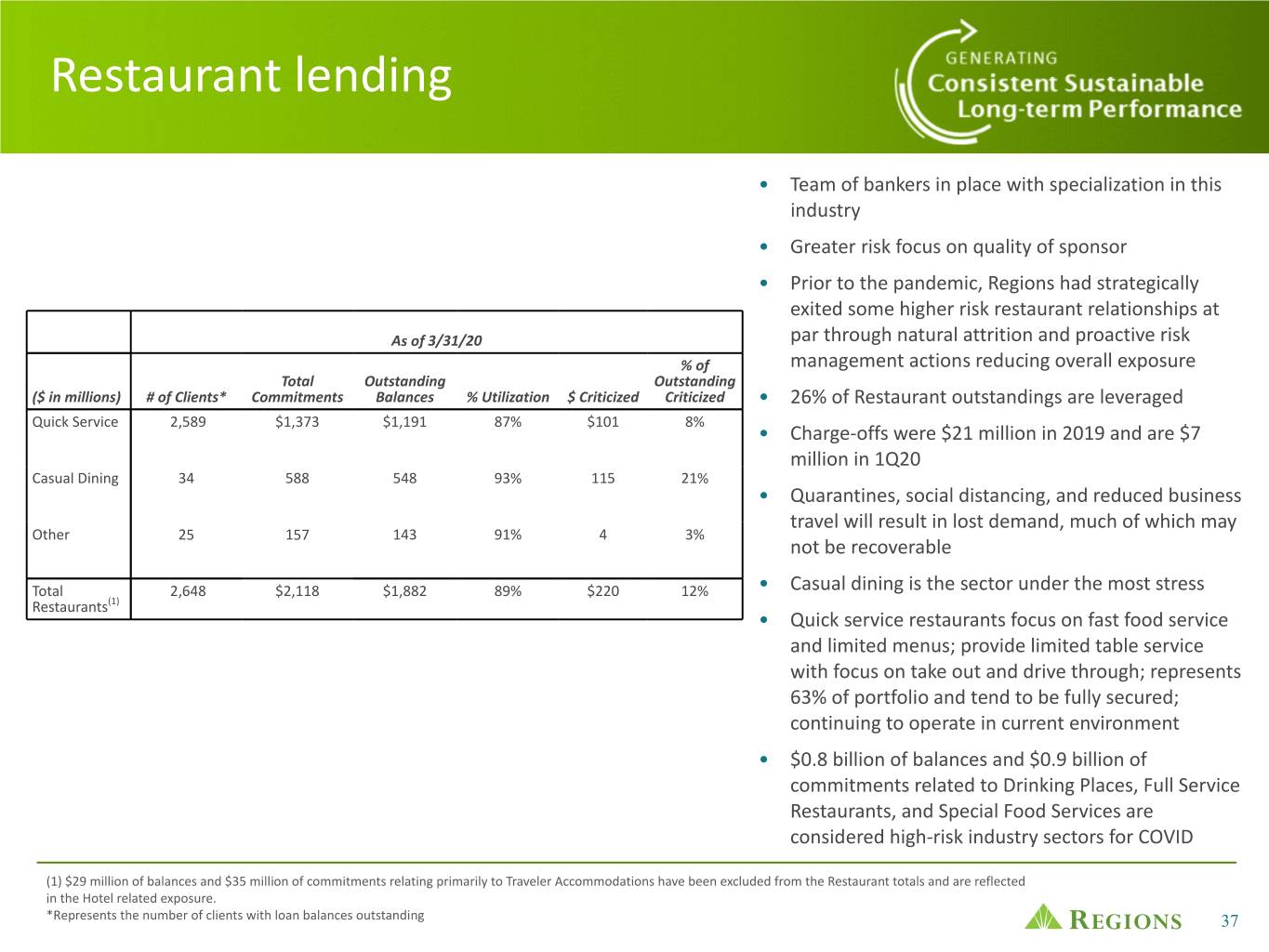
Restaurant lending • Team of bankers in place with specialization in this industry • Greater risk focus on quality of sponsor • Prior to the pandemic, Regions had strategically exited some higher risk restaurant relationships at As of 3/31/20 par through natural attrition and proactive risk 53 % of management actions reducing overall exposure Total Outstanding Outstanding ($ in millions) # of Clients* Commitments Balances % Utilization $ Criticized Criticized • 26% of Restaurant outstandings are leveraged Quick Service 2,589 $1,373 $1,191 87% $101 8% • Charge-offs were $21 million in 2019 and are $7 million in 1Q20 Casual Dining 34 588 548 93% 115 21% • Quarantines, social distancing, and reduced business travel will result in lost demand, much of which may Other 25 157 143 91% 4 3% not be recoverable Total 2,648 $2,118 $1,882 89% $220 12% • Casual dining is the sector under the most stress Restaurants(1) • Quick service restaurants focus on fast food service and limited menus; provide limited table service with focus on take out and drive through; represents 63% of portfolio and tend to be fully secured; continuing to operate in current environment • $0.8 billion of balances and $0.9 billion of commitments related to Drinking Places, Full Service Restaurants, and Special Food Services are considered high-risk industry sectors for COVID (1) $29 million of balances and $35 million of commitments relating primarily to Traveler Accommodations have been excluded from the Restaurant totals and are reflected in the Hotel related exposure. *Represents the number of clients with loan balances outstanding 37
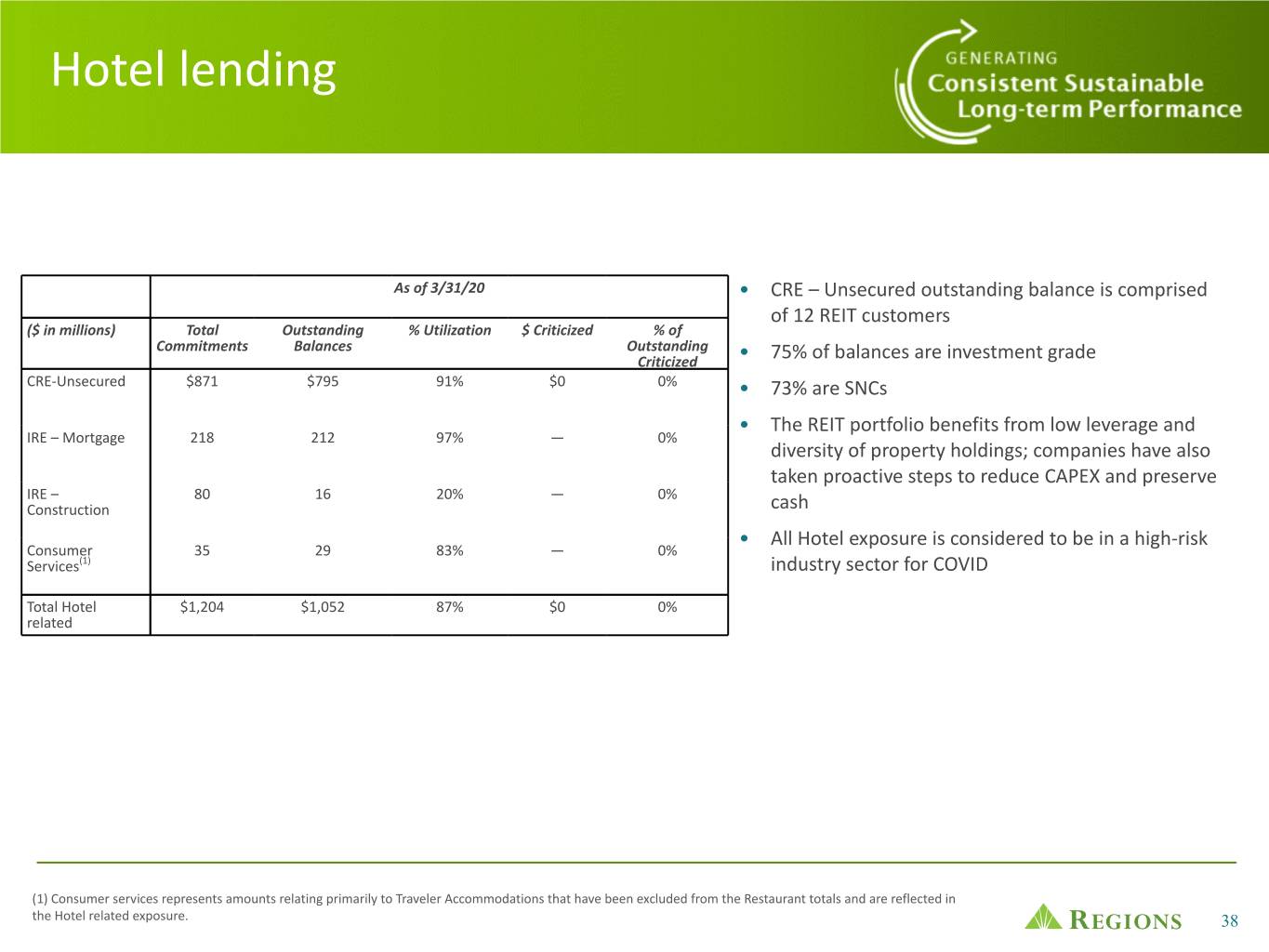
Hotel lending As of 3/31/20 • CRE – Unsecured outstanding balance is comprised of 12 REIT customers ($ in millions) Total Outstanding % Utilization $ Criticized % of Commitments Balances Outstanding 53 Criticized • 75% of balances are investment grade CRE-Unsecured $871 $795 91% $0 0% • 73% are SNCs • The REIT portfolio benefits from low leverage and IRE – Mortgage 218 212 97% — 0% diversity of property holdings; companies have also taken proactive steps to reduce CAPEX and preserve IRE – 80 16 20% — 0% Construction cash • All Hotel exposure is considered to be in a high-risk Consumer 35 29 83% — 0% Services(1) industry sector for COVID Total Hotel $1,204 $1,052 87% $0 0% related (1) Consumer services represents amounts relating primarily to Traveler Accommodations that have been excluded from the Restaurant totals and are reflected in the Hotel related exposure. 38
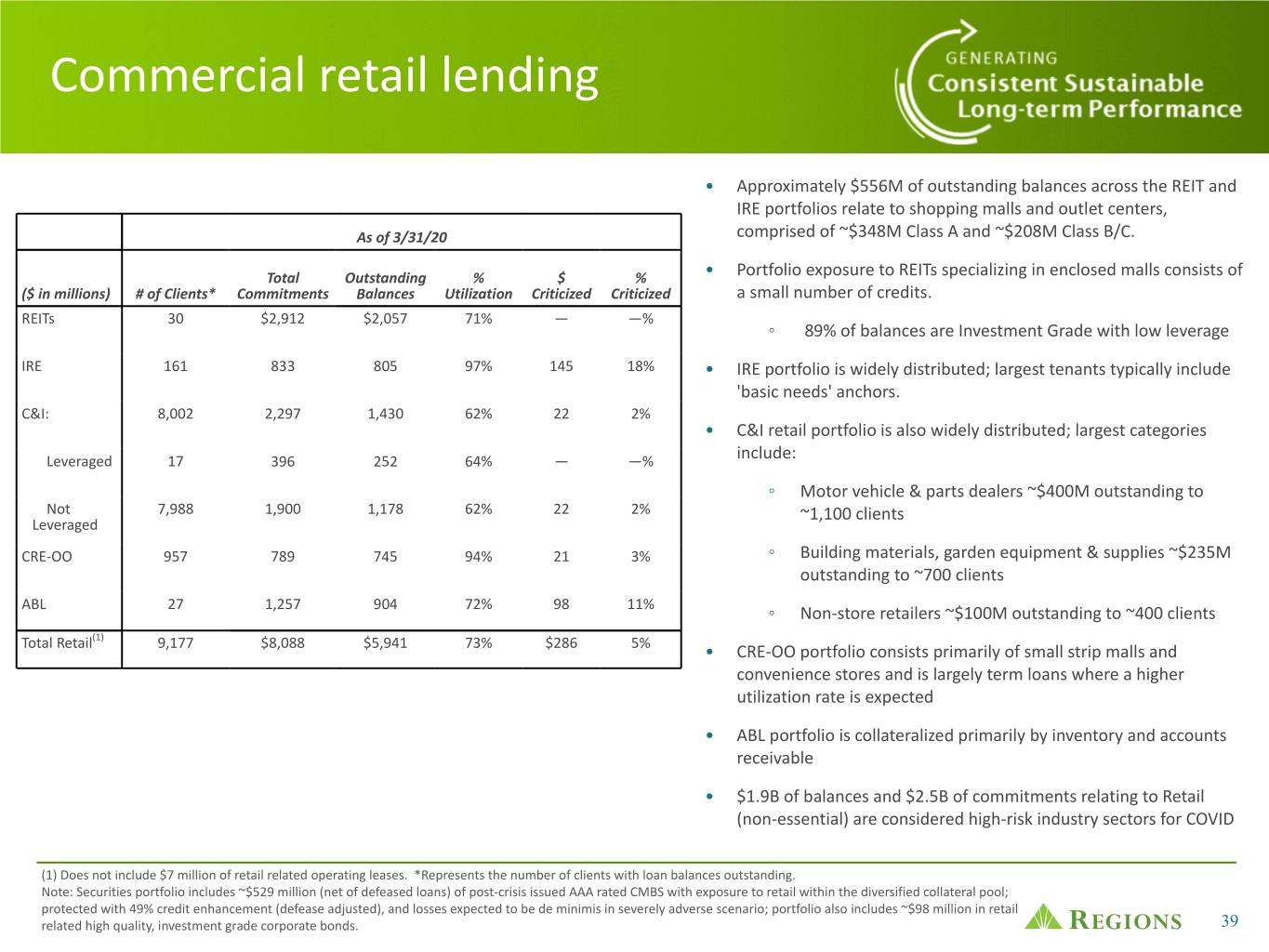
Commercial retail lending • Approximately $556M of outstanding balances across the REIT and IRE portfolios relate to shopping malls and outlet centers, As of 3/31/20 comprised of ~$348M Class A and ~$208M Class B/C. Total Outstanding % $ % • Portfolio exposure to REITs specializing in enclosed malls consists of ($ in millions) # of Clients* Commitments Balances Utilization Criticized Criticized a small number of credits. REITs 30 $2,912 $2,057 71% — —% ◦ 89% of balances are Investment Grade with low leverage IRE 161 833 805 53 97% 145 18% • IRE portfolio is widely distributed; largest tenants typically include 'basic needs' anchors. C&I: 8,002 2,297 1,430 62% 22 2% • C&I retail portfolio is also widely distributed; largest categories Leveraged 17 396 252 64% — —% include: ◦ Motor vehicle & parts dealers ~$400M outstanding to Not 7,988 1,900 1,178 62% 22 2% ~1,100 clients Leveraged CRE-OO 957 789 745 94% 21 3% ◦ Building materials, garden equipment & supplies ~$235M outstanding to ~700 clients ABL 27 1,257 904 72% 98 11% ◦ Non-store retailers ~$100M outstanding to ~400 clients (1) Total Retail 9,177 $8,088 $5,941 73% $286 5% • CRE-OO portfolio consists primarily of small strip malls and convenience stores and is largely term loans where a higher utilization rate is expected • ABL portfolio is collateralized primarily by inventory and accounts receivable • $1.9B of balances and $2.5B of commitments relating to Retail (non-essential) are considered high-risk industry sectors for COVID (1) Does not include $7 million of retail related operating leases. *Represents the number of clients with loan balances outstanding. Note: Securities portfolio includes ~$529 million (net of defeased loans) of post-crisis issued AAA rated CMBS with exposure to retail within the diversified collateral pool; protected with 49% credit enhancement (defease adjusted), and losses expected to be de minimis in severely adverse scenario; portfolio also includes ~$98 million in retail related high quality, investment grade corporate bonds. 39
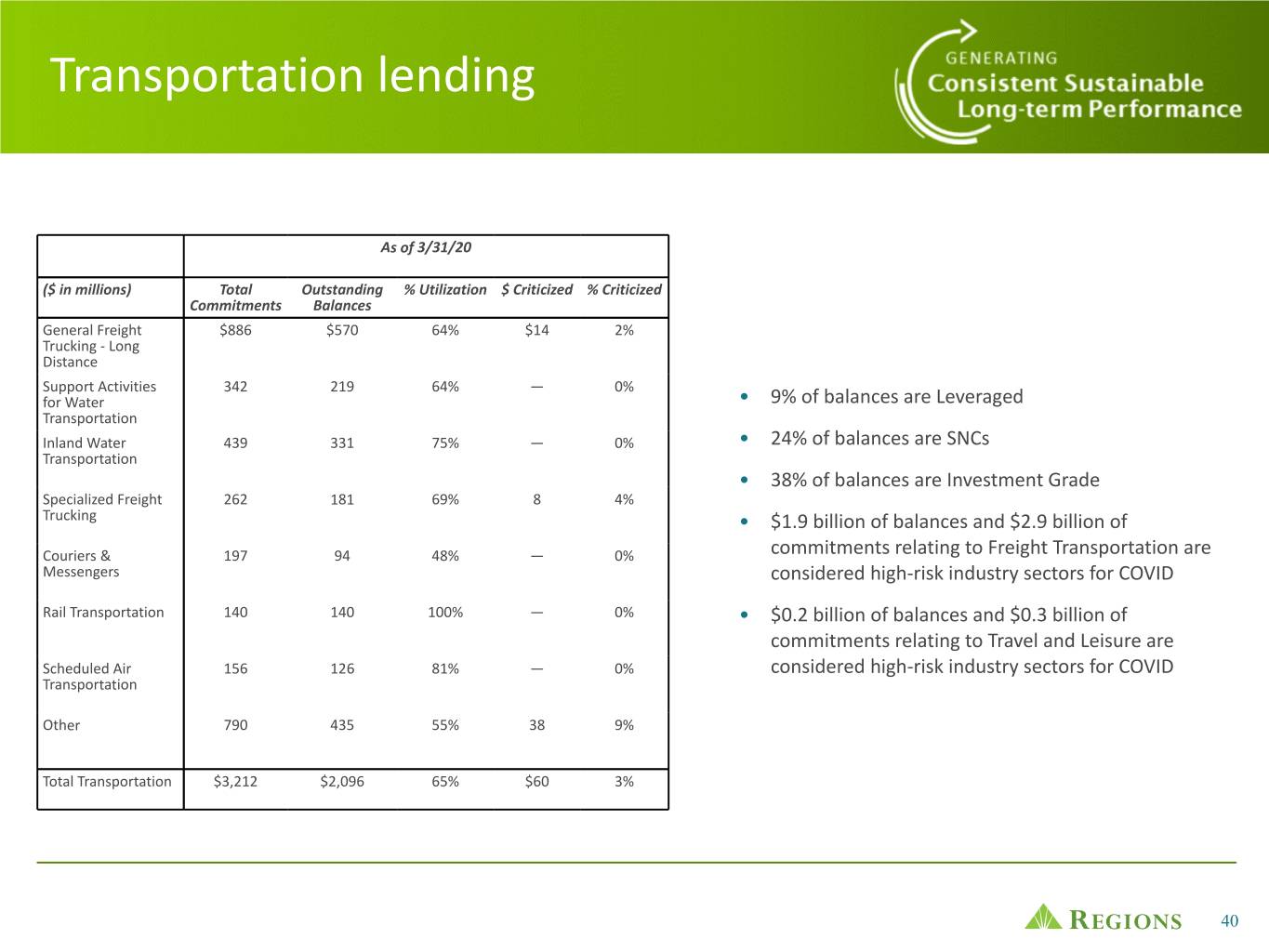
Transportation lending As of 3/31/20 ($ in millions) Total Outstanding % Utilization $ Criticized % Criticized Commitments Balances General Freight $886 $570 64% $14 2% Trucking - Long Distance 53 Support Activities 342 219 64% — 0% for Water • 9% of balances are Leveraged Transportation Inland Water 439 331 75% — 0% • 24% of balances are SNCs Transportation • 38% of balances are Investment Grade Specialized Freight 262 181 69% 8 4% Trucking • $1.9 billion of balances and $2.9 billion of Couriers & 197 94 48% — 0% commitments relating to Freight Transportation are Messengers considered high-risk industry sectors for COVID Rail Transportation 140 140 100% — 0% • $0.2 billion of balances and $0.3 billion of commitments relating to Travel and Leisure are Scheduled Air 156 126 81% — 0% considered high-risk industry sectors for COVID Transportation Other 790 435 55% 38 9% Total Transportation $3,212 $2,096 65% $60 3% 40

Loans to Small Business and Small Farms (outstanding balances as of March 31, 2020) Balances by Industry Balances by State Healthcare 14% Real Estate 13% Florida 35% 14% Professional, Alabama 13% Scientific & 27% 35% Technical Tennessee 12% 13% 45% Services 10% $4.5B Georgia 7% Retail Trade 9% $4.5B 10% 6% Texas 6% Religious, 9% 7% 9% Leisure 9% 13% Other 27% 12% (States <6% of Other 45% total) (Portfolios <8% of total) Portfolio Characteristics • Loans to Small Businesses are loans with original amounts of $1 million or less while Loans to Small Farms are loans with original amounts of $500 thousand or less • Includes $248 million of the $805 million SBA loans Loans to Small Business and Small Farms are defined consistent with the RC-C, Part II Call Report Instructions Does not include $1 million of HFS 41

SBA loans (outstanding balances as of March 31, 2020) Balances by Industry Balances by State Manufacturing 15% Retail Trade 13% Florida 32% 15% Restaurant, 25% Texas 17% Accommodation 31% 32% & Lodging 12% Georgia 11% 13% Religious, $805M Alabama 8% Leisure 11% $805M 7% 12% 9% Arkansas 7% Real Estate 9% 8% 9% 11% 17% Other 25% Healthcare 9% 11% (States <6% of total) Other 31% (Portfolios <9% of total) Portfolio Characteristics • 68% are 7(a) Program Loans; 30% are 504 Program Loans • $248 million fall into the Loans to Small Business and Small Farms definition • 70% are wholly or partially guaranteed by the US Government The 7(a) Program loans can be used to buy a business or obtain working capital. The 504 Program loans provide commercial real estate financing for owner-occupied properties. Loans to Small Business and Small Farms are defined consistent with the RC-C, Part II Call Report Instructions 42 Does not include $2 million of HFS
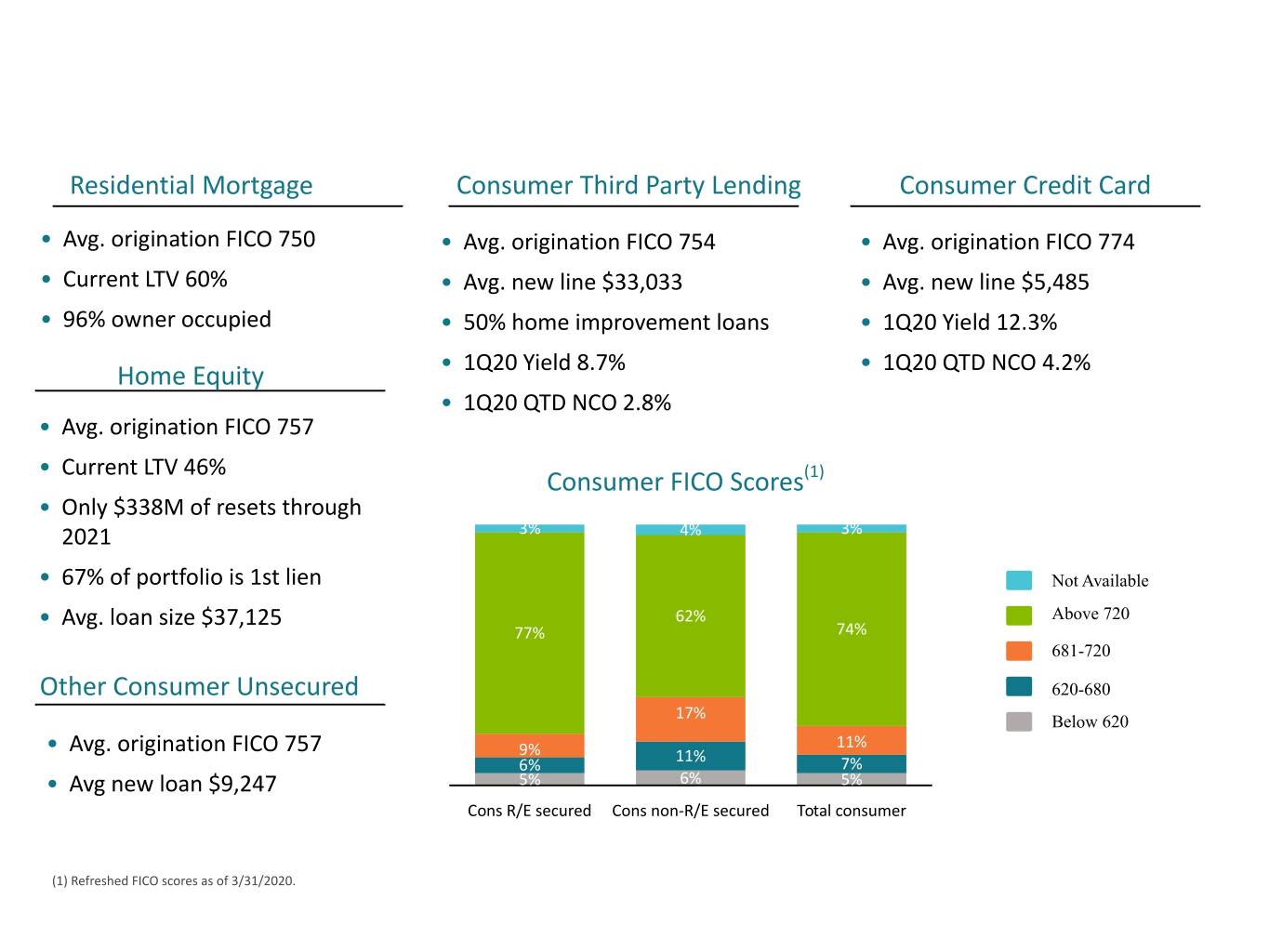
Consumer lending portfolio statistics Residential Mortgage Consumer Third Party Lending Consumer Credit Card • Avg. origination FICO 750 • Avg. origination FICO 754 • Avg. origination FICO 774 • Current LTV 60% • Avg. new line $33,033 • Avg. new line $5,485 • 96% owner occupied • 50% home improvement loans • 1Q20 Yield 12.3% Home Equity • 1Q20 Yield 8.7% • 1Q20 QTD NCO 4.2% • 1Q20 QTD NCO 2.8% • Avg. origination FICO 757 • Current LTV 46% Consumer FICO Scores(1) • Only $338M of resets through 2021 3% 4% 3% • 67% of portfolio is 1st lien Not Available • Avg. loan size $37,125 62% Above 720 77% 74% 681-720 Other Consumer Unsecured 620-680 17% Below 620 11% • Avg. origination FICO 757 9% 11% 6% 7% • Avg new loan $9,247 5% 6% 5% Cons R/E secured Cons non-R/E secured Total consumer (1) Refreshed FICO scores as of 3/31/2020.
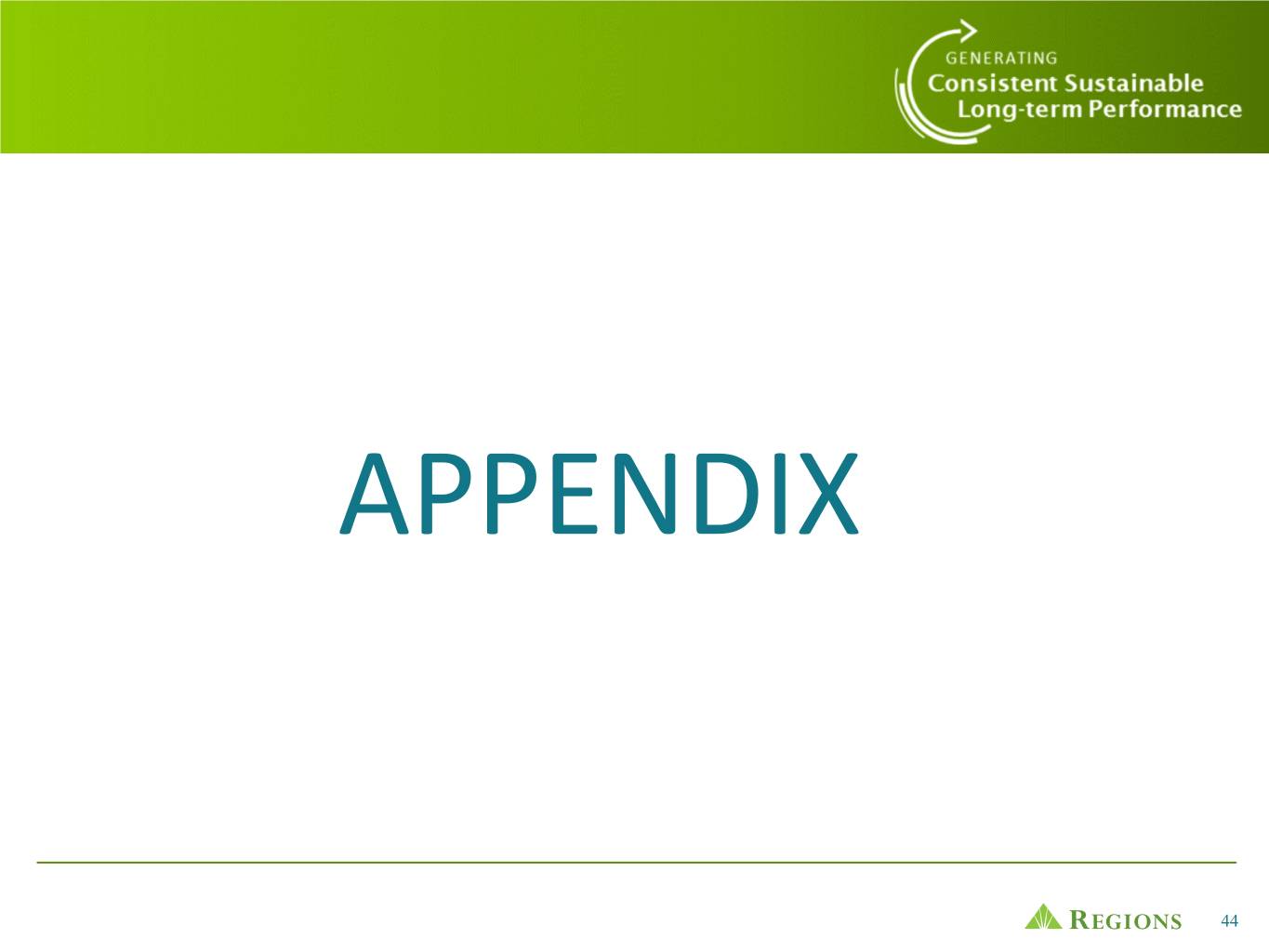
APPENDIX 44

Footprint economic advantages source references Fact Source Bureau of Labor Statistics. "Employment, Hours, and Earnings from the Current Employment Statistics Survey." Databases, Tables & Calculators by Subject, 18 Feb. 2020, data.bls.gov/ Job Growth timeseries/CES0000000001. Accessed 18 Feb. 2020. Data Access and Dissemination Systems (DADS). "U.S. Census Bureau Population Estimates." Census.gov, https://factfinder.census.gov/faces/tableservices/jsf/pages/productview.xhtml? Population Growth pid=PEP_2018_PEPANNRES&src=pt. Accessed 18 Feb. 2020. 6 of top 10 states where retirees are Smartasset. "Where Are Retirees Moving ?." SmartAsset, 21 Aug. 2019, https:// moving in footprint smartasset.com/retirement/where-are-retirees-moving#q=where. Accessed 13 Feb. 2020. Staff, BF. “Business Facilities' 15th Annual Rankings: State Rankings Report.” Business Alabama - Top five economic growth Facilities - Area Economic Development, Site Selection &amp;amp; Workforce Solutions, potential 26 July 2019, businessfacilities.com/2019/07/business-facilities-15th-annual-rankings-state- Global Trade Staff. "https://www.globaltrademag.com/top-10-states-for- Tennessee - #1 state growth for manufacturing-2019/." Global Trade Magazine, 02 Sept. 2019, htl.li/LSQT30lo2Nd. Accessed advanced manufacturing 13 Feb. 2020. Louisiana Economic Development. "LED Awards & Recognition | Louisiana Economic Louisiana - #1 state for workforce Development." LED | Louisiana Economic Development, https:// training in footprint www.opportunitylouisiana.com/about-led/awards. Accessed 13 Feb. 2020. Geraldine Gambale, Editor, Area Development Magazine, and Steve Kaelble, Staff Editor, Area Georgia - #1 state for doing business Development. "2019 Top States for Doing Business: Georgia Ranks #1 Sixth Year in a Row." in footprint Area Development, Sept. 2019, https://www.areadevelopment.com/Top-States-for-Doing- GDP by Footprint “GDP by State.” U.S. Bureau of Economic Analysis (BEA), www.bea.gov/data/gdp/gdp-state. Florida's 2nd best economy in the Enterprise Florida. "Florida The Future is Here." Enterprise Florida, U.S. www.enterpriseflorida.com/thefutureishere/. Accessed 13 Feb. 2020. Note: Source references to "Our footprint has significant economic advantages" slide included in the "Profile and Strategy" section of this presentation. 45
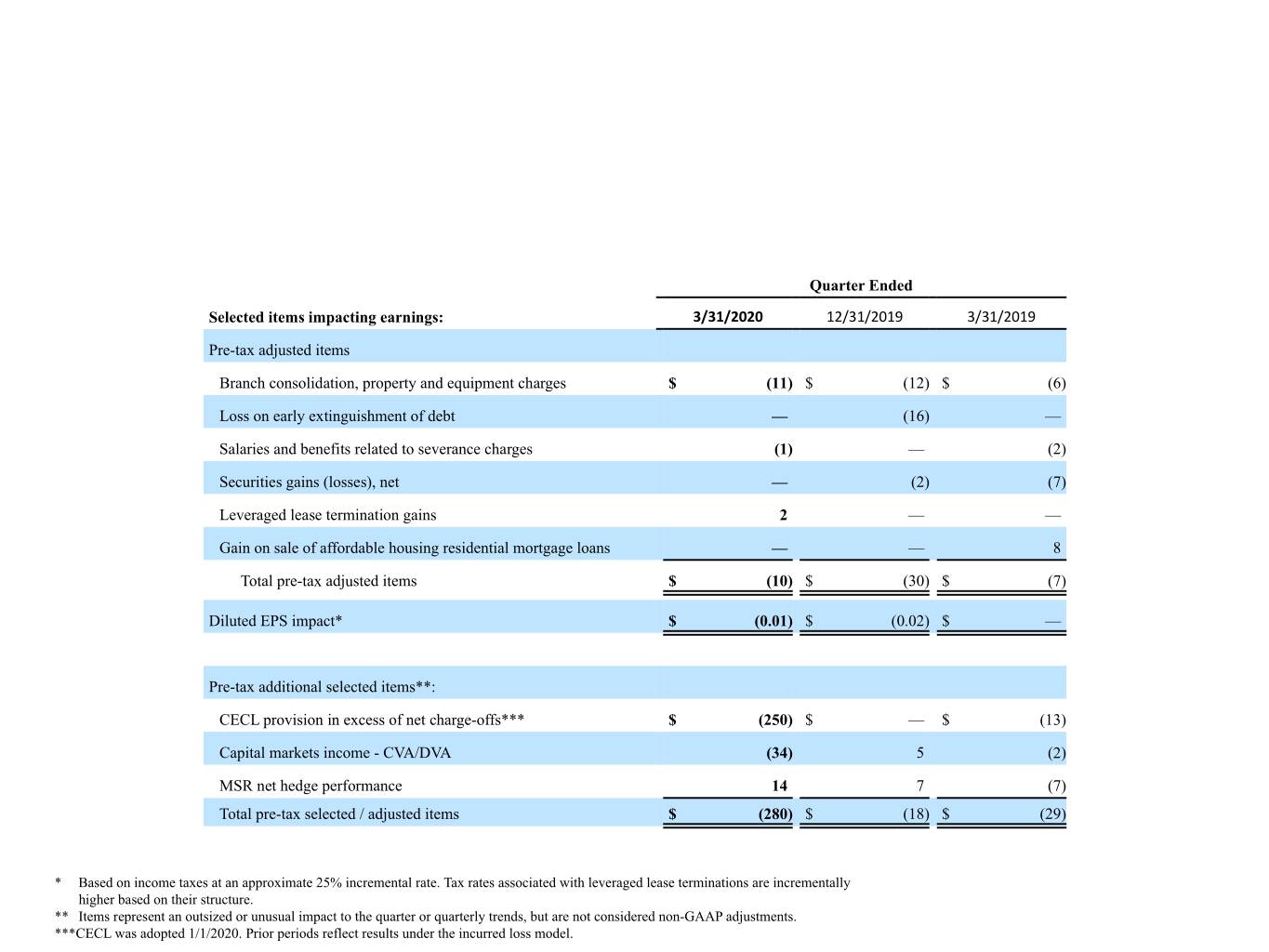
Non-GAAP and additional selected items impacting earnings Quarter Ended Selected items impacting earnings: 3/31/2020 12/31/2019 3/31/2019 Pre-tax adjusted items Branch consolidation, property and equipment charges $ (11) $ (12) $ (6) Loss on early extinguishment of debt — (16) — Salaries and benefits related to severance charges (1) — (2) Securities gains (losses), net — (2) (7) Leveraged lease termination gains 2 — — Gain on sale of affordable housing residential mortgage loans — — 8 Total pre-tax adjusted items $ (10) $ (30) $ (7) Diluted EPS impact* $ (0.01) $ (0.02) $ — Pre-tax additional selected items**: CECL provision in excess of net charge-offs*** $ (250) $ — $ (13) Capital markets income - CVA/DVA (34) 5 (2) MSR net hedge performance 14 7 (7) Total pre-tax selected / adjusted items $ (280) $ (18) $ (29) * Based on income taxes at an approximate 25% incremental rate. Tax rates associated with leveraged lease terminations are incrementally higher based on their structure. ** Items represent an outsized or unusual impact to the quarter or quarterly trends, but are not considered non-GAAP adjustments. ***CECL was adopted 1/1/2020. Prior periods reflect results under the incurred loss model.
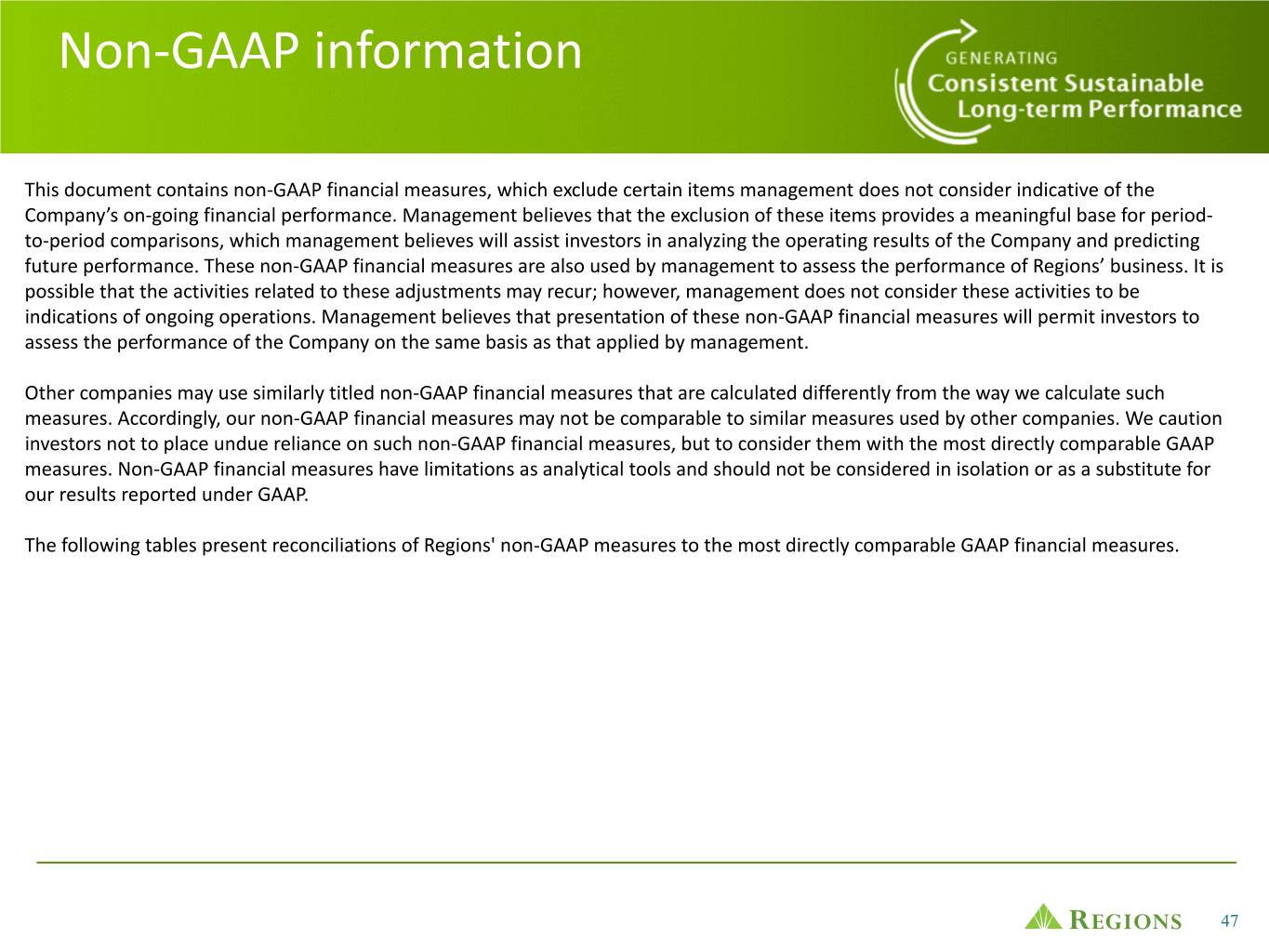
Non-GAAP information This document contains non-GAAP financial measures, which exclude certain items management does not consider indicative of the Company’s on-going financial performance. Management believes that the exclusion of these items provides a meaningful base for period- to-period comparisons, which management believes will assist investors in analyzing the operating results of the Company and predicting future performance. These non-GAAP financial measures are also used by management to assess the performance of Regions’ business. It is possible that the activities related to these adjustments may recur; however, management does not consider these activities to be indications of ongoing operations. Management believes that presentation of these non-GAAP financial measures will permit investors to assess the performance of the Company on the same basis as that applied by management. Other companies may use similarly titled non-GAAP financial measures that are calculated differently from the way we calculate such measures. Accordingly, our non-GAAP financial measures may not be comparable to similar measures used by other companies. We caution investors not to place undue reliance on such non-GAAP financial measures, but to consider them with the most directly comparable GAAP measures. Non-GAAP financial measures have limitations as analytical tools and should not be considered in isolation or as a substitute for our results reported under GAAP. The following tables present reconciliations of Regions' non-GAAP measures to the most directly comparable GAAP financial measures. 47
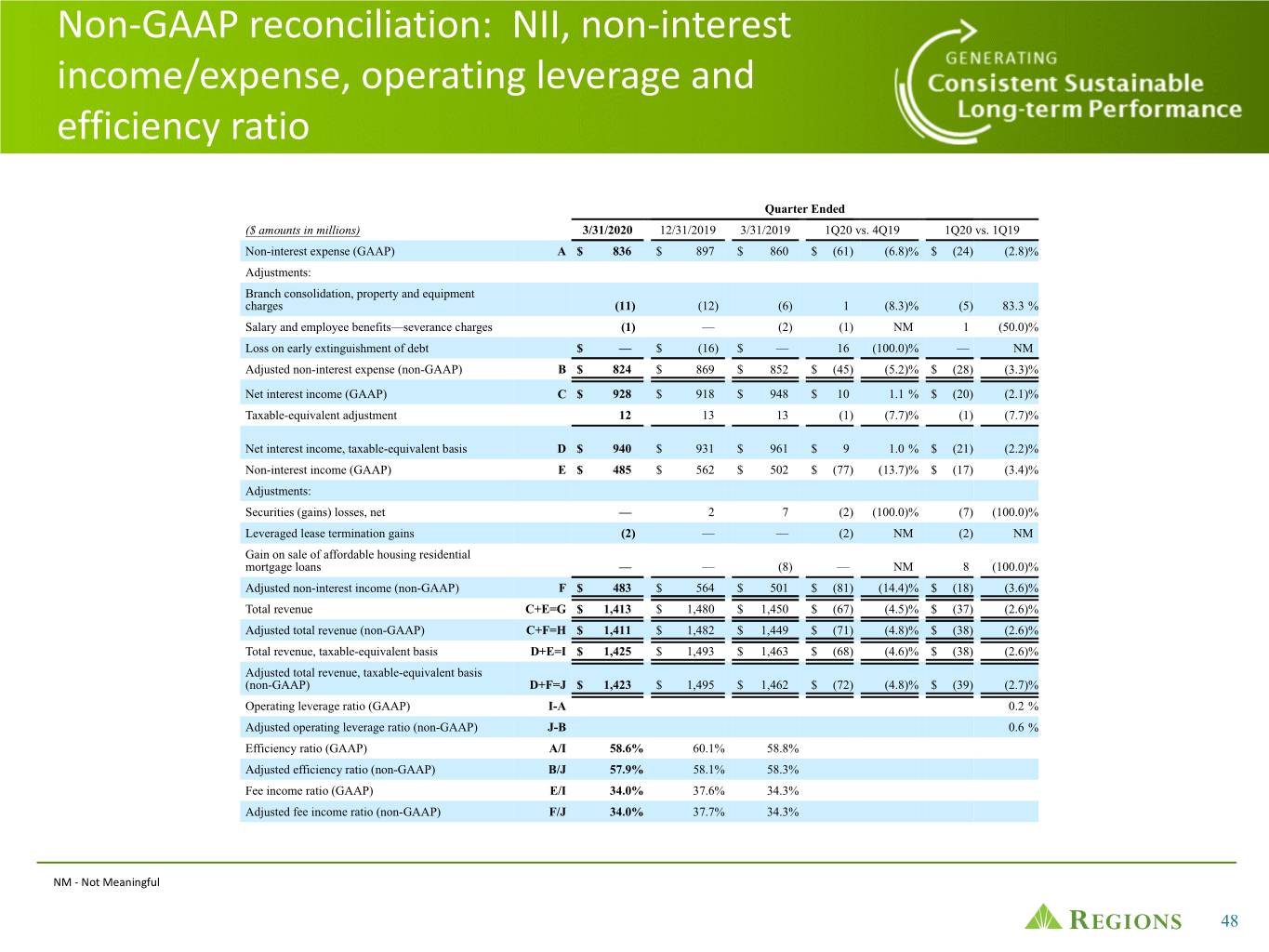
Non-GAAP reconciliation: NII, non-interest income/expense, operating leverage and efficiency ratio Quarter Ended ($ amounts in millions) 3/31/2020 12/31/2019 3/31/2019 1Q20 vs. 4Q19 1Q20 vs. 1Q19 Non-interest expense (GAAP) A $ 836 $ 897 $ 860 $ (61) (6.8)% $ (24) (2.8)% Adjustments: Branch consolidation, property and equipment charges (11) (12) (6) 1 (8.3)% (5) 83.3 % Salary and employee benefits—severance charges (1) — (2) (1) NM 1 (50.0)% Loss on early extinguishment of debt $ — $ (16) $ — 16 (100.0)% — NM Adjusted non-interest expense (non-GAAP) B $ 824 $ 869 $ 852 $ (45) (5.2)% $ (28) (3.3)% Net interest income (GAAP) C $ 928 $ 918 $ 948 $ 10 1.1 % $ (20) (2.1)% Taxable-equivalent adjustment 12 13 13 (1) (7.7)% (1) (7.7)% Net interest income, taxable-equivalent basis D $ 940 $ 931 $ 961 $ 9 1.0 % $ (21) (2.2)% Non-interest income (GAAP) E $ 485 $ 562 $ 502 $ (77) (13.7)% $ (17) (3.4)% Adjustments: Securities (gains) losses, net — 2 7 (2) (100.0)% (7) (100.0)% Leveraged lease termination gains (2) — — (2) NM (2) NM Gain on sale of affordable housing residential mortgage loans — — (8) — NM 8 (100.0)% Adjusted non-interest income (non-GAAP) F $ 483 $ 564 $ 501 $ (81) (14.4)% $ (18) (3.6)% Total revenue C+E=G $ 1,413 $ 1,480 $ 1,450 $ (67) (4.5)% $ (37) (2.6)% Adjusted total revenue (non-GAAP) C+F=H $ 1,411 $ 1,482 $ 1,449 $ (71) (4.8)% $ (38) (2.6)% Total revenue, taxable-equivalent basis D+E=I $ 1,425 $ 1,493 $ 1,463 $ (68) (4.6)% $ (38) (2.6)% Adjusted total revenue, taxable-equivalent basis (non-GAAP) D+F=J $ 1,423 $ 1,495 $ 1,462 $ (72) (4.8)% $ (39) (2.7)% Operating leverage ratio (GAAP) I-A 0.2 % Adjusted operating leverage ratio (non-GAAP) J-B 0.6 % Efficiency ratio (GAAP) A/I 58.6% 60.1% 58.8% Adjusted efficiency ratio (non-GAAP) B/J 57.9% 58.1% 58.3% Fee income ratio (GAAP) E/I 34.0% 37.6% 34.3% Adjusted fee income ratio (non-GAAP) F/J 34.0% 37.7% 34.3% NM - Not Meaningful 48

Non-GAAP reconciliation: adjusted average loans Average Balances ($ amounts in millions) 1Q20 4Q19 1Q19 1Q20 vs. 4Q19 1Q20 vs. 1Q19 Total consumer loans $ 30,250 $ 30,418 $ 31,207 $ (168) (0.6)% $ (957) (3.1)% Less: Indirect—vehicles 1,679 1,948 2,924 (269) (13.8)% (1,245) (42.6)% Adjusted total consumer loans (non-GAAP) $ 28,571 $ 28,470 $ 28,283 $ 101 0.4 % $ 288 1.0 % Total loans $ 83,249 $ 82,392 $ 83,725 $ 857 1.0 % $ (476) (0.6)% Less: Indirect—vehicles 1,679 1,948 2,924 (269) (13.8)% (1,245) (42.6)% Adjusted total loans (non-GAAP) $ 81,570 $ 80,444 $ 80,801 $ 1,126 1.4 % $ 769 1.0 % NM - Not Meaningful 49
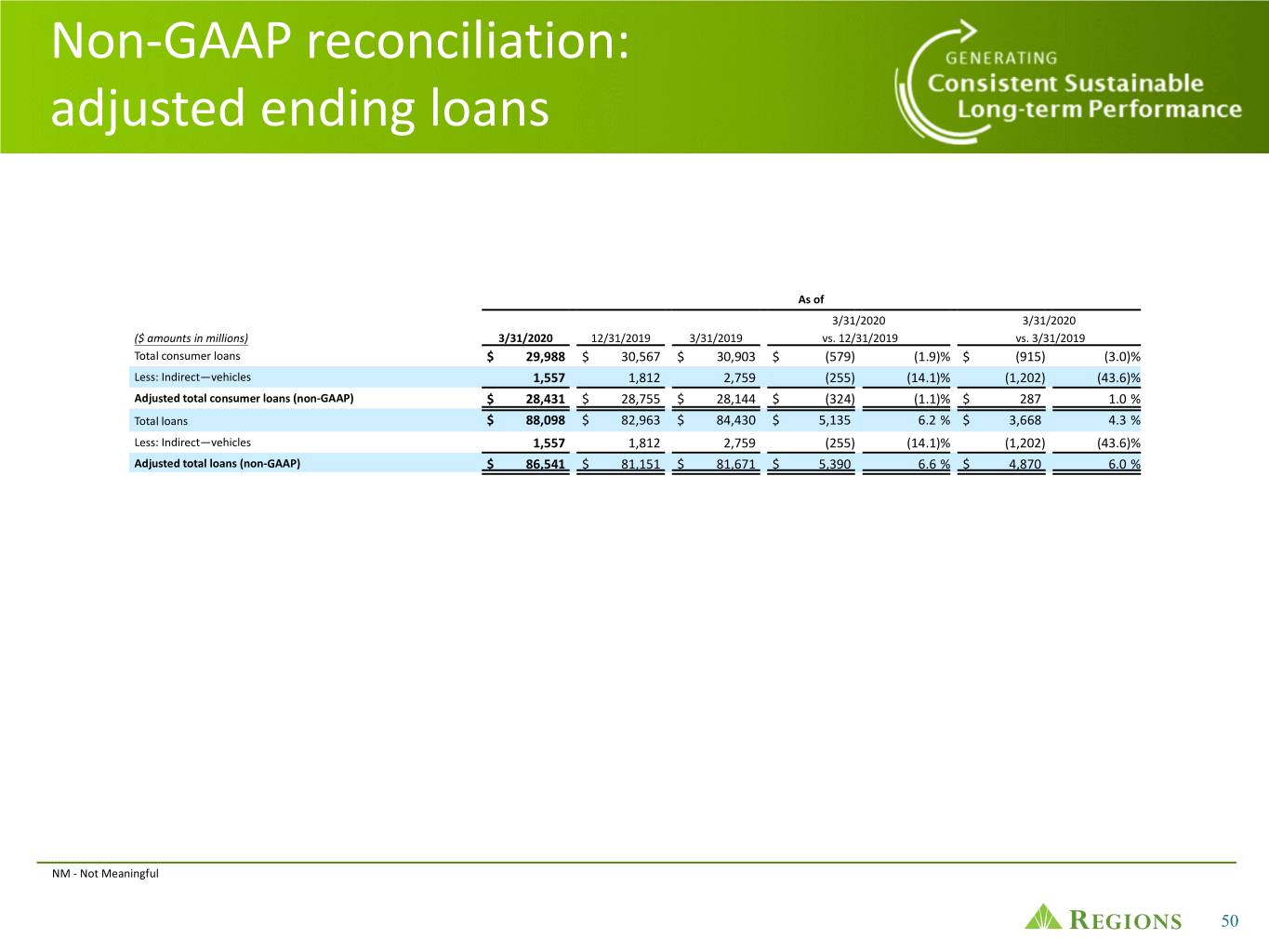
Non-GAAP reconciliation: adjusted ending loans As of 3/31/2020 3/31/2020 ($ amounts in millions) 3/31/2020 12/31/2019 3/31/2019 vs. 12/31/2019 vs. 3/31/2019 Total consumer loans $ 29,988 $ 30,567 $ 30,903 $ (579) (1.9)% $ (915) (3.0)% Less: Indirect—vehicles 1,557 1,812 2,759 (255) (14.1)% (1,202) (43.6)% Adjusted total consumer loans (non-GAAP) $ 28,431 $ 28,755 $ 28,144 $ (324) (1.1)% $ 287 1.0 % Total loans $ 88,098 $ 82,963 $ 84,430 $ 5,135 6.2 % $ 3,668 4.3 % Less: Indirect—vehicles 1,557 1,812 2,759 (255) (14.1)% (1,202) (43.6)% Adjusted total loans (non-GAAP) $ 86,541 $ 81,151 $ 81,671 $ 5,390 6.6 % $ 4,870 6.0 % NM - Not Meaningful 50
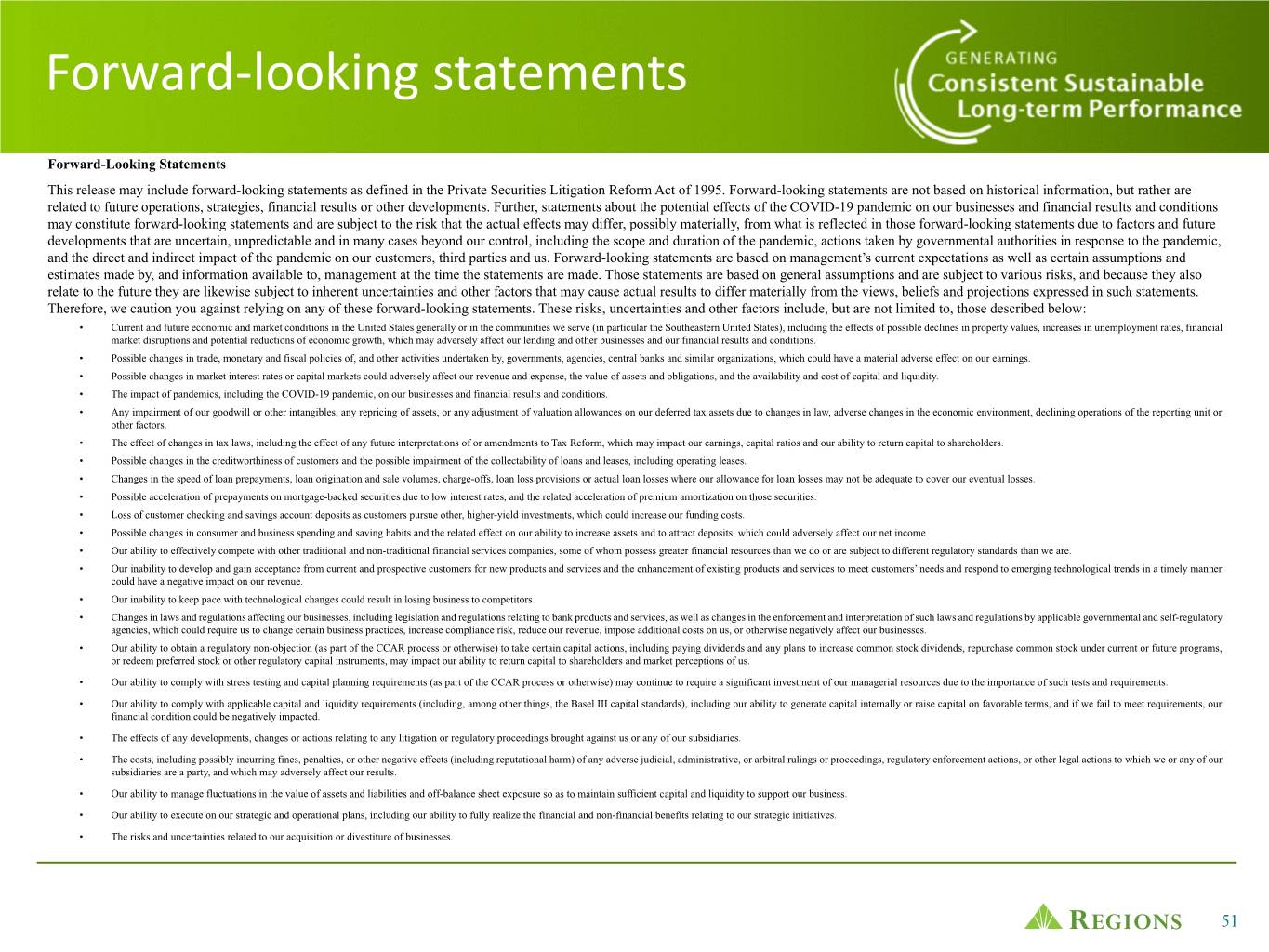
Forward-looking statements Forward-Looking Statements This release may include forward-looking statements as defined in the Private Securities Litigation Reform Act of 1995. Forward-looking statements are not based on historical information, but rather are related to future operations, strategies, financial results or other developments. Further, statements about the potential effects of the COVID-19 pandemic on our businesses and financial results and conditions may constitute forward-looking statements and are subject to the risk that the actual effects may differ, possibly materially, from what is reflected in those forward-looking statements due to factors and future developments that are uncertain, unpredictable and in many cases beyond our control, including the scope and duration of the pandemic, actions taken by governmental authorities in response to the pandemic, and the direct and indirect impact of the pandemic on our customers, third parties and us. Forward-looking statements are based on management’s current expectations as well as certain assumptions and estimates made by, and information available to, management at the time the statements are made. Those statements are based on general assumptions and are subject to various risks, and because they also relate to the future they are likewise subject to inherent uncertainties and other factors that may cause actual results to differ materially from the views, beliefs and projections expressed in such statements. Therefore, we caution you against relying on any of these forward-looking statements. These risks, uncertainties and other factors include, but are not limited to, those described below: • Current and future economic and market conditions in the United States generally or in the communities we serve (in particular the Southeastern United States), including the effects of possible declines in property values, increases in unemployment rates, financial market disruptions and potential reductions of economic growth, which may adversely affect our lending and other businesses and our financial results and conditions. • Possible changes in trade, monetary and fiscal policies of, and other activities undertaken by, governments, agencies, central banks and similar organizations, which could have a material adverse effect on our earnings. • Possible changes in market interest rates or capital markets could adversely affect our revenue and expense, the value of assets and obligations, and the availability and cost of capital and liquidity. • The impact of pandemics, including the COVID-19 pandemic, on our businesses and financial results and conditions. • Any impairment of our goodwill or other intangibles, any repricing of assets, or any adjustment of valuation allowances on our deferred tax assets due to changes in law, adverse changes in the economic environment, declining operations of the reporting unit or other factors. • The effect of changes in tax laws, including the effect of any future interpretations of or amendments to Tax Reform, which may impact our earnings, capital ratios and our ability to return capital to shareholders. • Possible changes in the creditworthiness of customers and the possible impairment of the collectability of loans and leases, including operating leases. • Changes in the speed of loan prepayments, loan origination and sale volumes, charge-offs, loan loss provisions or actual loan losses where our allowance for loan losses may not be adequate to cover our eventual losses. • Possible acceleration of prepayments on mortgage-backed securities due to low interest rates, and the related acceleration of premium amortization on those securities. • Loss of customer checking and savings account deposits as customers pursue other, higher-yield investments, which could increase our funding costs. • Possible changes in consumer and business spending and saving habits and the related effect on our ability to increase assets and to attract deposits, which could adversely affect our net income. • Our ability to effectively compete with other traditional and non-traditional financial services companies, some of whom possess greater financial resources than we do or are subject to different regulatory standards than we are. • Our inability to develop and gain acceptance from current and prospective customers for new products and services and the enhancement of existing products and services to meet customers’ needs and respond to emerging technological trends in a timely manner could have a negative impact on our revenue. • Our inability to keep pace with technological changes could result in losing business to competitors. • Changes in laws and regulations affecting our businesses, including legislation and regulations relating to bank products and services, as well as changes in the enforcement and interpretation of such laws and regulations by applicable governmental and self-regulatory agencies, which could require us to change certain business practices, increase compliance risk, reduce our revenue, impose additional costs on us, or otherwise negatively affect our businesses. • Our ability to obtain a regulatory non-objection (as part of the CCAR process or otherwise) to take certain capital actions, including paying dividends and any plans to increase common stock dividends, repurchase common stock under current or future programs, or redeem preferred stock or other regulatory capital instruments, may impact our ability to return capital to shareholders and market perceptions of us. • Our ability to comply with stress testing and capital planning requirements (as part of the CCAR process or otherwise) may continue to require a significant investment of our managerial resources due to the importance of such tests and requirements. • Our ability to comply with applicable capital and liquidity requirements (including, among other things, the Basel III capital standards), including our ability to generate capital internally or raise capital on favorable terms, and if we fail to meet requirements, our financial condition could be negatively impacted. • The effects of any developments, changes or actions relating to any litigation or regulatory proceedings brought against us or any of our subsidiaries. • The costs, including possibly incurring fines, penalties, or other negative effects (including reputational harm) of any adverse judicial, administrative, or arbitral rulings or proceedings, regulatory enforcement actions, or other legal actions to which we or any of our subsidiaries are a party, and which may adversely affect our results. • Our ability to manage fluctuations in the value of assets and liabilities and off-balance sheet exposure so as to maintain sufficient capital and liquidity to support our business. • Our ability to execute on our strategic and operational plans, including our ability to fully realize the financial and non-financial benefits relating to our strategic initiatives. • The risks and uncertainties related to our acquisition or divestiture of businesses. 51
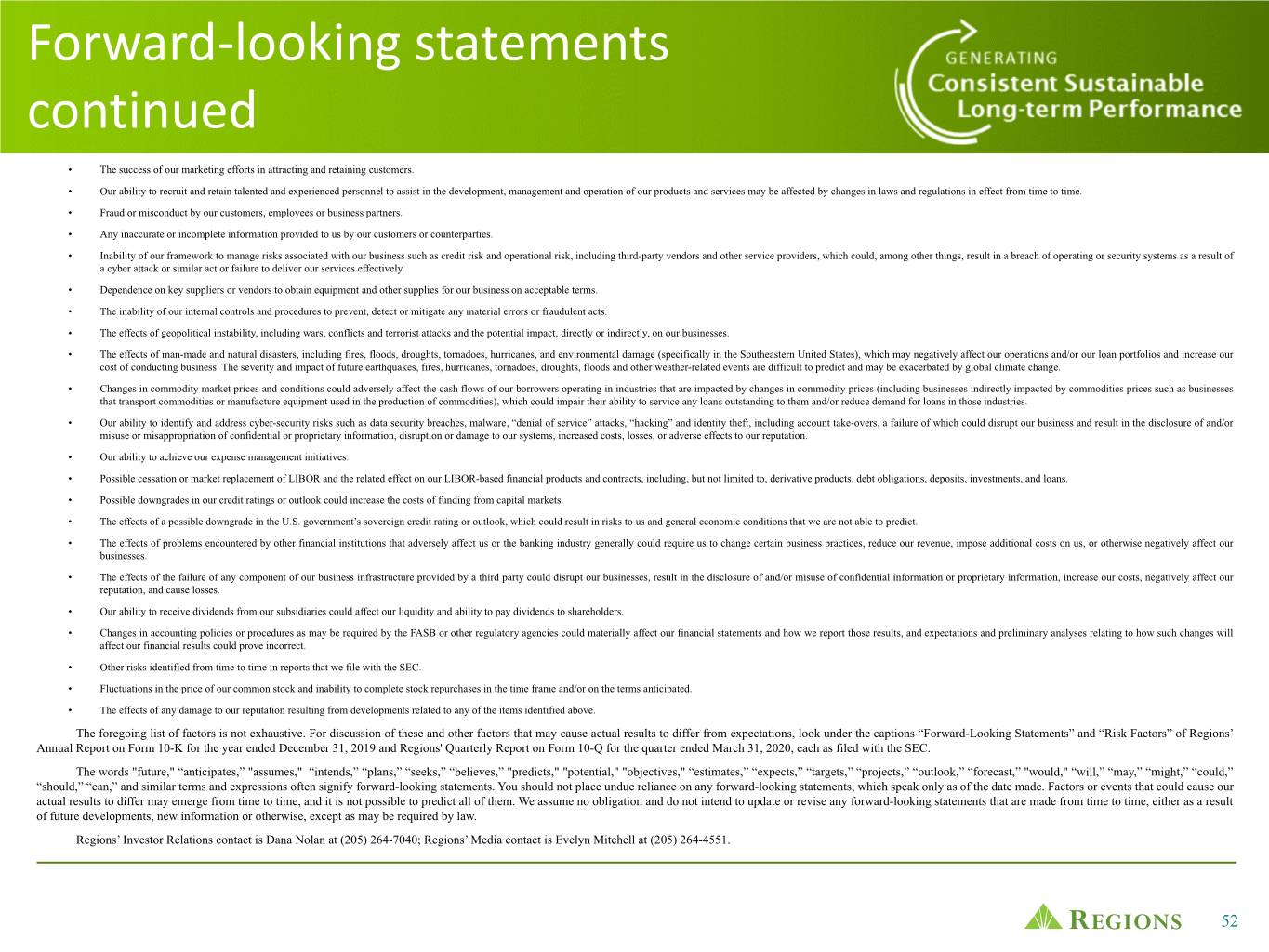
Forward-looking statements continued • The success of our marketing efforts in attracting and retaining customers. • Our ability to recruit and retain talented and experienced personnel to assist in the development, management and operation of our products and services may be affected by changes in laws and regulations in effect from time to time. • Fraud or misconduct by our customers, employees or business partners. • Any inaccurate or incomplete information provided to us by our customers or counterparties. • Inability of our framework to manage risks associated with our business such as credit risk and operational risk, including third-party vendors and other service providers, which could, among other things, result in a breach of operating or security systems as a result of a cyber attack or similar act or failure to deliver our services effectively. • Dependence on key suppliers or vendors to obtain equipment and other supplies for our business on acceptable terms. • The inability of our internal controls and procedures to prevent, detect or mitigate any material errors or fraudulent acts. • The effects of geopolitical instability, including wars, conflicts and terrorist attacks and the potential impact, directly or indirectly, on our businesses. • The effects of man-made and natural disasters, including fires, floods, droughts, tornadoes, hurricanes, and environmental damage (specifically in the Southeastern United States), which may negatively affect our operations and/or our loan portfolios and increase our cost of conducting business. The severity and impact of future earthquakes, fires, hurricanes, tornadoes, droughts, floods and other weather-related events are difficult to predict and may be exacerbated by global climate change. • Changes in commodity market prices and conditions could adversely affect the cash flows of our borrowers operating in industries that are impacted by changes in commodity prices (including businesses indirectly impacted by commodities prices such as businesses that transport commodities or manufacture equipment used in the production of commodities), which could impair their ability to service any loans outstanding to them and/or reduce demand for loans in those industries. • Our ability to identify and address cyber-security risks such as data security breaches, malware, “denial of service” attacks, “hacking” and identity theft, including account take-overs, a failure of which could disrupt our business and result in the disclosure of and/or misuse or misappropriation of confidential or proprietary information, disruption or damage to our systems, increased costs, losses, or adverse effects to our reputation. • Our ability to achieve our expense management initiatives. • Possible cessation or market replacement of LIBOR and the related effect on our LIBOR-based financial products and contracts, including, but not limited to, derivative products, debt obligations, deposits, investments, and loans. • Possible downgrades in our credit ratings or outlook could increase the costs of funding from capital markets. • The effects of a possible downgrade in the U.S. government’s sovereign credit rating or outlook, which could result in risks to us and general economic conditions that we are not able to predict. • The effects of problems encountered by other financial institutions that adversely affect us or the banking industry generally could require us to change certain business practices, reduce our revenue, impose additional costs on us, or otherwise negatively affect our businesses. • The effects of the failure of any component of our business infrastructure provided by a third party could disrupt our businesses, result in the disclosure of and/or misuse of confidential information or proprietary information, increase our costs, negatively affect our reputation, and cause losses. • Our ability to receive dividends from our subsidiaries could affect our liquidity and ability to pay dividends to shareholders. • Changes in accounting policies or procedures as may be required by the FASB or other regulatory agencies could materially affect our financial statements and how we report those results, and expectations and preliminary analyses relating to how such changes will affect our financial results could prove incorrect. • Other risks identified from time to time in reports that we file with the SEC. • Fluctuations in the price of our common stock and inability to complete stock repurchases in the time frame and/or on the terms anticipated. • The effects of any damage to our reputation resulting from developments related to any of the items identified above. The foregoing list of factors is not exhaustive. For discussion of these and other factors that may cause actual results to differ from expectations, look under the captions “Forward-Looking Statements” and “Risk Factors” of Regions’ Annual Report on Form 10-K for the year ended December 31, 2019 and Regions' Quarterly Report on Form 10-Q for the quarter ended March 31, 2020, each as filed with the SEC. The words "future," “anticipates,” "assumes," “intends,” “plans,” “seeks,” “believes,” "predicts," "potential," "objectives," “estimates,” “expects,” “targets,” “projects,” “outlook,” “forecast,” "would," “will,” “may,” “might,” “could,” “should,” “can,” and similar terms and expressions often signify forward-looking statements. You should not place undue reliance on any forward-looking statements, which speak only as of the date made. Factors or events that could cause our actual results to differ may emerge from time to time, and it is not possible to predict all of them. We assume no obligation and do not intend to update or revise any forward-looking statements that are made from time to time, either as a result of future developments, new information or otherwise, except as may be required by law. Regions’ Investor Relations contact is Dana Nolan at (205) 264-7040; Regions’ Media contact is Evelyn Mitchell at (205) 264-4551. 52
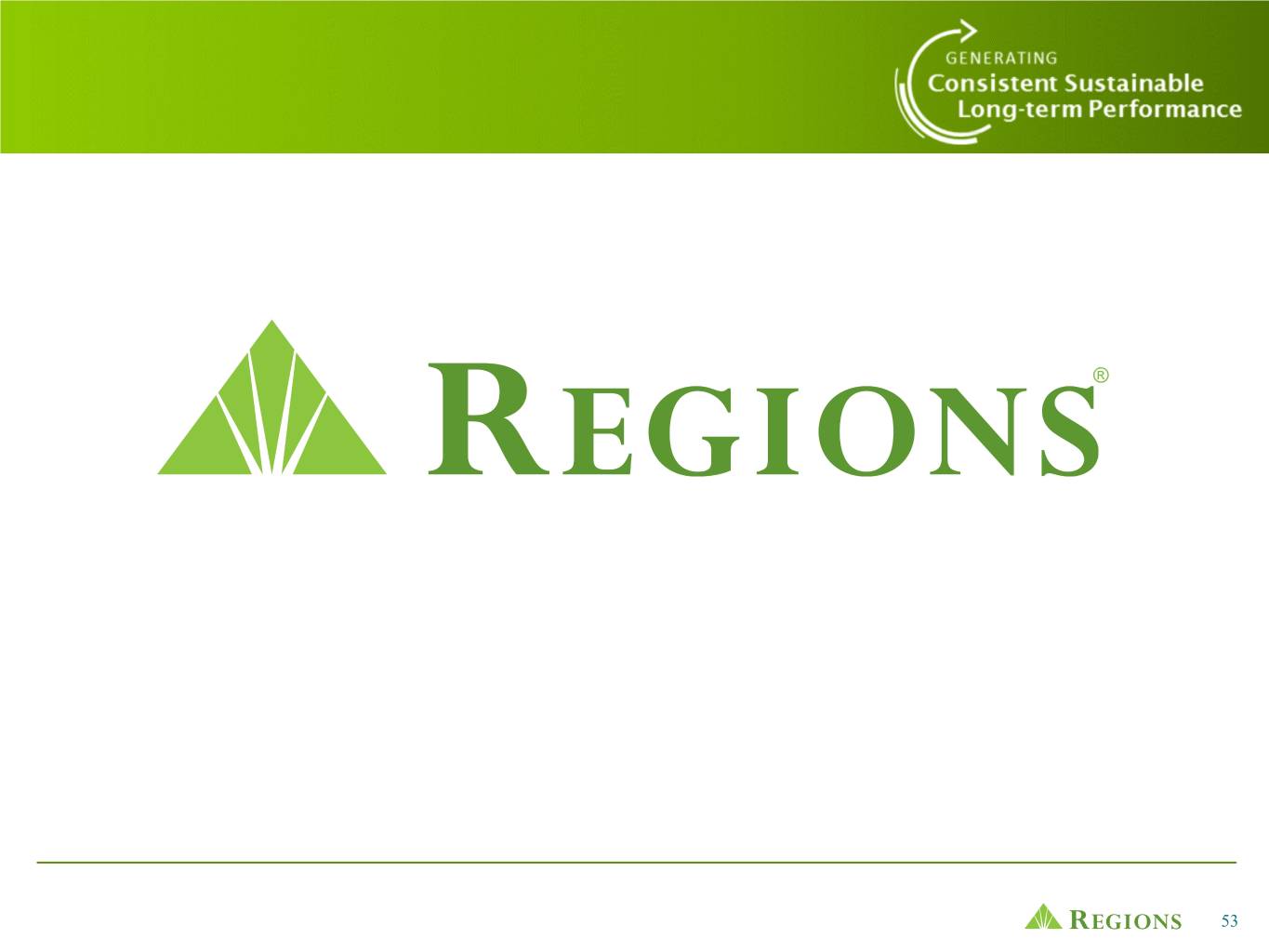
® 53




















































